
The Purposely Lost
- Get In Touch
- FREE Travel Planner
- Shop My Favorites

Find Lyndsay's Favorites

History Travel + Local Experiences
March 9, 2023 By Lyndsay
Best Time To Visit Croatia: Month To Month Breakdown (2024)
- 1.1 Best Time to Visit Croatia to Avoid Crowds
- 1.2 Best Time to Visit Croatia on a Budget
- 1.3 Best Time To Visit Croatia for the Beach
- 1.4 Best Time to Visit Croatia for Partying
- 1.5 Best Time to Visit Croatia for its National Parks
- 1.6 Best Time to Visit Croatia for its Festivals
- 1.7 Best Time To Visit Croatia For Sightseeing
- 2.1 January
- 2.2 February
- 2.9 September
- 2.10 October
- 2.11 November
- 2.12 December
- 3.1 Best Time to Visit Zagreb
- 3.2 Best Time to Visit Pula
- 3.3 Best Time to Visit Split
- 3.4 Best Time to Visit Dubrovnik
- 4 Weather in Croatia
- 5 Why visit Croatia?
- 6.1 What is the cheapest month to go to Croatia?
- 6.2 What is peak tourist time in Croatia?
- 6.3 What are Croatia’s hottest months?
- 7 Best Time To Visit Croatia: Wrap-Up
This post may contain affiliate links! I will receive a commission, at no extra cost to you, if you purchase something recommended here.
If you’re anything like me, you’re constantly seeking out your next adventure, craving the thrill of discovering new places and experiencing different cultures.
And let me tell you, Croatia is a country that should definitely be on your radar.
From the ancient cities of Split and Dubrovnik to the breathtaking Adriatic coastline, Croatia is a destination like no other.
With lively cities, stunning mountains, and secluded islands all in one country, it’s no surprise that Croatia has become a popular tourist destination.
But when is the best time to visit this Adriatic paradise?
As someone who loves to travel, I always want to make sure I’m getting the most out of my trips, and timing is a crucial factor in that.
So, I did my research and discovered that the best time to visit Croatia can depend on a few different factors, like weather, crowds, and events.
After spending several months exploring Croatia with a local family, here I’ll be sharing my insights and tips on when to visit Croatia based on my own experiences and those of my local friends.
Whether you’re looking for budget-friendly activities or want to experience some of Croatia’s exciting events and festivals, read on to find the best time to visit Croatia!

Grab your Travel Planner
Planning your next adventure can become overwhelming. Stay organized with this free, printable travel planner!
You can unsubscribe anytime. For more details, review our Privacy Policy.
You have successfully joined our subscriber list.
Overall Best Time To Visit Croatia
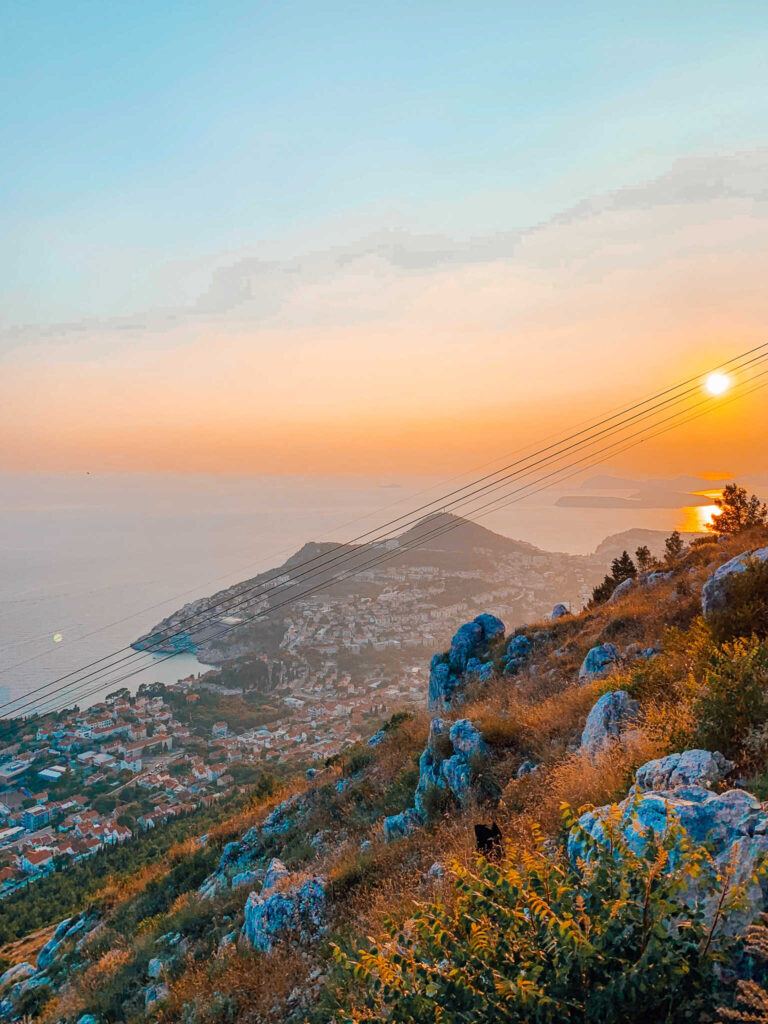
Croatia is a stunning destination; there’s no wrong time to visit this Mediterranean paradise.
However, if you’re looking for the best time to visit Croatia, the overall best time is during the shoulder seasons.
Between April and June or September and October, you’ll find the temperature is still warm enough to swim in the crystal-clear Adriatic Sea.
Still, you won’t be surrounded by the swarms of tourists that descend during summertime.
However, the best time to visit Croatia truly depends on your preferences.
Best Time to Visit Croatia to Avoid Crowds
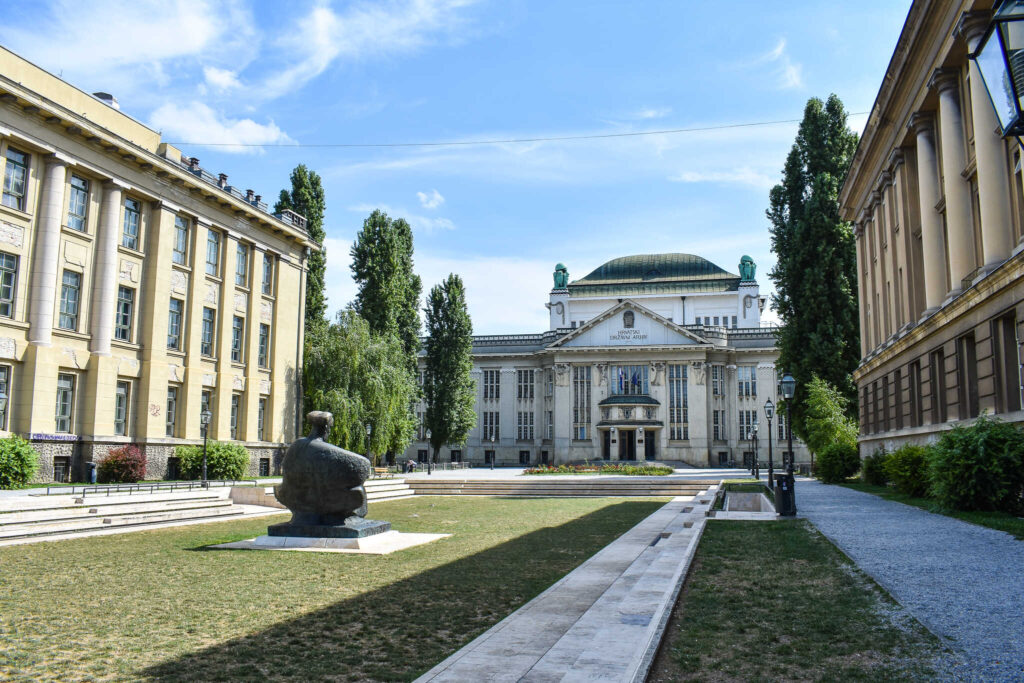
If you’re interested in experiencing Croatia without crowds, you must visit during the shoulder seasons.
The late spring and fall offer similar wonderful weather to the peak summer season.
Temperatures are still mild from April to May and September to November, and the tourist season has died down significantly.
This means you can experience Croatian culture more peacefully and authentically.
You’ll still be able to swim in the sea, hike through the national parks, and wander the historic cities–just with fewer tourists.
Best Time to Visit Croatia on a Budget
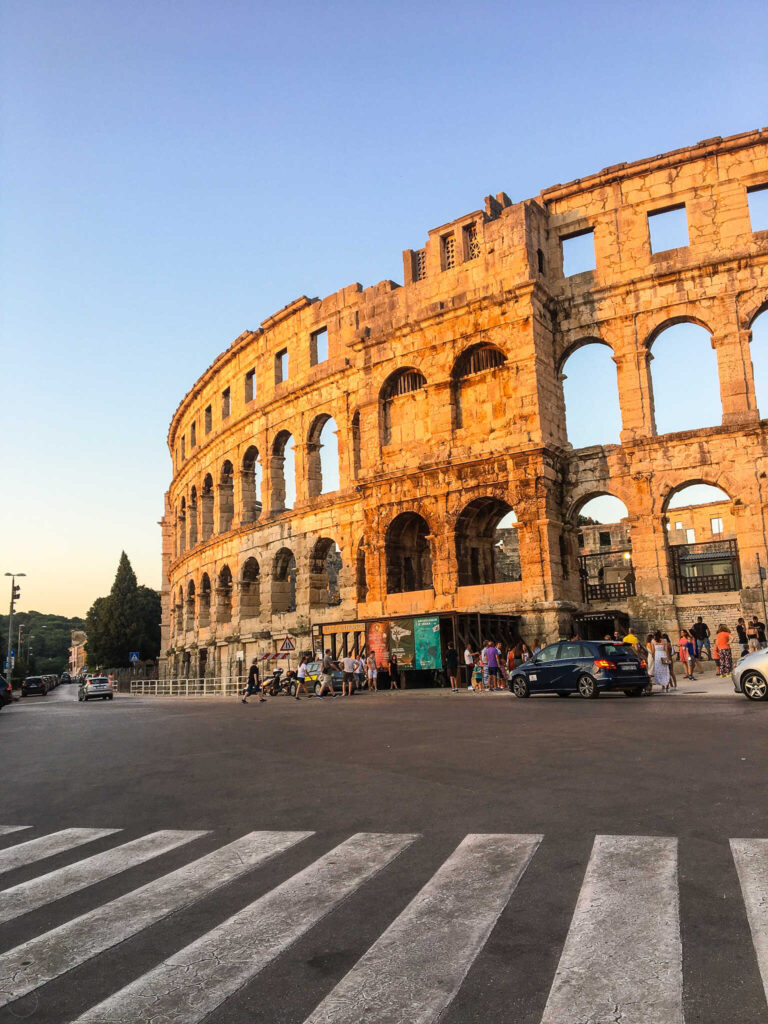
If you’re looking to explore Croatia on a budget, the best time to visit is in early spring or late fall.
From May through June and October through November, you’ll find lovely weather and fewer crowds, which is great if you’re looking to save on hotel costs and activities such as island hopping or exploring Plitvice Lakes National Park or Krka National Park.
Best Time To Visit Croatia for the Beach

If you’re all you want to do on your Croatian vacation is go swimming, snorkeling, sailing, or any other type of activity that involves the Adriatic Coast.
The summer months are your best bet.
From June to September, temperatures are warm, and the sky is almost always sunny, making it an excellent time to indulge in all Croatia’s water-based activities.
The peak season runs from July through August, with temperatures reaching their highest point.
Best Time to Visit Croatia for Partying

From mid-July to mid-August, some of Croatia’s coolest cities–Pag, Hvar, Brac, Dubrovnik, and Split–light up with travelers looking for an unforgettable party.
Specifically in Split, the Ultra Europe Festival is a must-attend event that lights up Split’s nightlife and runs for three days every July, offering world-class DJs and amazing vibes.
Best Time to Visit Croatia for its National Parks
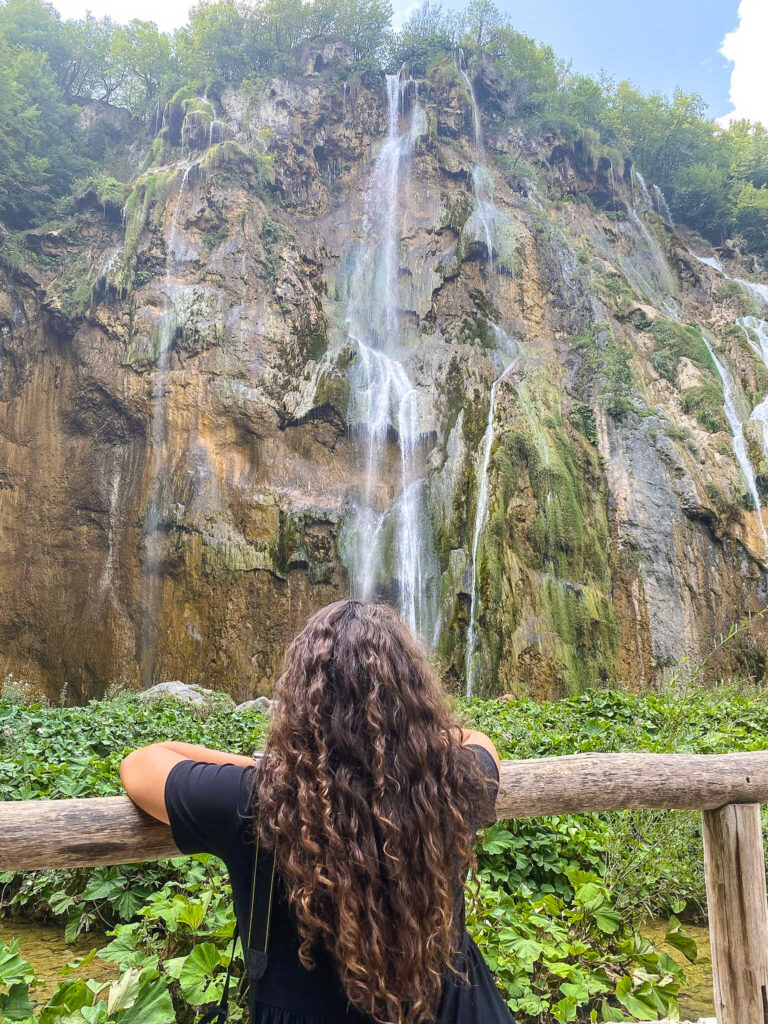
From the spectacular Plitvice Lakes National Park to Krka National Park and Mljet National Park, this stunning corner of Europe offers visitors a chance to explore some of the most breathtaking natural wonders.
When deciding the best time to visit Croatia’s national parks, springtime is definitely your best bet.
With temperatures hovering around a pleasant 70°F (21°C) and fewer crowds than during peak season, spring offers an ideal balance of sunshine and tranquility.
You’ll see nature in full bloom, and the waterfalls are at their fullest due to snow runoff–making it an unparalleled opportunity for visitors looking to really soak up nature’s beauty.
Best Time to Visit Croatia for its Festivals
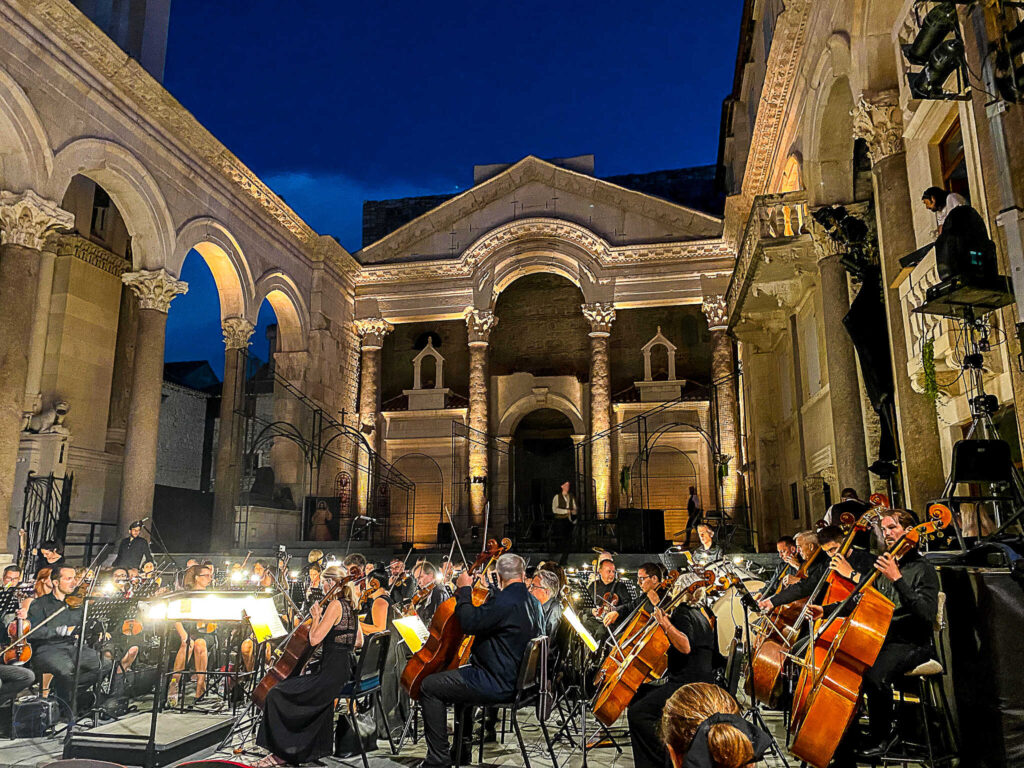
Croatia is a country full of exciting events throughout the year, but the top festival seasons are spring and summer.
During this time, you’ll enjoy some of Croatia’s most popular outdoor events and performances, like the Split Summer Festival, the Days of Diocletian, and the Festival of Flowers.
Best Time To Visit Croatia For Sightseeing

Summertime in Croatia is simply the best time to visit. Why?
As long as crowds aren’t an issue for you, peak tourist season from June through mid-August is perfect for exploring the country’s incredible attractions.
During this period, the weather is warm and sunny–you’ll want to bring sunscreen, sunglasses, and a hat, as temperatures can reach up to 31°C (87°F) in Split.
Best Time To Visit Croatia: Month To Month

Croatia is a beautiful destination, no matter the time of year.
However, for those looking for the perfect time to visit, some months may be better than others, depending on what you’re looking for.
Although Croatia is most famous as a summer destination, it also has some great winter activities!
Museum Night is an annual event where museums nationwide open free admission on the last Friday in January.
Croatia even has some excellent ski resorts in the Gorski Kotar mountains.
However, even though you’ll find some great deals, remember that not all restaurants and accommodations will be open during these months.
In February, the weather in Croatia is still relatively cold. Still, it’s not unbearably cold like in the more northern European countries.
Average temperatures range from highs of 11°C (52°F) to lows of 3°C (38°F) throughout the month.
Along with skiing, February brings several exciting festivals.
Early in the month, Dubrovnik has a massive celebration in honor of its patron saint, Saint Blaise.
Later, you can find Carnival celebrations in the cities of Rijeka, Zadar, and Dubrovnik.
As we finally leave winter weather for a hint of spring, March is an excellent choice if you like exploring countries without the typical crowds.
The winter crowds are gone, and the weather is mild and sunny, making it great for outdoor activities and sightseeing.
You can also score some excellent deals on hotel prices in March since it’s before the peak summer season rush.
April is not just a great month for the weather; it’s also an excellent month for sightseeing.
The weather is mild and enjoyable, with temperatures still averaging from 9°C (49°F) to 18°C (64°F).
Since it is less crowded, travelers can easily explore Croatia’s stunning beauty without feeling overwhelmed by too many people visiting at once.
And I can guarantee that you will be happy taking advantage of this spell of peacefulness and taking in all the sights without having to stand in long lines or wait on crowded tour buses.
In May, the crowds have yet to hit their peak, which means it’s the perfect time to visit Croatia.
With temperature highs around 22°C (72°F) and lows of 13°C (56°F), it’s a great time for outdoor activities.
And many prices are slashed; tourists benefit from early season discounts as restaurants and attractions come alive with activity throughout springtime in Croatia.
With most major attractions still open but many beaches yet to be crowded, visiting Croatia in May can give you an outstanding balance of exploration and relaxation at the same time.
Summertime in Croatia is the most magical season.
June brings sun-filled days and warm evenings, making it the perfect time of year to explore Croatia’s stunning beaches and ancient towns.
With average highs of 26°C (79°F), summer is ideal for outdoor adventures like hiking through national parks and touring coastal towns on a bike or kayak tour.
There is something special about visiting Croatia in July.
With warm temperatures and clear skies, it’s the perfect month for outdoor activities like swimming in the Adriatic Sea or exploring forest trails.
The days are long, so you can make the most of your stay by making early-morning or late-night trips.
Well, if you want to experience the country at its finest, then there’s no better time than August!
It’s the perfect time of year for swimming and hiking. The weather is typically sunny and warm, with temperatures reaching as high as 31°C (87°F) in Split.
September is the perfect time to explore Croatia’s stunning islands, from Hvar and Brac to Vis and Korcula.
The hot summer days are ending, but the weather remains mild, with plenty of sunshine.
This makes it an ideal time for swimming in crystal clear waters, relaxing on a beach, or exploring the many cultural attractions of these picturesque islands.
Come October, the temperature cools down, and the islands are in harvest season. Fewer tourists are around, so you can enjoy the last days of warm weather before the end of the year.
However, ferries start running on their reduced winter schedules in October. You might find many hotels and restaurants closed for the winter.
November allows travelers to explore Croatia’s beautiful cities and local culture without the price surge that summer tourists see.
Temperatures usually hover around 14°C (58°F) for the high and 8°C (46°F) for the low, making this ideal for sightseeing without feeling chilled.
Tis the season for Christmas markets, and Croatia has some beautiful ones! Most notably, the Zagreb Christmas Market is the most extensive in the country.
The inland, northern region of the country even offers snow-covered mountains ideal for winter activities such as skiing, snow-shoeing, and snowboarding, providing an extra layer of appeal during the festive season.
Best Time to Visit Croatia’s Top Cities

Croatia is a fantastic destination for any traveler with its stunning coastline, picturesque rivers, and lush rolling hills.
From the vibrant capital of Zagreb to the beautiful city of Split, plenty of places exist for you to explore.
But when is the best time to visit these cities?
Best Time to Visit Zagreb
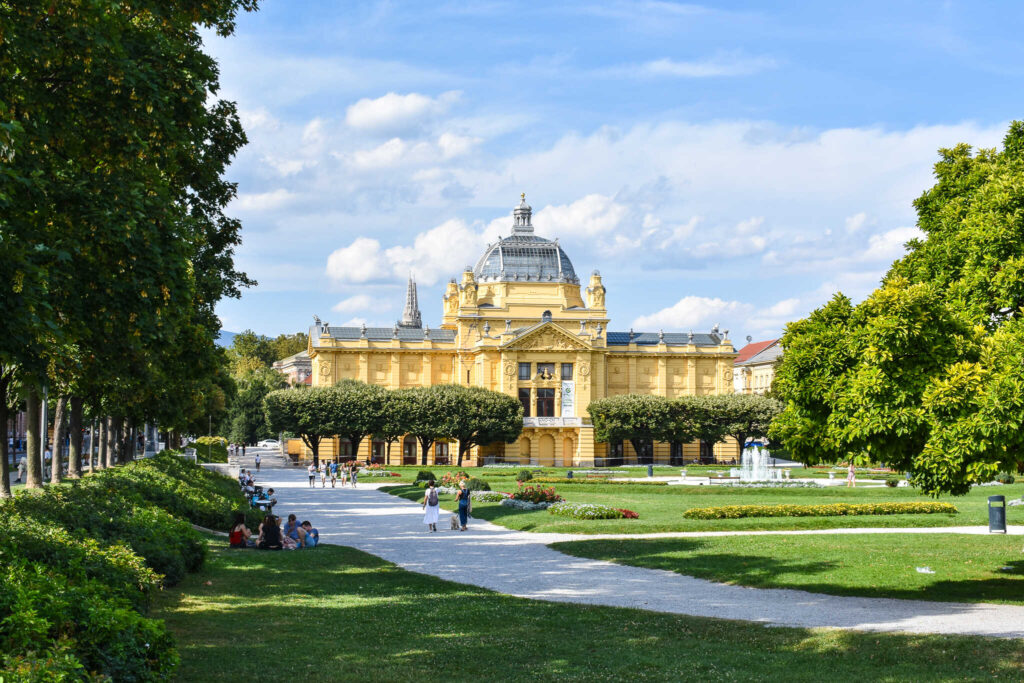
Zagreb, the capital city of Croatia, is a delightful mix of history, culture, and contemporary life.
The city’s charm is evident in its streets, parks, museums, and historical landmarks– you should definitely consider visiting !
While the city is beautiful year-round, the best time to visit Zagreb is from June to August.
During this period, the weather is warm, sunny, and perfect for outdoor activities such as picnics in the park, sightseeing, and concerts.
The Zagreb Botanical Gardens is all in bloom this season, perfect for a leisurely walk in the sun.
One of the coolest Croatian summer events here is The Grič Evenings, one of Zagreb’s oldest summer music festivals.
Visitors can also explore the museums and galleries with special summer exhibitions during this time, like the Museum of Broken Relationships, a quirky and unconventional museum showcasing mementos and stories of failed relationships.
Best Time to Visit Pula

Pula, a beautiful coastal city in Croatia, is a must-visit destination for those seeking history, nature, and Italian-style architecture.
The best time to visit Pula is during the summer months, from June to September.
The weather during these months is sunny and warm, with temperatures averaging around 26°C.
This makes it ideal for spending time on the city’s beautiful beaches , which offer a relaxing atmosphere and a variety of water activities such as swimming, snorkeling, and boating.
In addition to enjoying the beaches, there are so many other things to do in Pula throughout the summer, like exploring the city’s historical landmarks.
The most famous attraction is the Pula Arena, an ancient Roman amphitheater that dates back to the 1st century AD.
During the summer, you can enjoy concerts, film festivals, and historical reenactments in the Arena.
Another must-see attraction is the Temple of Augustus, a well-preserved Roman temple in the city center.
The temple houses an impressive collection of ancient artifacts and statues, allowing visitors to learn about Pula’s fascinating history.
And with ferries running regularly along the Adriatic coastline, it’s easy to take a day trip from Pula to places like Venice , Italy, or Rovinj or Poreč, Croatia.
You can check out my guide to t he best way to spend 3 days in Pula for more ideas!
Best Time to Visit Split
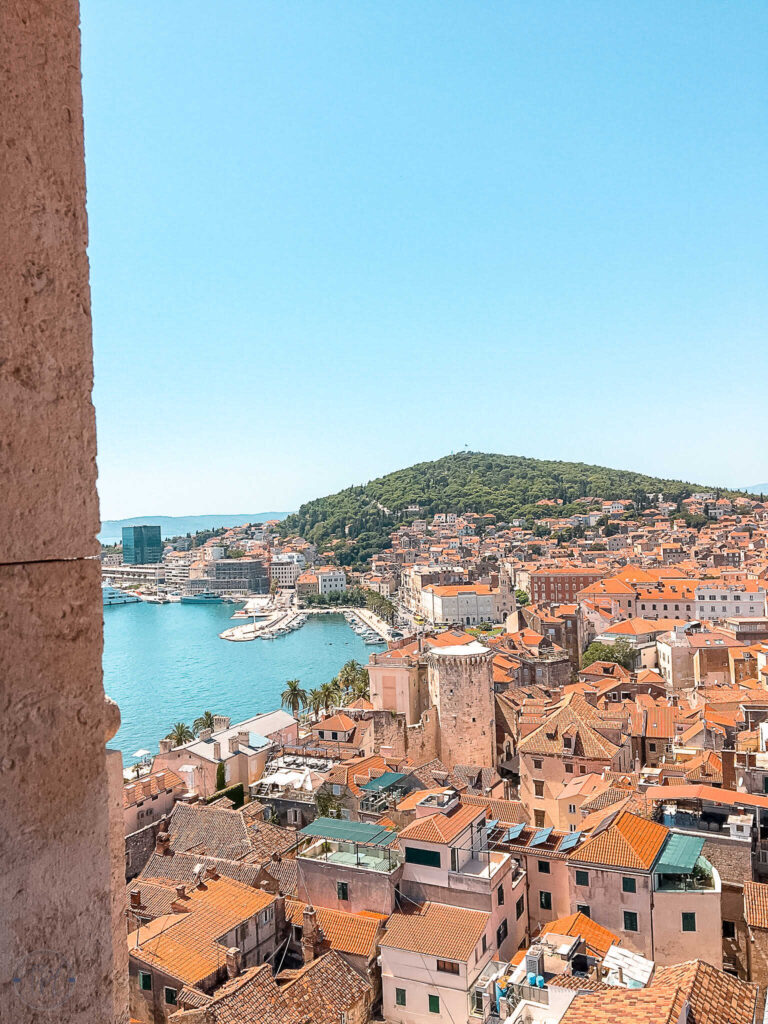
Split, a beautiful coastal city on Croatia’s Dalmatian coast, is rich in culture and history.
The best time to visit Split is during the summer, from late May to early September, when the weather is warm and sunny.
This season offers the perfect opportunity to enjoy the city’s stunning photo spots , crystal-clear waters, and numerous outdoor activities.
One of the must-do activities during the summer months is to visit the city’s famous Diocletian Palace .
The palace, built in the 4th century AD, is a UNESCO World Heritage site and offers a glimpse into the city’s rich history.
Several outdoor summer festivals, such as jazz and drama, are held within the palace.
Another one of the best things to do in Split during this period is to hike Marjan Forest Park, located on the hills above the city.
The park offers jogging and walking trails, offering amazing views of the city, making it a perfect spot for an evening stroll or an afternoon picnic.
Beach lovers can enjoy the numerous Split beaches with clear waters that line the coast. Bačvice Beach, the closest and most popular, is covered in fine sand and offers many water sports, like paddle boating.
You can find several local restaurants and cafes, which offer the perfect place to relax and enjoy the warmth of the summer months.
And it’s easy to take all the incredible day trips from Split to different cities nearby, like Šibenik , Trogir , and Omiš.
I have a whole guide on how to spend the perfect 3 days in Split –but you could easily stay for longer!
Best Time to Visit Dubrovnik
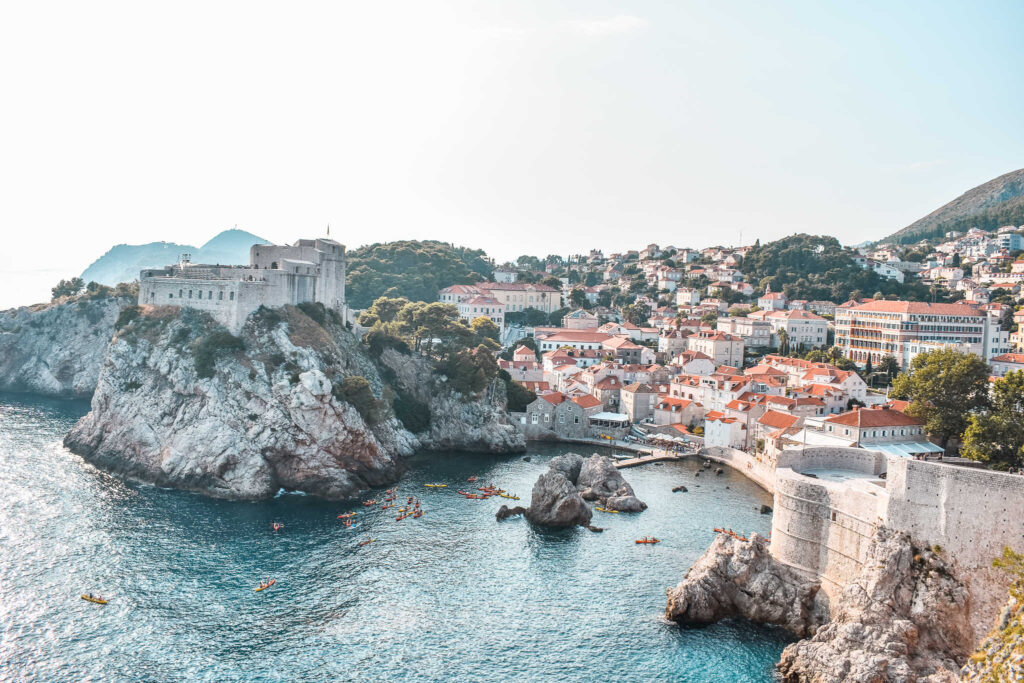
Dubrovnik is one of Croatia’s most beautiful cities and popular destinations– definitely worth visiting if you have a chance !
While Dubrovnik can be enjoyed year-round, the summer months of May to September are the best time to visit Dubrovnik because of the perfect weather that the season offers.
Visitors can enjoy the warm temperatures, sunshine, and long days during this period.
They can enjoy the beautiful beaches and a host of outdoor activities such as kayaking, snorkeling, and swimming.
Additionally, summer is a beautiful time to stroll around Dubrovnik’s historic city walls.
Built in the 13th century, the city walls stand to this day. Visitors can witness the stunning views of the sea and the historic city below while walking around the 1.94 kilometers (1.2 miles) loop.
The Dubrovnik Summer Festival is held from mid-July to late August. It offers concerts and performances within the city walls.
For food lovers, there is no better time to visit Dubrovnik than in the summer.
Dubrovnik offers an overwhelming choice of seafood specialties and fresh local fruit and vegetables.
Weather in Croatia
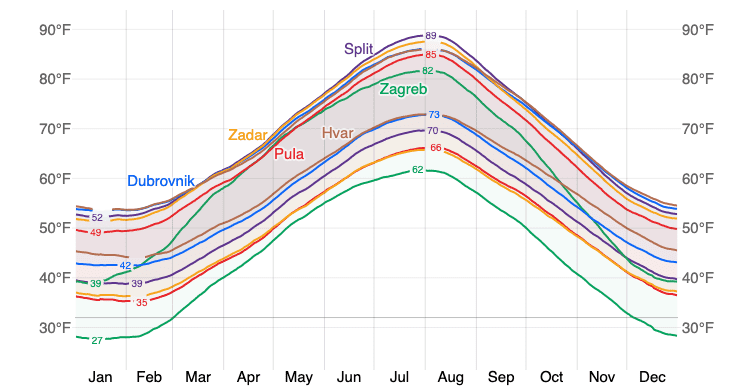
The weather in Croatia is generally pleasant, with mild temperatures throughout the year.
Its coastline has a Mediterranean climate, which means it’s hot and sunny throughout the summer and mild in the winter.
Inland, you’ll find a continental climate, which means it has hot summers and cold winters.
In summer, the average high temperature ranges from 26°C (79°F) in June to 29°C (84°F) in August, making it an ideal place to soak up some sun and explore the stunning coastline.
In winter, the average low temperature stays around 11°C (51°F) from December until February.
The hottest months are July and August, while the coldest months are December and January.
Rainfall is generally higher during autumn, especially in October and November. Pack a raincoat if you visit during this period!
If you’re looking for something a little more extreme, winter can also be an excellent time for skiing or snowboarding in one of Croatia’s many ski resorts.
Why visit Croatia?
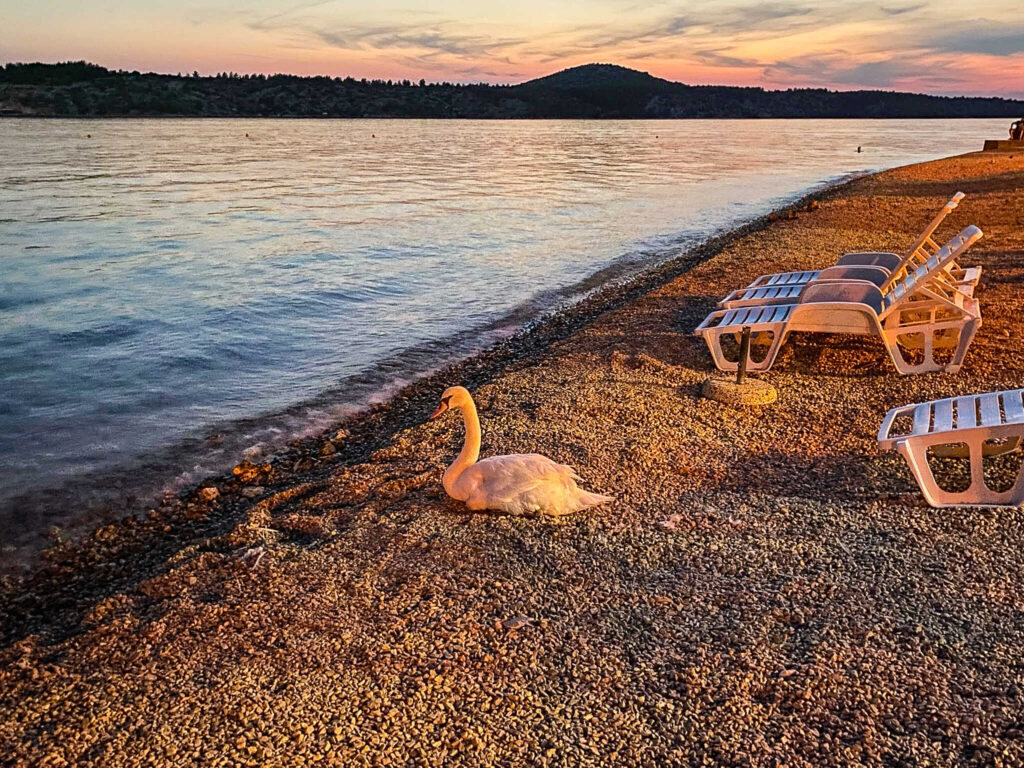
Whether you’re looking for a romantic getaway or an adventure-filled holiday, you’ll find it in Croatia!
The country spans the beautiful Adriatic coast, with stunning beaches and bustling cities. At the same time, the interior is home to lush national parks and majestic mountains.
There are many cultural events throughout the year, including delicious cuisine and excellent wines.
From the moment I stepped foot in Croatia for the first time, I was absolutely blown away by the sheer natural beauty that surrounded me completely.
The freshest seafood, taken out of the sea that morning and on your plate by lunchtime.
The clearest, cleanest blue water I’ve ever swam in, and I had to watch out for sea urchins to ensure I didn’t prick my feet.
And every night, the sky becomes a brilliant, brand-new painting as the sun sets and washes the whole world with color.
Visiting Croatia: FAQs
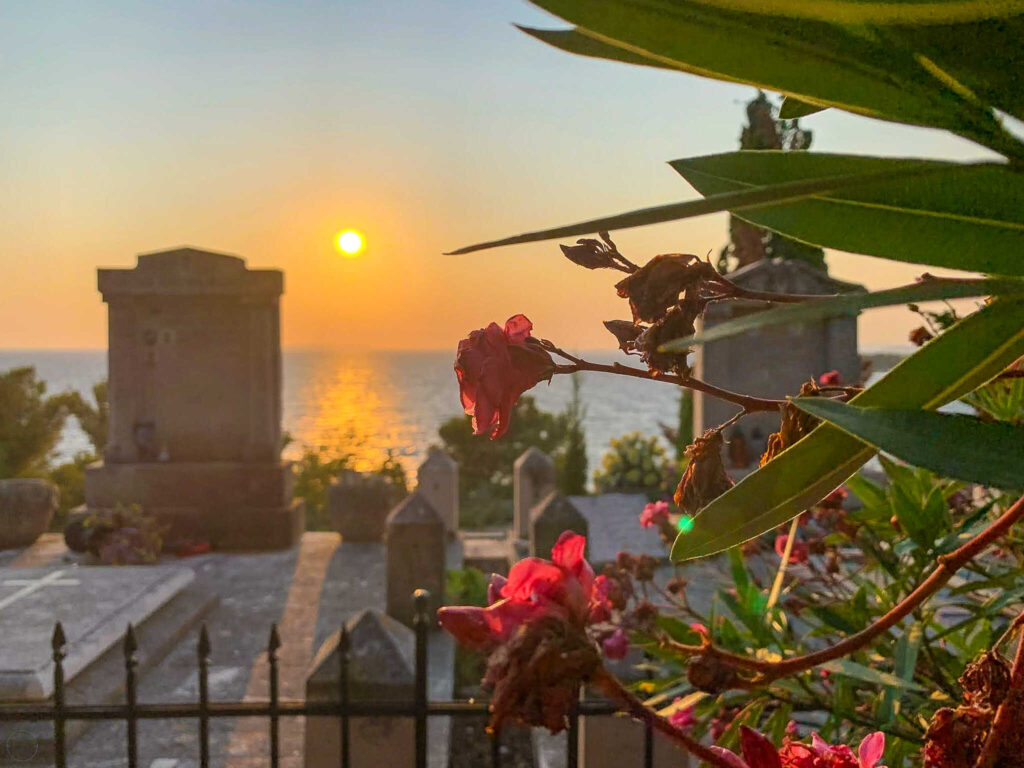
What is the cheapest month to go to Croatia?
Visiting Croatia on a budget is definitely possible! The cheapest month to go to Croatia is usually April or October.
April has the advantage of being one of the shoulder seasons, meaning you won’t have to deal with the higher prices and overcrowding that come with peak season.
You’ll still enjoy a surplus of sunshine and warm temperatures during this time, making it perfect for exploring all Croatia has to offer.
In October, you can also benefit from lower prices and fewer crowds.
Plus, you’ll also experience some cultural festivals during this time, like Istrian Truffle Days held in towns all over the Istria region and the Chestnut Festival in the city of Lovran.
It’s worth noting that this is also one of the rainiest months in Croatia, so make sure you pack a raincoat if you’re visiting at this time!
What is peak tourist time in Croatia?
Peak tourist time in Croatia is generally during the summer months of July and August.
It’s hot and sunny most days, and the restaurants that are closed for the winter months are open and filled with guests.
Temperatures are at their highest, which is great when you want to spend endless days on the beach.
Plus, if you’re a fan of music festivals, then you will want to experience Ultra Europe in Split!
However, this is also when Croatia sees its largest influx of tourists.
Due to demand, prices tend to be higher during these months, so be sure to research your accommodation beforehand to get the best deals.
What are Croatia’s hottest months?
Croatia’s hottest months are typically July and August when temperatures reach an average of 29°C (84°F).
During these months, there’s tons of sunshine, making it the perfect time to explore Croatia’s stunning beaches along the Adriatic Coast.
However, it’s important to note that this is also peak tourist season, so if you’re looking for a holiday experience where you have the beaches and historical landmarks to yourself, then visiting outside of the summer months may be preferable.
Best Time To Visit Croatia: Wrap-Up
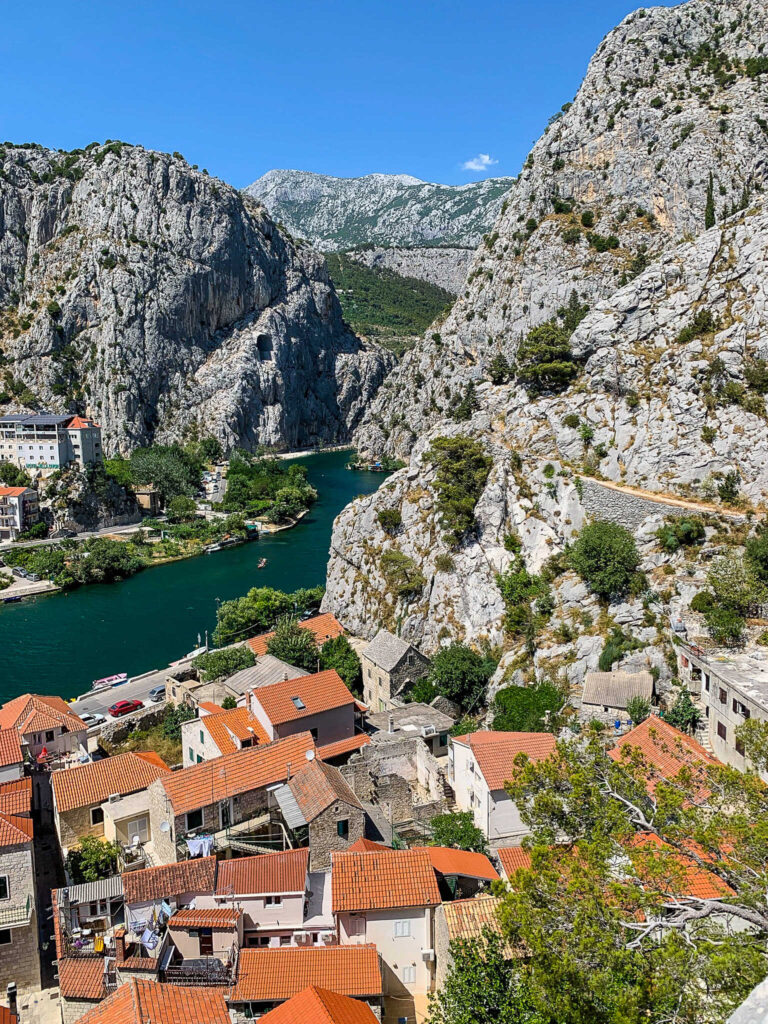
It’s hard to pick the “best” time to visit Croatia because each season offers something unique and beautiful.
However, while the winter brings fewer crowds, holiday markets, and cozy traditions, the summertime offers long days, beautiful beaches, and warm temperatures to this coastline country.
If you want to explore the Croatian islands, beaches, and cities, you must come in the summer.
Although each traveler will have their own preferences and priorities when visiting Croatia, one thing is certain–Croatia’s natural beauty and varied history make it a must-see destination.
No matter when you decide to visit, Croatia will undoubtedly leave a lasting impression on you.
From stunning national parks to vibrant cities and towns, this beautiful country has something you won’t want to miss.
So, whether you’re planning a summer beach vacation or a winter getaway, don’t hesitate to explore all Croatia offers!
- The Best Beaches in Šibenik, Croatia
- The Best Beaches in Trogir, Croatia
- How to Travel in Italy Without a Car: The Ultimate Guide
- Extraordinary Non-Touristy Places to Visit in Italy
- Outstanding Wine & Prosecco Tours from Venice, Italy
- Your Guide to 2 Days in Salzburg, Austria
- Amazing Gifts for History Buffs They’re Sure to Love
- Best Travel Necessities: A Women’s Guide to Vacation Essentials
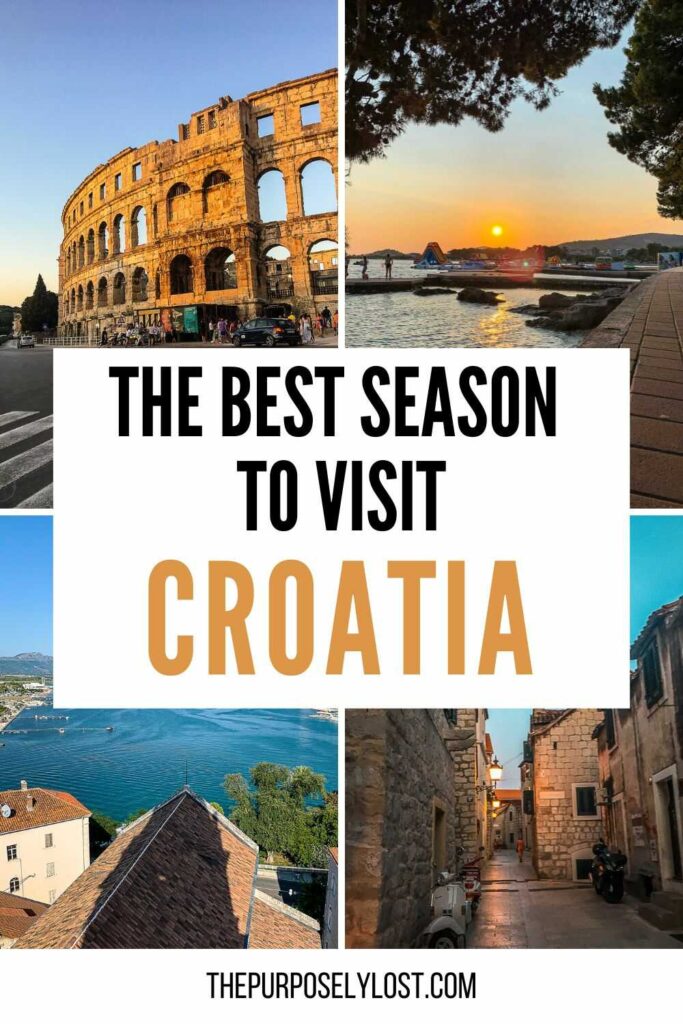
You’ll Also Love

15+ Crazy Things to do in Split, Croatia at Night

Become Purposely Lost
I'm Lyndsay! Thank you so much for joining me here at The Purposely Lost.
- Affiliate Disclaimer
- Cookie Policy
- Privacy Policy
- Terms and Conditions
- Accessibility Statement
- United States
- Travel Tips
Copyright © 2024 The Purposely Lost · Theme by 17th Avenue
Privacy Overview

Best Time to Visit Croatia: 2024 Croatia Planning Tips
IF YOU ARE PLANNING YOUR HOLIDAY TO CROATIA, YOU MIGHT BE THINKING, WHEN IS THE BEST TIME TO VISIT CROATIA.
As someone who calls Croatia home year-round , I fully understand the nuances of each season, from weather patterns to the ebb and flow of tourist crowds. There are many factors to consider when deciding the best time to visit Croatia. For example the country’s diverse climate and of course personal preferences . I love the sun, but I also love the outdoors, so that would impact where and when I would travel in Croatia.
My goal in this article is to help you navigate these factors and variations. You can then decide the best time for your Croatian adventure and start planning your vacation. Let me jump straight in with an overview of the seasons in Croatia .
Please note that some links on CroatiaExperiences.com are affiliate links. I may receive a commission if you click through a link and make a purchase from one of our partners. It doesn’t cost you anything extra and helps me to keep providing travel content about Croatia. Learn more .
Best Time to Visit Croatia
High season in croatia.

The high season typically spans from June to August . During this time expect warm temperatures and sunny skies, creating the perfect conditions for beach vacations in Croatia and outdoor adventures. Coastal towns and islands buzz with energy as visitors, like myself, want to soak up the Mediterranean climate and vibrant atmosphere.
Pros for visiting Croatia in the High Season
✔️ In the high season, Croatia comes alive with an array of exciting activities and events.
✔️ From sailing along the stunning Adriatic coast to exploring historic cities steeped in culture and tradition, there’s no shortage of things to see and do in Croatia .
✔️ The warm weather allows for leisurely beach days and thrilling water sports, while evenings are filled with lively entertainment and delicious seafood dinners by the sea.
✔️ There are many public transportation options connecting all the cities and towns in Croatia and plenty of flight options to Croatia.
Cons for visiting Croatia in the High Season
❌ The popularity of the high season also means larger crowds and higher prices.
❌ Popular tourist destinations can become crowded, particularly in July and August, making it essential to plan and book accommodations and activities well in advance.
❌ The hot temperatures during the day can be intense, so if visiting Croatia in the High Season, you must take precautions to stay hydrated and seek shade when needed. You won’t find Croatians lying on the beach in the midday sun!
❌ If you are driving, expect traffic in popular areas.
Key Events and Activities taking place in Croatia during the High Season
The high season in Croatia is marked by a variety of key events and activities. In Dubrovnik, the renowned Dubrovnik Summer Festival showcases an array of cultural performances. Split comes alive with the Split Summer Festival , featuring open-air concerts and theatrical performances in the historic Diocletian’s Palace. I also enjoy watching the sailing regattas and attending food festivals, and outdoor concerts throughout the summer months. It is the time when everything is alive and happening!
Top Tips for Visiting Croatia in the High Season
Here are my tips to make the most of your visit to Croatia during the high season:
💡 Book Croatia accommodation, activities and transportation well in advance to secure the best options and avoid disappointment.
💡Visit popular attractions early in the morning or late in the afternoon to avoid the largest crowds.
💡Stay hydrated and protect yourself from the sun by wearing sunscreen, a hat, and sunglasses.
💡Be mindful of your budget and plan for higher prices for accommodations, dining, and activities during peak season.
Shoulder Season in Croatia

The shoulder seasons of spring (April-May) and autumn (September-October) offer a welcome respite from the crowds and heat of the high season, while still providing pleasant weather and a wealth of activities to enjoy. For me, this is one of the best times to visit Croatia and an ideal time to explore Croatia’s diverse landscapes and cultural attractions.
Pros for visiting Croatia in the Shoulder Season
✔️ During the shoulder season, the temperatures are pleasantly mild and there are fewer crowds, allowing for a more relaxed and authentic travel experience.
✔️ The weather is perfect for outdoor activities such as hiking, cycling, and sightseeing.
✔️ Attractions and accommodations are more readily available and affordable compared to the high season.
Cons for visiting Croatia in the Shoulder Season
❌ While the shoulder season offers many advantages, keep in mind that the weather can be unpredictable, with occasional rain showers and cooler temperatures.
❌ Some beach destinations may have quieter atmospheres or cooler water temperatures, limiting swimming opportunities.
❌ Some restaurants and amenities in more remote locations may not be open.
Key Events and Activities taking place in Croatia during the Shoulder Season
The shoulder season in Croatia is marked by a variety of cultural events and outdoor activities. Explore the wine regions such as Istria, Dalmatia, and Slavonia and visit wineries to taste local Croatian wines. Embrace the great outdoors and cycle the coastal routes in Dalmatia or around Plitvice National Park.
Top Tips for Visiting Croatia in the Shoulder Season
Here are my tips to make the most of your visit to Croatia during the shoulder season:
💡Pack layers to accommodate changing weather conditions, including a light jacket or sweater for cooler evenings.
💡Take advantage of off-season deals and discounts on accommodation and tours.
💡Embrace the slower pace and enjoy a more authentic experience with locals, who are often more relaxed and willing to engage with visitors during this time.
💡Check the opening hours and availability of attractions and restaurants, as some may have limited hours or be closed during the shoulder season.
Low Season in Croatia

The low season in Croatia, which typically spans from November to March , offers a tranquil and budget-friendly option for people seeking to explore the country’s natural beauty and cultural heritage without crowds. While the weather may be cooler and some tourist facilities closed, the low season offers more immersive travel experiences. There are a reduced number of transportation and flight connections, so you will need to be more strategic with your planning if visiting Croatia in the low season.
Pros for visiting Croatia in the Low Season
✔️ During the low season, you can enjoy peaceful surroundings and uncrowded attractions.
✔️Accommodation and tours are often available at discounted rates, making it an ideal time if you are travelling on a budget to explore Croatia’s treasures.
✔️ It’s a great time to enjoy active pursuits such as cycling and experience Croatia with the locals.
✔️ If you are hiring a car, you won’t need to worry about traffic or parking.
Cons for visiting Croatia in the Low Season
❌ If you are visiting Croatia in the low season be prepared for cooler temperatures and shorter daylight hours, as well as the possibility of rainy or snowy weather, particularly in inland regions. When it rains here, it really rains! But as a wise person once said, there is no such thing as bad weather, just bad clothing. So pack appropriately!
❌Some tourist facilities may be closed or operating on limited hours.
❌ There are reduced transportation options, especially boat connections to the islands, so it can be trickier to travel around.
Key Events and Activities taking place in Croatia during the Low Season
Despite the quieter atmosphere of the low season, there are still plenty of activities and events to enjoy in Croatia including the Dubrovnik Winter Festival and the Rijeka Carnival . From exploring historic cities adorned with festive decorations to sampling traditional winter delicacies at holiday markets, it’s a great time to embrace yourself in Croatia’s seasonal festivities.
Tips for Visiting Croatia in the Low Season
Here are my tips to make the most of your visit to Croatia during the low season:
💡Pack warm clothing and waterproof gear to stay comfortable in cooler and potentially wet weather conditions.
💡Take advantage of off-season deals and discounts on accommodations, tours, and attractions.
💡Embrace the slower pace and enjoy a more relaxed and authentic travel experience with fewer crowds and more opportunities for meaningful interactions with locals.
💡Check the opening hours and availability of tourist facilities and attractions, as some may have limited hours or be closed during the low season; as well as the transport routes which will be reduced.
READ NEXT > Best Places to Stay in Croatia: Accommodation Tips for Travellers to Croatia 2024
Croatia Travel: A Month-by-Month Overview

Croatia in January
In January, Croatia experiences cool temperatures across the country, with average highs ranging from 8°C to 12°C. The sea temperature is chilly, hovering around 12°C, making swimming less appealing but perfect for scenic coastal walks. Despite the cooler weather, January offers unique cultural experiences, such as the Dubrovnik Winter Festival and the start of the Rijeka Carnival . You can also enjoy skiing and snowboarding in the inland regions.
Croatia in February
February in Croatia brings similar temperatures to January, with average highs ranging from 9°C to 13°C. The sea temperature remains cool, averaging around 11°C. The Rijeka Carnival continues into February. For outdoor enthusiasts, February is an excellent time for winter sports and snowy adventures in the mountainous regions, with ski resorts like Platak and Bjelolasica. The waterfalls at Plitvice Lakes National Park freeze and turn it into a winter wonderland – it is a stunning sight to see.
Croatia in March
As spring begins to emerge, March sees an increase in temperatures across Croatia. The average highs range from 12°C to 16°C. The sea temperature starts to rise slightly, reaching around 13°C. March is a good month to enjoy outdoor activities such as exploring the historic city of Split and hiking in the picturesque landscapes of Istria and Dalmatia.

Croatia in April
April brings mild and pleasant weather to Croatia, with average highs ranging from 15°C to 19°C. The sea temperature begins to warm up, reaching around 15°C, making it suitable for early-season beach activities. April marks the start of the tourist season, with attractions reopening. Spring blooms adorn the countryside, creating a picturesque backdrop for outdoor adventures and sightseeing. April is an ideal time to visit Croatia’s national parks, including Plitvice Lakes and Krka and enjoy Easter Celebrations.
Croatia in May
May marks the beginning of summer-like weather in Croatia, with average highs ranging from 19°C to 24°C. The sea temperature becomes more inviting, reaching around 18°C, perfect for swimming and water sports. May 1st (Labour Day in Croatia) traditionally marks the first day of swimming. May is a fantastic time to explore Croatia’s coastal towns and islands, from the vibrant city of Dubrovnik to the idyllic shores of Hvar and Korčula.
Croatia in June
June heralds the arrival of summer in Croatia, with warm temperatures and sunny skies inviting you to the coast. Average highs range from 24°C to 28°C. The sea temperature reaches a comfortable 22°C, ideal for beachgoers and water enthusiasts. June starts the peak tourist season, with bustling cities and crowded beaches. It is also a perfect time to enjoy outdoor activities and cultural events. Highlights include sailing along the Adriatic coast and attending the Dubrovnik Summer Festival.

Croatia in July
July is the height of summer in Croatia, with hot temperatures and clear skies. Average highs range from 27°C to 31°C, with the sea temperature peaking at around 24°C, perfect for swimming and sunbathing. July offers an abundance of activities and events for everyone to enjoy. From island hopping and beach parties to cultural festivals and culinary delights, there’s never a dull moment in Croatia during July!
Croatia in August
August continues the summer heat in Croatia. The average highs range from 27°C to 31°C and sea temperatures remain warm at around 25°C. The beaches are bustling with visitors soaking up the sun, while the cities are alive with cultural events and nightlife. August is the perfect time for adventures on the sea, including windsurfing, snorkelling and exploring Croatia’s underwater paradise.
Croatia in September
As summer begins to wane, September offers a pleasant transition to autumn in Croatia. This is my favourite month in Croatia! Average highs range from 23°C to 27°C, with the sea temperature still warm at around 23°C, perfect for late-season swimming. September is an ideal time for outdoor activities like hiking and cycling, as the weather remains mild and the crowds start to thin out. It’s also the time of the grape harvest and wineries are always on the lookout for people to help!

Croatia in October
October brings cooler temperatures to Croatia, with average highs ranging from 18°C to 22°C. The sea temperature begins to drop but still hovers around 20°C, so swimming and water activities are still possible. October is a great time to explore Croatia’s cities and historic sites, as tourist crowds diminish and the weather remains pleasant for sightseeing. Nature lovers will appreciate the autumn foliage in the countryside and the opportunity to hike in the national parks before winter sets in.
Croatia in November
November marks the onset of winter in Croatia, with cooler temperatures and occasional rain showers. Average highs range from 13°C to 17°C, while the sea temperature decreases to around 17°C, making swimming less common. I do remember years on Korcula when it was still warm enough to swim in November. Despite the cooler weather, November offers unique experiences, such as truffle hunting in Istria.
Croatia in December
December brings festive cheer to Croatia, with twinkling lights and decorations adorning the cities and towns. Average highs range from 9°C to 13°C, with the sea temperature cooling to around 14°C. December is a magical time to visit Croatia, with Christmas markets, concerts, and events celebrating the holiday spirit. I love Christmas time in Croatia. When we can enjoy traditional Croatian dishes like fritule and mulled wine while exploring the charming Christmas markets in Zagreb, Split, and Dubrovnik.
Croatia’s Diverse Climate: Weather Insights by Region

Croatia’s geographical diversity lends itself to a wide range of climates and landscapes, which also means it offers diverse activities. Let me introduce you to the distinct characteristics of coastal and inland Croatia.
Weather in Coastal Regions of Croatia
Croatia’s coastal regions have a Mediterranean climate, characterized by hot, dry summers and mild, wet winters. The Adriatic Sea moderates temperatures, creating pleasant conditions for beachgoers and outdoor enthusiasts. The sea breeze provides relief from the heat.
Plenty of water activities can be enjoyed throughout the summer in coastal Croatia. You can enjoy windsurfing and kitesurfing, snorkelling and diving, and kayaking.
Weather in Inland Regions of Croatia
Croatia’s inland areas, including regions like Zagreb, experience a continental climate characterised by hot summers, cold winters, and greater temperature fluctuations throughout the year. The absence of the moderating influence of the Adriatic Sea results in more extreme weather conditions compared to the coast.
Inland areas of Dalmatia, such as the Dinaric Alps, experience slightly cooler temperatures and occasional rainfall. This offers a refreshing escape from the summer crowds. Istria’s inland areas experience greater temperature variations, with cooler temperatures in the hills and valleys compared to the coastal areas. These regions are a haven for outdoor enthusiasts year-round.
In winter, mountainous regions in Croatia transform into snowy paradises, attracting skiers and snowboarders to its picturesque slopes.
Best Time to Visit Croatia for Sightseeing

Croatia’s rich cultural heritage can be experienced year-round, with museums, galleries, and historic sites open throughout the year. However, the best time to explore Croatia’s historic cities and cultural landmarks is during the shoulder seasons of spring and autumn. During these times, the weather is mild, the skies are clear, and tourist crowds are fewer.
In spring, it’s lovely to wander through the narrow cobblestone streets of Dubrovnik’s Old Town. Or marvel at the Roman architecture of Split’s Diocletian’s Palace. Before exploring the historic city of Zagreb with its museums, galleries, and cafes. Autumn brings opportunities to witness the changing colours of Plitvice Lakes National Park. It’s a lovely time to stroll along the waterfront promenades of Rovinj and Zadar and discover the cultural treasures of inland regions like Istria and Slavonia.
Best Time to Visit Croatia for Beach Lovers

If you are a sun-seeker or beach lover (like me!), the best time to visit Croatia is during the Summer months of June to August when the weather is hot, and the Adriatic Sea is warm and inviting. During this time, Croatia’s coastal towns and islands come alive with bustling beaches, vibrant waterfront promenades, and an array of water sports and activities. From the sandy shores of Zlatni Rat Beach in Bol to the hidden coves of Vis and Hvar, there’s a beach for every preference along Croatia’s stunning coastline.
Best Time to Visit Croatia for Special Events and Festivals

Croatia’s vibrant cultural scene comes alive throughout the year with a variety of special events and festivals. One of the highlights is the Dubrovnik Summer Festival, held annually from July to August, which transforms the historic city into a stage for theatre, music, dance, and art performances.
Similarly, the Split Summer Festival, also taking place in July and August, celebrates the city’s cultural heritage with a diverse program of theatrical productions, concerts, and exhibitions held in iconic venues like Diocletian’s Palace and Peristyle Square.
In December, the Zagreb Advent marks the start of the holiday season with a month-long celebration featuring festive markets, street performances, and culinary delights. I love to wander through the charming streets of Zagreb’s Old Town during Advent, sipping on mulled wine and munching on sweet bakes such as fritule and kroštule.
Best Time to Visit Croatia for Outdoor Activities

It’s possible to enjoy a wide range of outdoor activities year-round in Croatia. Spring and Autumn are particularly ideal for outdoor pursuits, with mild temperatures and fewer crowds making it the perfect time for hiking, biking, and nature walks. It’s also a great time to visit Croatia’s national parks, including Plitvice Lakes, Krka, and Paklenica.
During the summer months, Croatia’s coastline becomes a playground for water sports, with opportunities for swimming, snorkelling, diving, and sailing. Or if you’re more the adventurous type it’s also the time to enjoy adrenaline-pumping activities like rafting, zip-lining, and rock climbing.
In winter, Croatia’s mountainous regions transform into snowy paradises, offering opportunities for skiing, snowboarding, and snowshoeing. Ski resorts like Platak and Bjelolasica attract winter sports enthusiasts with well-groomed slopes, stunning mountain views, and après-ski amenities.
Best Time to Visit the National Parks in Croatia

While the National Parks in Croatia are open year-round, the best time to visit is during the shoulder seasons of spring and autumn when the weather is mild, and the crowds are fewer. It’s the best time to enjoy hiking trails, waterfalls, and scenic viewpoints without the summer crowds.
Plitvice Lakes National Park and Krk are particularly stunning in the spring when the surrounding forests come alive with vibrant colours and blooming flowers. Autumn offers equally breathtaking scenery, with the foliage turning shades of red, orange, and gold, creating a picturesque backdrop for hiking and photography.
Are you planning a trip to Plitvice National Park From Zagreb? This excellent tour provides transport, a guided tour and a trip to the charming town of Rastoke. >> Book Here <<
Paklenica National Park, located in the Velebit mountain range, offers opportunities for hiking, rock climbing, and spelunking year-round. Spring and autumn are ideal for outdoor activities in the park, with mild temperatures and fewer tourists allowing for uninterrupted exploration of its rugged terrain and karst landscapes.
My Travel Tips for Visiting Croatia in Each Season

💡When planning your trip to Croatia, it’s essential to consider the weather, seasonal activities, and transport options to make the most of your experience.
💡In spring and autumn, pack layers and waterproof clothing for variable weather conditions, and don’t forget comfortable walking shoes for exploring historic cities and natural landscapes.
💡During the summer months, swimming shoes, sunscreen, hats, and sunglasses are essential for protecting yourself from the sun, while lightweight clothing and swimwear are needed for beach activities.
💡I would recommend booking accommodations and activities in advance, especially during peak tourist seasons in summer and around major events and festivals.
💡Be flexible with your itinerary to allow for unexpected discoveries and experiences, and don’t be afraid to venture off the beaten path to explore Croatia’s hidden gems.
Budget Considerations when Visiting Croatia
Travelling to Croatia can be affordable year-round, with opportunities to save money on accommodation and activities during the shoulder and low seasons.
In spring and autumn, accommodation prices are typically lower than in summer. You may also find special offers and discounts for attractions and tours. Consider staying in guesthouses, hostels, or self-catering apartments to save on accommodation costs. Take advantage of local markets and grocery stores for budget-friendly dining options.
Transportation costs can also vary depending on the season. You’ll find cheaper fares for flights, trains, and buses during the shoulder seasons. I would recommend using public transportation to stretch your travel budget further.
Planning Your Trip to Croatia: Key Considerations

Planning a trip to Croatia requires careful consideration of various factors, including seasonal weather patterns, regional attractions, transportation options and personal preferences. Here’s my summary of the things you should consider when deciding the best time to visit Croatia:
Seasonal Weather Patterns in Croatia
The summer months in Croatia (June to August) are popular for beach vacations and outdoor activities, they can also be hot and crowded, especially along the coast. Spring in Croatia (April to June) and autumn in Croatia (September to November) offer milder temperatures and fewer tourists, making them ideal for sightseeing, hiking, and cultural exploration. Winter in Croatia (December to February) is less crowded but can be cold and rainy, particularly in inland regions.
Regional Attractions in Croatia
The perfect place to spend the summer months in Croatia is by the Dalmatian or Istrian coast enjoying the glorious beaches and refreshing breezes. Cultural and culinary festivals and events abound, with plenty of opportunities to sample delicious local produce and wine.
Spring and Autumn in Croatia are ideal times for sightseeing Croatia’s treasured old towns and historical sights such as the Roman ruins in Pula and hiking in Croatia’s National Parks. On days when the weather is not great to be outside, there are many interesting museums to visit.
During Wintertime in Croatia, it’s time to head to the mountains to enjoy fresh air and snow and enjoy the festivities at the Advent Markets.
Transportation
The availability of public transport in Croatia throughout the year changes and becomes limited outside of the high and shoulder seasons, especially the boat connections to the islands. Boat connections are also affected by bad weather which is more likely to occur in the shoulder and low seasons. There are a reduced number of flights to Croatia in the low season. Consequently, if you are travelling to Croatia at this time, you might need to do additional planning to get to where you need to go.
In the peak season, there are high demands for transportation in Croatia, so I would strongly recommend you make reservations and buy tickets in advance. However, there are many public transport options such as buses, ferries and catamarans and daily flights to Croatia from pretty much everywhere in the world!
Personal Preferences
Ultimately, the best time to visit Croatia depends on your personal preferences and travel priorities. If you like hustle and bustle and the sun come to Croatia during the peak tourist season. If you’re not bothered by the beach and prefer sightseeing and outdoor pursuits, come and enjoy the quieter atmosphere of the shoulder seasons in Croatia. Croatia offers the best time to visit for everyone!
FAQS: Best Time to Visit Croatia in 2024
When is the best time to visit croatia.
The best time to visit Croatia depends on your preferences and interests. Generally, the shoulder seasons of spring (April to June) and autumn (September to November) offer milder weather, fewer crowds, and a more relaxed atmosphere for sightseeing and outdoor activities. The high season from June to September is perfect for beach vacations and activities on the sea but is more expensive and busier.
What is the best time of year to visit Croatia for good weather and fewer crowds?
The best time of year to visit Croatia for good weather and fewer crowds is during the shoulder seasons of spring and autumn. During these times, the weather is mild, and tourist crowds are fewer, allowing for a more enjoyable and authentic experience.
When is the best time to enjoy sightseeing in Croatia?
Spring and autumn offer ideal conditions for exploring Croatia’s historic cities, including Dubrovnik, Split, and Zagreb, without the summer crowds. You can wander through ancient Roman ruins, medieval fortresses, and Baroque palaces, discovering the rich history and architecture of these iconic destinations.
What are the peak tourist seasons in Croatia, and when should I avoid visiting to avoid crowds and high prices?
The peak tourist seasons in Croatia are during the summer months of July and August when the weather is hot, and tourist attractions are crowded. To avoid crowds and high prices, it’s best to avoid visiting during these months and opt for the shoulder seasons instead.
What is the cheapest month to travel in Croatia?
The cheapest month to travel in Croatia is typically during the shoulder seasons of spring and autumn when accommodation prices are lower, and there are often special offers and discounts available for attractions and activities.
What’s the hottest month in Croatia?
The hottest month in Croatia is typically July, with temperatures often reaching their peak during this time. Be prepared for hot and humid weather, especially along the coast.
Are there any special events or festivals happening in Croatia during specific times of the year that I should plan my visit around?
Yes, Croatia hosts a variety of cultural events and festivals throughout the year, including the Dubrovnik Summer Festival in July and August, the Split Summer Festival in July and August, and the Zagreb Advent in December.
What is the weather like in Croatia during different seasons, and what activities are available during each season?
The weather in Croatia varies by season, with hot summers, mild springs and autumns, and cool winters. During the summer, you can enjoy beach vacations, water sports, and outdoor activities. In spring and autumn, sightseeing, hiking, and cultural exploration are popular activities. Winter offers opportunities for skiing, snowboarding, and holiday celebrations.
What are the shoulder seasons in Croatia, and how do they compare to the peak summer season in terms of weather and tourist crowds?
The shoulder seasons in Croatia are spring (April to June) and autumn (September to November). During these times, the weather is mild, and tourist crowds are fewer compared to the peak summer season. This makes it an ideal time to visit for those seeking a more relaxed and authentic experience.
Are there any regions in Croatia that are particularly beautiful or enjoyable to visit during certain seasons?
Yes, certain regions of Croatia are particularly beautiful or enjoyable to visit during certain seasons. For example, the Istrian Peninsula is known for its truffle festivals in autumn, while the Dalmatian Coast is popular for beach vacations in summer.
What are some tips for packing for a trip to Croatia during different seasons, such as clothing recommendations and essential items to bring?
When packing for a trip to Croatia, it’s essential to consider the weather and activities planned. In summer, lightweight clothing, sunscreen, sunglasses, swimming shoes and a swimsuit are essential. If you are visiting in spring and autumn, pack layers and waterproof clothing for variable weather conditions. During the winter season, bring warm clothing, including a coat, hat, and gloves, especially if visiting inland regions or ski resorts.
Is it possible to visit Croatia during the winter months, and what activities or attractions are available during this time?
Yes, it is possible to visit Croatia during the winter months. While some coastal areas may be quieter during this time, there are still plenty of activities and attractions to enjoy, including skiing, snowboarding, and winter festivals in the mountainous regions.
Is it possible to swim in the Adriatic Sea during the autumn months?
Yes, it is possible to swim in the Adriatic Sea during the autumn months, although the water is likely cooler compared to the summer months. Many people still enjoy swimming and water sports during this time, especially in coastal areas with milder climates. Some years people are swimming on Korcula well into November.
Wrap-up: Best Time to Visit Croatia in 2024
I hope this blog post has helped you decide when is the best time to visit Croatia. Regardless of when you choose to visit Croatia, each season offers its own unique charm and opportunities for exploration. Whether you’re seeking sun-soaked beaches, cultural experiences, or outdoor adventures, there’s something for everyone to enjoy in this beautiful Mediterranean destination. Plan your trip carefully, considering your interests, budget, transportation and accommodation options and preferred travel style, and get ready to embark on an unforgettable Croatian adventure.
READ NEXT > Best Tours in Croatia for Unforgettable Adventures in 2024
CROATIA TRAVEL PLANNING GUIDE
Should i buy croatian travel insurance.
While travel insurance is not mandatory for visiting Croatia, it’s highly recommended. It can provide coverage for medical emergencies, trip cancellations, lost luggage, and other unforeseen events, giving you peace of mind during your vacation.
Can I drink tap water in Croatia?
Yes, tap water in Croatia is safe to drink. It meets EU standards for quality and is safe for consumption in most areas. However, if you’re unsure or prefer bottled water, it’s widely available in stores and supermarkets.
Is it safe to rent a car in Croatia?
Renting a car in Croatia is safe and convenient for exploring the country, especially if you plan to visit rural areas or islands with limited public transportation. Just be sure to adhere to traffic laws, drive cautiously, and purchase comprehensive insurance coverage.
Will my phone work in Croatia?
Most international phones will work in Croatia, especially if they are unlocked and equipped with a SIM card slot. You can use your phone with a local SIM card purchased in Croatia or rely on international roaming services offered by your home carrier (make sure to check the charges beforehand, so don’t unexpectedly receive an expensive bill!).
What’s the best way to book my accommodation for my Croatia Vacation?
The best way to book accommodation for your Croatia vacation depends on your preferences and budget. You can use online travel agencies like Booking.com, Airbnb, VRBO or Expedia, hotel booking websites, or opt for direct bookings through hotels, guesthouses, or vacation rentals.
What is the best site to buy flights to Croatia?
There are several websites where you can find flights to Croatia, including Skyscanner, Google Flights, Expedia, and Kayak. It’s advisable to compare prices across multiple platforms and book your flights in advance to secure the best deals. Additionally, consider subscribing to airline newsletters for promotional offers and discounts.
Do I need a Visa to visit Croatia?
Travellers from the EU, Schengen Area, USA, Canada, Australia, and many other countries do not need a visa for short visits to Croatia. However, checking specific entry requirements based on your nationality is essential before travelling.
Hi! I'm Rachael. Originally from the UK I relocated to Korcula Island, Croatia in 2010 with my husband John. I am super passionate about helping people planning epic vacations to Croatia and created Croatia Experiences to be able to do just that. I also run a wine and local produce tasting company with John on Korcula.
Leave a Reply Cancel reply
Your email address will not be published. Required fields are marked *
Save my name, email, and website in this browser for the next time I comment.
- Best time to visit Croatia
Book your individual trip , stress-free with local travel experts
Select Month
- roughguides.com
- Travel guide
- Itineraries
- Local Experts
- Travel Advice
- Accommodation
Plan your tailor-made trip with a local expert
Book securely with money-back guarantee
Travel stress-free with local assistance and 24/7 support
Figuring out when to go to Croatia goes hand-in-hand with planning an itinerary for your trip. Perhaps you’re hankering after some sun, sea and sand on the beaches of its extensive and glorious coastline and islands . You might intend to explore Croatia’s national parks and take advantage of the plethora of outdoor activities on offer, such as hiking, climbing, mountain biking, sea kayaking and sailing . If so, your trip will be weather dependent. Maybe you’re more focused on soaking up the country’s rich history and culture, in which case you won’t be put off by chillier temperatures or a bit of rain. If you’re enticed by Croatia’s burgeoning festival scene , this takes off in the summer months.
Weather in Croatia
When to visit croatia in spring, when to visit croatia in summer, summer music festivals in croatia, when to visit croatia in the autumn, when to visit croatia in the winter, when to go to croatia for festivals, cultural, traditional, and religious festivals in croatia, music and dj festivals in summer, calendar of events in croatia, travel ideas for croatia, created by local experts.

Gorgeous gems of Hungary, Slovenia and Croatia
From the spas of Budapest to Lake Bled with its castle and further on to Croatia - this itinerary takes you across 3 countries, with a special focus on Slovenia's lake area and the Dalmatian coast in Croatia.

Sailing Croatia
If you want to experience the Dalmatian coast from a whole different perspective, then this trip is for you! Hop aboard a beautiful cruiser and sail along some of Croatia's most stunning islands.

Southern Pearls
This ten-day trip will take you around three adjacent countries, Croatia, Bosnia & Herzegovina, and Montenegro. Your tour starts in Split, Croatia, moving south (hence the name "Southern Pearls") over the island of Hvar and Mostar in Bosnia & Herzegovina to end up in Montenegro.
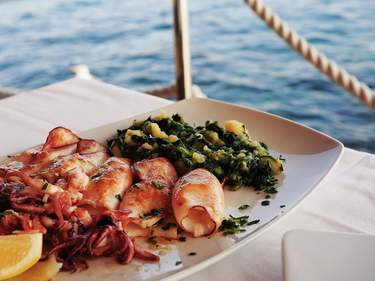
Gourmet Tour
You will visit three different adjacent countries and experience traditional local food and wines. You will visit some of the most intriguing restaurants and wineries in the area taste the delicious contrast between fine restaurants, and more traditional, authentic taverns.

Culinary Secrets of Croatia
This vintage holiday celebrates the wine and olive oil-making traditions of Croatia’s Adriatic coastline, which form the foundations of the country's Mediterranean culinary heritage. Visit world-class wineries, and sample Dalmatian delicacies as you travel south to Dubrovnik.

Balkan Extended
The Balkan Extended tour truly showcases the finest of Balkan’s heritage and natural beauty as you make your way through the 5 countries. Learn about the Serbian Athens, climb the splendid Old Bridge in Mostar, observe Slovenia's water castle and dive into the pearl of Croatia's beauty in Istria.
Chances are you’ll be looking at a combination of these things during your trip. So, for a taster of everything, the best time of year to visit Croatia is early or late summer. You’ll sidestep the hottest months of the season and it’ll be less busy all round.
Inland it’s a climate of contrasts, with sweltering temperatures in mid-summer, and freezing winters. The coast, however, experiences a Mediterranean climate – that is to say, hot in summer, mild in winter. So, if you’re planning to visit Croatia it’s worth taking a closer look at the country’s weather patterns.
Visiting Croatia in March–mid-May
Spring is sprightly by mid-March. It’s warm and dry, which makes it the best time to visit Croatia for cycling, hiking and sightseeing. Also, locals are likely to be particularly welcoming at this time of year – before the tourism season takes off again.
Easter is an important marker on the festival calendar, with religious processions in full swing on the islands of Hvar , Korčula and in many other parts of Croatia. In April, Zagreb hosts the Music Biennale festival (every odd-numbered year), showcasing contemporary classical music by top international artists.
Easter aside, April is also the best month to travel to Croatia for a shoulder season flight at bargain prices, and enjoy a city break.
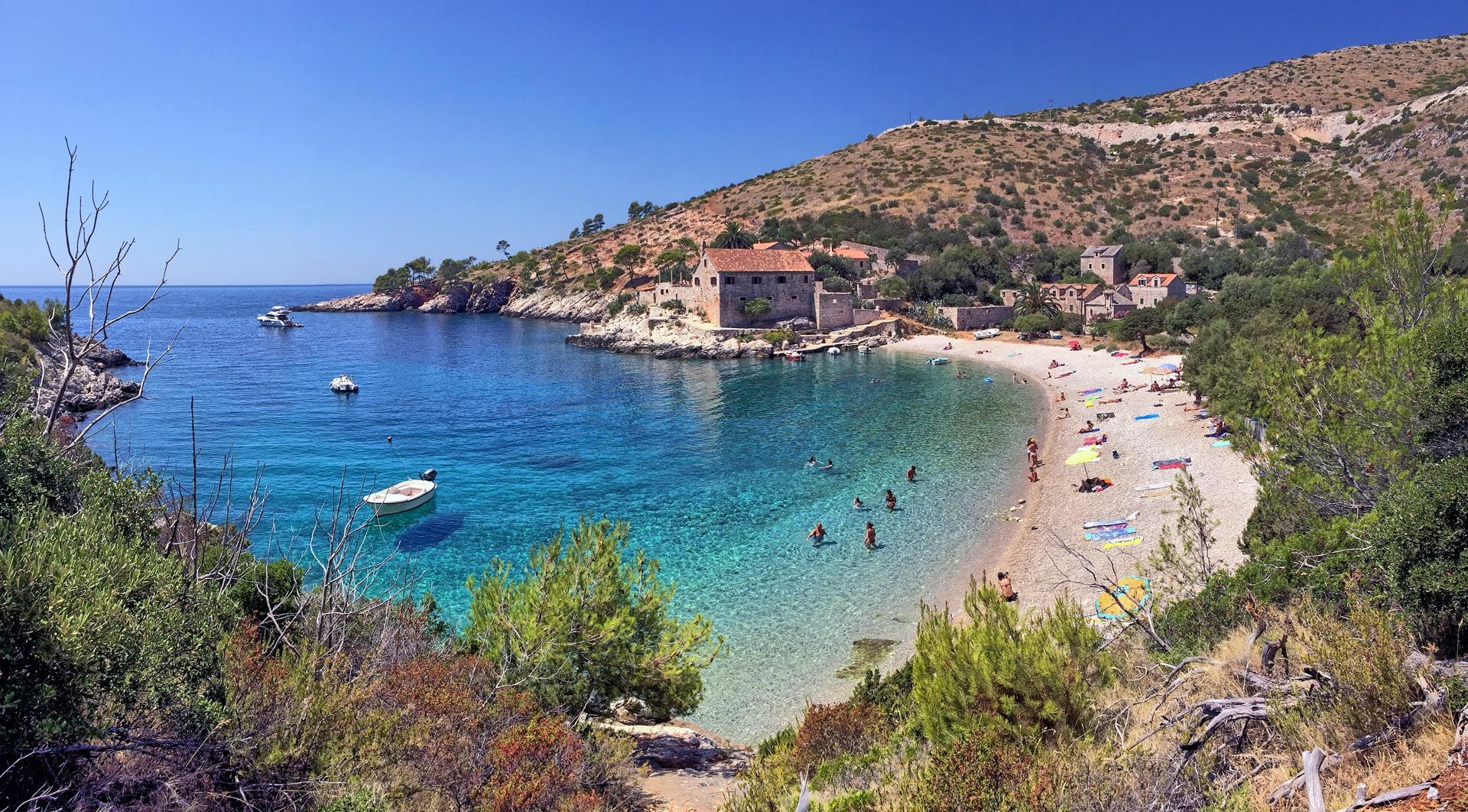
Hopping over to the island of Hvar © Shutterstock
Visiting Croatia in late-May and June
The early summer months are perfect for sunbathing: balmy temperatures lie between 23-27°C on the Adriatic coast, yet beaches are devoid of the crowds that appear as soon as school’s out. And by mid- to late May it can be warm enough in southern Dalmatia to swim in the sea. You’ll also have more stamina for sightseeing – before temperatures soar – and fewer people makes travelling between sights easier. For a smorgasbord of activities, this is perhaps the best time to visit Croatia.
Visiting Croatia in July and August
This is peak season on the Adriatic, drawing foreign travellers, as well as Croats to its sunny sands. And if you like to combine beach action with a buzzing café culture this is the best time to go to Croatia. However, with soaring mid-summer temperatures on the coast (and inland), you may want to limit the amount of sightseeing you pack in.
Island hopping off the coast of Croatia is a big draw. In peak season you’d do well to arrive at ports early to get at the front of the queue for ferries. Also, bear in mind that accommodation soon fills up at the height of summer along the coast and islands, and facilities can be overstretched.
As most head for the coast, cities in the hotter interior of the country are pretty dormant this time of year, with little happening in the way of cultural or social activities. However, the relative quiet is ideal for a trip to take in the magnificent scenery at Croatia’s inland national parks, such as Plitvice Lakes , Risnjak and Northern Velebit.
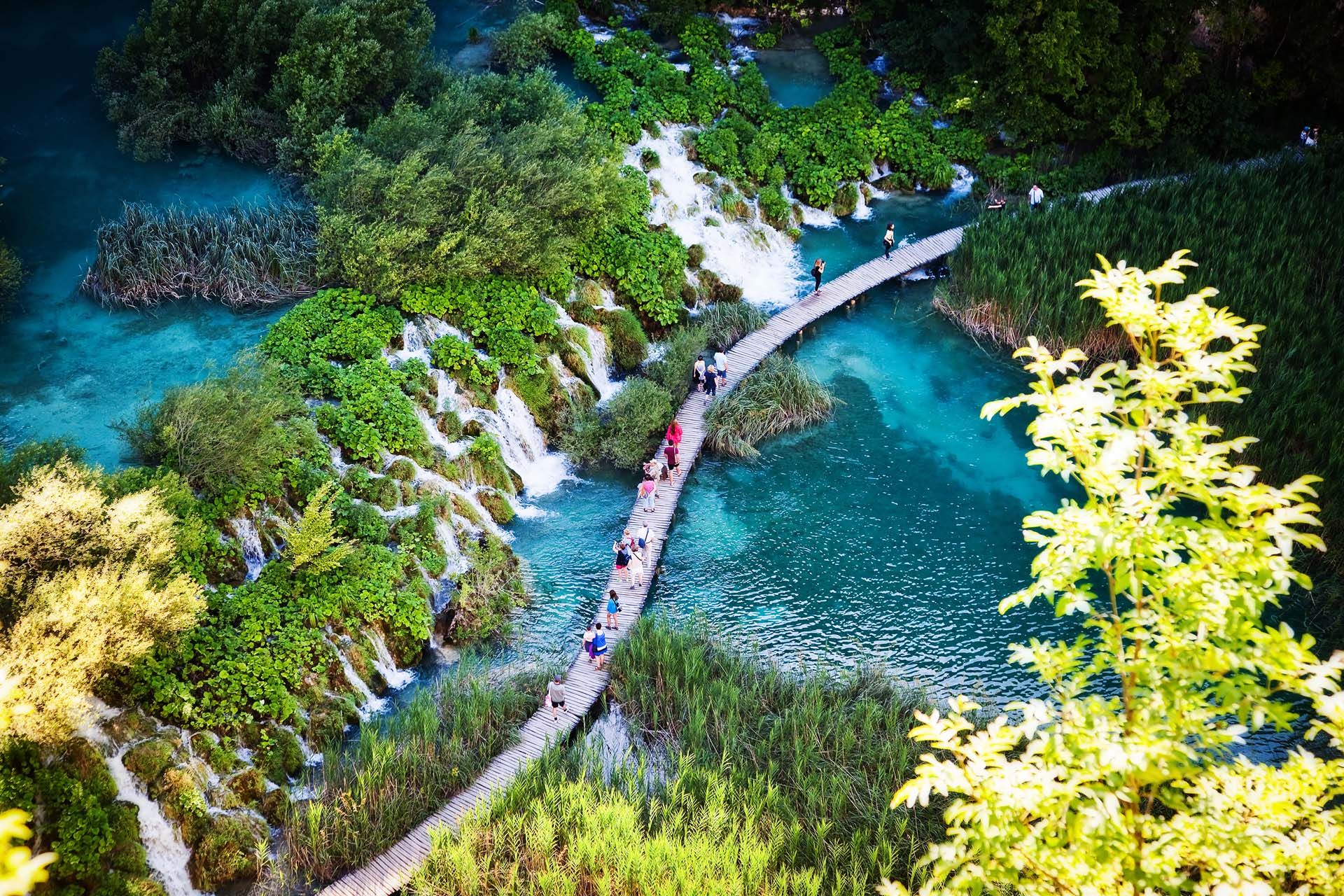
Waterfalls at Plitvice Lakes © Shutterstock
Croatian culture heads for the coast in summer. Almost every Adriatic town organizes a cultural programme, usually featuring outdoor concerts of pop, classical music or folk. And Croatia has quite a reputation for hosting some of the best and diverse music festivals in Europe, which are in full swing by July. Read our summer festivals section for a round up of events, or check out our annual calendar for a full list.
Visiting Croatia in September – November
September is the best month to visit Croatia for weather warm enough for idling on the beaches and swimming in the sea, and for island hopping – without the summer crowds. But the end of the month marks the end of the season and many islands close their bars and restaurants for the winter.

Kornati Islands © Shutterstock
It’s naturally much quieter throughout the country during the autumn months. This is, perhaps, the best time to travel to Croatia to enjoy inland Istria and national park areas, like the Plitvice Lakes and the River Krka . You’ll get to see foliage in full colourful glory and visitor numbers are low.
Come October the temperature of the Adriatic Sea is still warm enough to enjoy watersports, but coastal towns can be very quiet indeed, and many hotels and tourist attractions may well shut up shop for the winter. The cooler temperatures are better suited for pursuing outdoor activities, such as trekking and mountain biking. But don’t forget to pack wet weather gear and a snug extra layer, as it’s a rainier time of year and temperatures noticeably dip.
Visiting Croatia in November – February
Given the innocuous winters on the Adriatic coast, this can be a good time for urban sightseeing in historic centres such as Zadar , Split and Dubrovnik . And budget travellers may find this the best time to visit Croatia for huge savings on hotel prices – over 50 percent on the Adriatic. cheaper than in peak season. Winters inland are a different kettle of fish entirely: snow is common and transport in highland areas is frequently disrupted as a result – though it can also be a picturesque backdrop to sightseeing.
Christmas in Croatia used to be a quiet affair as far as tourism goes, but the wonderful Christmas market in Zagreb has been enticing ever more visitors to the capital over the festive period. It’s a magical scene of cosy candlelight, little wooden huts selling gifts, alongside traditional cuisine and mulled wine, and outdoor concerts.
Dubrovnik comes to life in the first week of February with the Feast of St Blaise festival. Processions and pageantry, concerts and theatrical performances, honour the city’s patron saint.

Winter festival in Dubrovnik © Shutterstock
Croatia offers an increasingly crammed festival calendar, with rock and DJ events, annual beach parties, niche art gatherings and folksy fairs taking place up and down the Adriatic throughout the summer. The bulk of the ‘serious’ cultural festivals take place in Zagreb in spring and autumn. However, Dubrovnik, Split and Rijeka offer a lot in the way of heavyweight drama and music, and almost every region of the country offers a film festival of one sort or another. In addition, the Croatian year is peppered with religious holidays, featuring church processions and celebratory feasting.
So, if you’re wondering when is the best time to visit Croatia for one of its many festivals, here is a selection to help you decide, followed by a full calendar of events.
Please note that the current coronavirus situation means some events may be postponed or cancelled. Check individual events before booking your trip.
This is a selection of the best annual cultural events, including film, theatre, classical music and folk festivals, taking place in Croatia.
- Zagrebdox : International documentary film festival. Feb
- Carnival ((Karneval; fašnik; pust): Processions and masked revelry in towns all over Croatia. Rijeka, Samobor and Velika Gorica (just south of Zagreb) host the biggest events. Climaxes on Shrove Tuesday (or weekend preceding it). Feb/March
- Easter : Processions in many parts of Croatia, especially on the islands of Hvar and Korčula. April
- Motovun : One of the biggest and most popular film festivals. Usually 5-6 days in July/Aug
- Animafest : Animation film festival of high-art seriousness – and post-show partying. June
- Music Biennale : Cutting-edge contemporary classical work. April-Sept; odd-numbered years.
- Contemporary Dance Week : Zagreb; May/June
- Split Summer : Rivals the Dubrovnik Festival for high-culture stakes. Top-notch music and theatre. June
- Rab Fair : Medieval extravaganza, with parades, archery contests, feasting and merriment. July
- International Folklore Festival , Zagreb: Best place to see songs and dances from all over the country. July-Aug
- Dubrovnik Summer Festival : Important classical music and drama event, much of it performed in squares and courtyards of the Old Town. 6 weeks, beginning early July
- Pula Film Festival : Feature films screened in the Roman amphitheatre. July
- Omiš Klapa Festival : The biggest of the festivals celebrating traditional choirs (klape). July
- St Donat’s Musical Evenings : A medieval church and other venues in Zadar host performances by classical musicians. July/Aug
- Kastav Cultural Summer : Include music, art, theatre, film and literary events in the streets and squares of Kastav, near Rijeka. July/Aug
- Osor Music Evenings : Classical music, in historical buildings and squares of Osor, on the island of Cres. July/Aug
- Festival of World Theatre : Performances from leading international theatre companies. Zagreb; Sept
- St Martin’s Day : tasting the first wines of the season – often to excess. Nov
- Zagreb film festival : Promoting new international filmmakers. Nov
- Advent in Zagreb : The best in Christmas markets, with mulled wine, traditional gifts, music, and performances. Dec
Croatia has muscled its way into the European party calendar in a major way. From late June to early September there’s a packed schedule of events, and big-name DJs perform every weekend at the dance clubs along the Adriatic coast.
Please note that the current coronavirus situation means some events may be postponed or cancelled. Do check individual events before booking your trip.
- Hideout : A long weekend of cutting-edge electronic music on Pag island’s Zrće beach. June or Sep
- InMusic : A three-day rock and indie fest at Lake Jarun, Zagreb, with sets from leading international bands and DJs. Late June
- Fresh Island Festival : A week-long bash of hip hop, Afrobeats, R&B and more at Zrće Beach, on the island of Pag. July
- Love International : Electronic music with DJ’s doing their thing, at this dream setting at Tisno on the Adriatic. June
- Ultra Europe : Electronic music festival with leading names takes place in the Park Mladeži stadium in Split. July
- Seasplash : Reggae festival at Martinska pier and beach, Šibenik. July
- SuncéBeat : Spin-off of the UK DJ event the Southport Weekender, this festival celebrates disco, house, soul, and R&B at the Garden site at Tisno. July
- SuperUho : Alternative music and indie-rock at an idyllic shore-side site just outside Primošten. Aug
- Moondance : Big names on the techno scene, as well as underground artists, in Trogir’s historic and atmospheric Kamerlengo fortress. Aug
- Sonus : A long weekend of cutting-edge DJ-ing on Zrće, Pag island’s party beach. Aug
- Soundwave : A long weekend of partying with major international DJs at Tisno festival site. Aug
- Dimensions : Experimental dance music at Fort Punta Christo near Pula. Aug
- Špancirfest : The centre of Varaždin comes alive with performances, pop, rock, and folk concerts. Aug

View over Split © Shutterstock
January–March
Snow Queen Trophy : World Cup downhill skiing on Mount Sljeme, with a big-screen broadcast on the main square. First and second weekends in Jan; Zagreb.
Feast of St Blaise : Processions and pageantry in honour of Dubrovnik’s patron saint. Feb 3; Dubrovnik.
Carnival : (Karneval; fašnik; pust). Processions, fancy dress and festivities in Rijeka, Velika Gorica and Samobor : Shrove Tuesday or weekend preceding.
Zagrebdox : A feast of documentary films from around the globe, with a packed week of screenings. Late Feb/early March; Zagreb.
April – May
Easter : Religious processions on the islands of Hvar, Korčula and in many other parts of Croatia. April or late March.
Music Biennale : Ten days of contemporary classical music featuring new work by major international composers. Every odd-numbered year; Zagreb.
Days of Croatian Film : Major review of Croatian films made during the previous twelve months, including features, shorts and documentaries. If you are on the lookout for new talent, this is the place to find it. Zagreb.
Feast of St Domnius : Church processions, craft fairs and feasting. May 7; Split.
Subversive Film Festival : A wide range of films and lectures on contemporary political topics, followed by the usual after-party drinking. Zagreb.
Roč Accordion Festival : Accordion bands from Croatia and beyond. Second weekend in May; Roč.
Festival of One-Minute Films : Exactly what it says in the title, with plenty of eccentric, experimental work. Late May; Požega.
Jewish Film Festival : A week of feature films, documentaries and post-screening concerts addressing wider issues of race and tolerance. Co-founded by Holocaust survivor and Oscar-winning producer Branko Lustig. Late May; Zagreb.
Festival of the European Short Story : Engaging and accessible lit-fest attracting major international participants (and big-screen English-language translations). A two-centre festival based in Zagreb and at least one Adriatic city. Late May/early June.
Cest is d’Best : Live bands and street entertainment on stages throughout the city centre. Early June; Zagreb.
Mediterranean Film Festival : New shorts and features from the Mediterranean region, screened in the open-air cinema behind Split’s Bačvice beach, with an accompanying after-show DJ programme. Early Jun; Split
Strossmartre : Summer-long sequence of gigs, puppet shows and open-air art in Zagreb’s Gornji grad. June to early Sept; Zagreb.
Animafest : Among the animation world’s most important and longest-running festivals, screening a week’s worth of commercial, arty and edgy films. Early June; Zagreb.
Contemporary Dance Week : Croatia’s premier dance event, with a strong contemporary edge. June; Zagreb.
Dan-D (“D-Day”): A long weekend devoted to contemporary design, with local creatives displaying their wares and DJ events in the evening. Mid-June; Zagreb.
Summer Nights : Classical music and drama in a variety of indoor and outdoor venues. Mid-June to late July; Rijeka.
InMusic : Three-day rock-and-pop fest on the shores of Lake Jarun, featuring major international bands and DJs. Attracting a daily average of 30,000 people, it’s big enough to feel like a major event but small enough to preserve a laidback vibe. Late June; Zagreb.
International Children’s Festival : Puppet shows, street entertainers and musicals, with a young audience in mind. Late June/early July; Šibenik.
Hideout . Festival of cutting-edge DJ music takes over Zrće beach for a long weekend. Late June; Novalja, Pag island.
Fantastic Film Festival : Week-long event devoted to fantasy, horror and sci-fi genres, with open-air screenings and DJ events. Late June/early July; Zagreb.
Dan-D ("D-Day"): A long weekend devoted to contemporary design, with local creatives displaying their wares and DJ events in the evening. Early July; Zagreb.
Kastav Summer of Culture ( Kastafsko kulturno leto ): Concerts in the streets and squares of Kastav, near Rijeka. July/Aug.
St Donat’s Musical Evenings : Classical soloists and ensembles performing in an early medieval church. Early July to early Aug; Zadar.
Đakovo Embroidery : Folklore groups from all over Croatia celebrate traditional costumes, music and dance. Early July; Đakovo.
Omiš Klapa Festiva l : Traditional choirs ( klape ) from all over the country, with prizes for the best performances. Omiš.
Dubrovnik Summer Festival : Prestigious classical music and theatre event that makes full use of Dubrovnik’s historic buildings and atmospheric open spaces. Early July to late Aug; Dubrovnik.
Electric Elephant : Five-day fest for connoisseurs of quality dance music old and new, on the dedicated seaside festival site first established by the Garden Festival. Mid-July; Tisno.
Ultra Europe Festival : Mega-popular DJ festival with leading names entertaining the masses in the Poljud Stadium. Mid-July; Split.
Courtyards : The semi-hidden courtyard spaces of Zagreb’s Upper Town are opened up to the public in a week-long festival of live music, wine and food. July; Zagreb.
Vanka Regule (“Outside the rules”): Sports- and activity-based festival with an imaginative range of everybody-can-join-in competitions, followed by outdoor gigs. Late July; Sutivan, Brač.
Stop Making Sense : The cream of cutting-edge London club culture descends on Dalmatia for another long weekend of round-the-clock partying. Mid-July; Tisno.
International Folklore Festival : Highly enjoyable display of ethnic music and dance from all over Croatia, plus a range of international guests. Mid- to late July; Zagreb.
Seasplash : Reggae fest in the Punta Christo fortress, just north of Pula. Late July.
Osor Music Evenings : International chamber music. Late July to late Aug; Osor, Cres.
Pula Film Festival : The country’s annual crop of feature films, screened in the Roman amphitheatre. Pula.
Rab Fair : Huge medieval pageant featuring parades, archery contests, fine victuals and hearty drinking. July 25, 26 & 27; Rab.
SuncéBeat : The Dalmatian offshoot of well-known UK DJ event the Southport Weekender, held at the Garden site at Tisno. Late July; Tisno.
Motovun Film Festival : High-art film festival that also functions as a five-day open-air party. Late July/early Aug; Motovun.
Split Summer : Opera, orchestral music and a host of other high-cultural delights, with many performances taking place in Split’s ancient piazzas and squares. Mid-July to mid-Aug; Split.
Supertoon Festival : Hugely enjoyable animation fest with outdoor screenings of kids’ films, music videos and arty stuff. Late July/early Aug; Šibenik.
Soundwave : Another long weekend of DJ-orchestrated bliss at the Tisno festival site; early Aug
Saljske užance : Seafood feasts, donkey races, island madness. First weekend in Aug; Sali, Dugi otok.
Alka : A sort of medieval joust held in celebration of the 1715 victory over the Ottomans. Early Aug; Sinj.
Neretva Boat Marathon : Teams in traditional rowing boats race through the Neretva delta towards the sea. Second Sat in Aug; Metković.
Days of Diocletian : Locals dress up as ancient Romans for a night of city-centre swords-and-sandals partying, symbolically welcoming third-century Emperor Diocletian back into town. Mid-Aug; Split.
Tilting at the Ring : Competition in which horsemen attempt to spear a ring on the end of a lance. Third weekend in Aug; Barban, Istria.
Špancirfest : One of the few festivals to light up inland Croatia during the month of Aug, Špancirfest takes over the centre of Varaždin with a week of outdoor variety performances alongside pop, rock and folk concerts. Late Aug; Varaždin.
Vukovar Film Festival : New features from southeastern European countries, screened at various outdoor venues around town. Late Aug; Vukovar.
Dimensions : Eclectic, experimental dance music festival at Fort Punta Christo near Pula. Late Aug; Pula.
Outlook : A spectacular treat for fans of jungle/dub/dubstep and beyond, with sound systems and live music stages in and around the Punta Christo naval fort. Early Sept; Pula.
PIF International Festival of Puppet Theatre : Puppet productions from all over Europe. Mid-Sept; Zagreb.
Korkyra Baroque Festival : Ten-day festival of early music, with many of the performances taking place in historic churches. Early to mid-Sept; Korčula Town.
Hartera : Weekend rock-fest in an adapted old factory complex. Sept; Rijeka.
Buzet Saturday : Gastronomic and musical fiesta dedicated to the opening of the truffle-hunting season. Second weekend in Sept; Buzet.
Festival of World Theatre : Seriously worthwhile drama festival attracting the big European names. Mid- to late Sept; Zagreb.
Split Film Festival : Shorts, documentaries and art-house films. Mid- to late Sept; Split.
Varaždin Baroque Evenings : One of Europe’s most prestigious early music events, with performances in Varaždin cathedral and other city churches. Mid- to late Sept.
International Festival of Experimental Film and Video : Moving pictures from the cutting edge. Late Sept; Zagreb.
October – December
BIT ( Blind in Theatre ): International festival for visually impaired theatre groups. Extraordinary and unique. Odd-numbered years only. Early Oct; Zagreb.
Zagreb Film Festival : Outstanding documentaries and art movies from around the world. Generates a genuine festival atmosphere: free access to the late-night DJ parties is well worth the price of your cinema ticket. Oct or Nov; Zagreb.
St Martin’s Day : Festivities in all wine-producing regions of the country, with the chance to taste and buy the season’s new produce. Nov 11 or nearest weekend.
Human Rights Film Festival : Politically engaged documentaries from around the globe, plus the inevitable after-parties. Early to mid-Dec; Zagreb and Rijeka.
Advent in Zagreb : Food stalls, rakija bars, kooky gift markets, outdoor music stages and gallons of mulled wine; venues throughout the city centre. Dec; Zagreb.
Header image: © Shutterstock
The Rough Guides to Croatia and related travel guides
In-depth, easy-to-use travel guides filled with expert advice.

Travel advice for Croatia
From travel safety to visa requirements, discover the best tips for traveling to Croatia
- Eating and drinking in Croatia
- How to get to Croatia
- Getting around Croatia: Transportation Tips
- National Parks in Croatia
- Sports and Outdoor activities in Croatia
- Travel Tips Croatia for planning and on the go
Find even more inspiration here

- Travel Tips
written by Rough Guides Editors
updated 25.05.2021
Ready to travel and discover Croatia?
Get support from our local experts for stress-free planning & worry-free travels.
- Where to stay
- Travel advice
Best time to visit Croatia
Now that you finally decided to visit Croatia, you must ask yourself when is the best time to visit Croatia? In this post, we will share information and our thoughts on the best time to go to Croatia based on weather, costs, crowds, and more.

Before I tell you the best time to visit Croatia, I am gonna tell you the worst time to visit. It’s easier to pinpoint bad times because they are fewer and because they apply to everybody traveling to Croatia.
The worst time to visit Croatia is wintertime , from November through February, and the peak travel time from the last week of July to mid-August. These two periods are the worst time to visit but for all the different reasons.
Winter because it’s cold and rainy, the majority of activities, restaurants, bars, and commerces are closed, and there is almost nobody to see around. On the other hand, in peak time, the days are too hot, there are too many people around, and while all businesses are open, the prices are sky-high.
All other times are good times for your Croatian trip. And when to visit Croatia depends a lot on your personal preferences and situation. If you travel with school-age children, you will perhaps only be able to come during the school holidays.
Table of Contents
When is the best time to visit Croatia?
Croatia seasons.
You’ll notice three distinctive seasons in Croatia. A low season in Croatia is from November through April. A shoulder-season includes a period from May to mid-June, and from mid-September through October, while a high season runs from mid-June to mid-September.
A majority of tourists visit Croatia during the high season. The peak travel time lasts three weeks including the last week of July and the two first weeks of August. This peak time is, along with the low season, the worst time to visit Croatia.
Low season – November through April

Visiting Croatia over the winter, from November to April? No worries, below we explain what you can expect regarding the weather, activities, prices, and more.
But, before we go in detail, let me tell you something (shhh!). I would never recommend you to visit Croatia from November to March.
In the low or winter season, Croatia goes very quiet. Many hotels, restaurants, and activities are closed for business. Beaches are completely empty and unattended. Coastal towns, bustled with people and life during the summer, go dead in winter. The daylight is also extremely short. In winter it already gets dark around 4.30 pm.
We live in a small coastal town , and believe us when we say, when we go for a walk after dinner (6 pm) we can count on the fingers of one hand the people we will eventually pass by.
Before moving here I have many misconceptions about Croatia, and the climate was just one of them. I imagined the climate in Croatia like in Costa Blanca or Cote d’Azur. Unfortunately, while similar in some ways, it’s not the same. Zagreb gets really cold, foggy, and humid. It can also snow. Istria gets lots of gray rainy days. Weather-wise, Dalmatia it’s the best area of Croatia to visit in the low season. However, Dalmatia can also get very cold, especially when the northeast wind bura blows. It brings bright sunny but cold days.
If this is the only time you have available, then you better make it the best time to travel to Croatia for you. And our tips below will help you to do so! Visiting Croatia in winter has its charm and advantages.
Tips for visiting Croatia in the low season?
Zagreb, Split, Rijeka, Pula, and Dubrovnik are good places in Croatia to base yourself during the wintertime. Although to be honest, only Zagreb is really buzzing in winter. The other four destinations are ok because they have enough attractions to explore; they are centrally located to make day trips; they have a good choice of hotels open in winter and enough restaurants where you can have a good lunch or diner.
Have a car! A car gives you so much flexibility to go where you want and when you want. Besides, the cost of car rental is so low in winter. This way you can do many day trips and visit many beautiful places in Croatia.
You will be able to capture some awesome photos since your photo shooting won’t be disrupted by other people walking by.
Benefit from the amazing discounts that hotels offer during the low season. You can stay in a 5star hotel for as little as 100€ a night for two persons with breakfast included. The same room will cost you at least 350€ in the high season. And you can even pay less if:
- you travel during the working week (Mon-Fri)
- you book your stay in advance, and
- and if you stay longer in one hotel (at this time of the year, a stay of 3 to 4-nights is considered a long stay)
If you prefer to stay in apartments, just contact the owners and negotiate the price down. The demand is very low in winter and you should normally be able to get yourself a great deal.
Take some downtime with spa and wellness promotions that hotels also run during the winter. That room rate mentioned above sometimes also includes a 30-minute neck and shoulder massage. Try to beat that!
Events in low season
There are a couple of events taking place in the low season that you might want to take note of.
Olive Oil Fair in Vodnjan , takes place in early November. It is a celebration and a showcase of the young olive oils of that year’s harvest. Harvest in Istria is really early, in late September or early October, so in November the young oil is ready to be consumed. You can sample oils from various local producers as well as other local and homemade products like fig cakes, prosciutto, honey, cheese, wines, grappa, and alike.
Advent in Zagreb is an annual event taking place in Zagreb from the end of November until the 7th of January. The entire town turns into a Christmas fairytale with tons of fun, concerts, workshops, exciting street food, mulled wine, craft beers, and Christmas markets.
Rijeka Carnival is the best and most popular carnival in Croatia. It takes place in February.
In February, you can also partake in St. Blaise Festivities taking place in Dubrovnik.
Final thoughts on visiting Croatia in winter
Winter is definitely not the best time of the year to visit Croatia. But, it is ok if you would like to experience Advent in Zagreb (it’s only at Christmas time!) 0r if you have no other choice, but to visit in winter. Hey, you might even get lucky, and if it snows, you can go skiing on Sljeme Mount near Zagreb, or Platak near Rijeka.
If you have no choice but to visit Croatia in winter, then December is the best month to visit Croatia. At least all towns have Christmas markets and something going on.
Also, before we forget, Plitvice Lakes are beautiful in winter. Yes, they are not completely accessible due to the high levels of water, but you will have peace and quiet. You won’t need to battle your way in this amazing park through groups of other people and their selfie sticks.
Winter can be the best time to travel to Croatia for foodies. Restaurants are at their best at this time of the year. Fish and seafood are in abundance. In early August, at the heart of high season in Croatia, many fish species in Adriatic can’t be fished. Shhh, we have never told you this!
Shoulder season – May to mid-June, mid-September through October
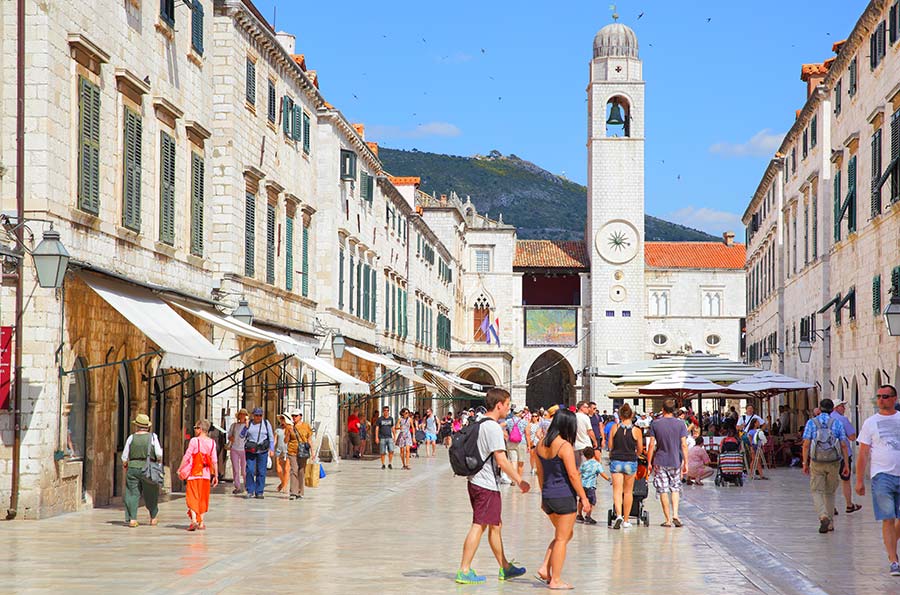
Shoulder season, from May to mid-June, and from mid-September through October, is the best time of year to go to Croatia. Especially if you do so in late September or early June.
All activities, restaurants, and hotels are already open and receiving guests. The weather is generally ok although it can be unpredictable at times especially through May and late October. You can expect the temperatures in low to mid 20C, with nights a bit chiller.
Beaches are attended, clean and neat, already receiving some swimmers, although not too many. You will have all space you need for yourself on the beach. The sea temperature still isn’t optimal for swimming. However, early June and late September can be ok. At least, it is for us. We always swim late into September.
Since it isn’t too hot nor too rainy, it’s a perfect time in Croatia for sightseeing.
The rates are more expensive than in winter, but they are still super-discounted if compared with summer. So you can still secure great holiday deals on accommodation in Croatia .
Shoulder season is the best time to visit Croatia for foodies. There are so many awesome food and wine events taking place throughout the country at this time of year.
Tips for visiting Croatia in the shoulder season
Whether you prefer small coastal villages for your base, changing destinations every day, or staying in big towns, all the itineraries will work fine. All businesses are open and running. You will already see a fair share of tourists all over the country.
Since the weather in May and late October can be unreliable and temperatures can suddenly drop, pack a wind jacket, long sleeves t-shirt, and long pants.
It’s great to have a car during your visit in the shoulder season. The weather is perfect for day trips. Driving is easy and the traffic on Croatian roads is still low at this time of the year.
Also, you can take advantage of coach tours if you are not comfortable driving.
We also recommend that you add at least one island to your shoulder season itinerary. At this time of the year, almost all ferry lines are operational, and the prices are still not as high as in the high season.
Germans are the number one visitors in Croatia. This is why many hotels adjust their rates to the German school holidays. Anyways, Germans have main school holidays between the Whitsunday and Corpus Christi weekend. They are sometimes in May and sometimes in June, depending on the time of Easter. If these holidays are in May, then hotels will run special deals for stays in June. If these holidays are in June, then you can expect to secure a good discount in May. If you are flexible, it’s good to shop around.
The same is true for the 1st of May. Hotels always get full on the weekend or a week around the 1st of May. So if you are trying to save, avoid traveling on the 1st of May.
Hotel rates also drop significantly in mid-September . You can find a nice seafront apartment for as little as 40 € a day in mid-September and October.
Events in the shoulder season
Another great reason to visit Croatia in the shoulder season is an abundance of all kinds of food events and festivals. Below we list just some of them to give you an idea of what to expect.
Zagreb Beer Fest takes place at the end of May in the center of town, in the park, at the Trg Franje Tudmana Square. Lots of live concerts, good music throughout, a great choice of Croatian beer , free admission, and a nice vibe make Zagreb Beer Fest one of the most sought-after beer events in the country.
The last Sunday in May in Istria is reserved for Open Cellars Day . Participating wineries open their cellars for free wine tasting.
If you are visiting Croatia in the fall you will like to know that white truffles , the most precious and most expensive fragrant fungi are in season from late September to January. If you like this rare delicacy, head to Istria during your time in Croatia.
Good Food Festival in Dubrovnik takes place at the end of October. You can taste traditional Croatian food , participate in a culinary tour, or learn to prepare some of Dubrovnik’s delicacies. The highlight of the festival is continuous food stands that spread the entire length of Stradun, Dubrovnik’s main pedestrian street in the old town.
Final thoughts on visiting Croatia in late spring and early fall
The shoulder season is the best time to go to Croatia. If you are flexible with your travel dates, then try to visit Croatia in the second half of September, or early June.
You can visit all landmarks, even the most popular destinations, without running into too many people. Sure, in Dubrovnik or Split, even in the shoulder season, you will still see lots of cruise ship passengers. However, there will be fewer other visitors, making the overall number of tourists much more acceptable.
Also, the weather plays a big part in making the shoulder season the best time of year to visit Croatia. When it is very hot like it gets in July and August, then it is as uncomfortable to do sightseeing as it is when it’s raining or snowing. But in the shoulder season, temperatures are just perfect for sightseeing and exploring Croatia.
If you decide to go to the beach you won’t need to fight for your space at the beach. Or, God forbid, wake up at 5 am to secure your beach spot with a towel. No, this you will do in summer (just kidding! NOT).
High season: mid-June to mid-September

A majority of tourists visit Croatia during the high season. The high season lasts from mid-June to mid-September. And the peak travel time is from the last week of July until mid-August. The high season is one of the best times to visit Croatia, as long as you avoid these three peak weeks.
At this time, Croatia is in full swing. All activities, restaurants, hotels, and day tours are running.
It is the best time to go to Croatia for the beaches. The weather is hot and sunny. You can expect temperatures in high 20C to mid 30C. The sea is warm and perfect for swimming. The sea temperatures are around 24C.
The high season is also a great time for Croatia if you look for partying, clubbing, and music festivals. There are many festivals taking place all along the Adriatic coast and Zagreb at this time of year.
So, in short, the high season is the best time to travel to Croatia if you are interested in beaches, partying, and hot weather.
But, the high season also has its downsides.
Prices are sky high! Expect to pay at least 90€ per day for two-person accommodation. And this is on a budget end. If you stay in a 4star hotel, you’ll pay around 220 € for a double room with breakfast, and that same room in a 5star hotel will set you back at least 350 € a night.
There are people everywhere and queuing is a common sight. Even more so in top destinations like Dubrovnik , Split , Hvar Town, Rovinj , Porec , etc… And on a rainy day, when everybody goes sightseeing instead of lounging at the beach, the traffic congestions are unbearable.
Access to the main attractions gets completely blocked. And to find parking is a real adventure.
We live in a small village 3 km away from Porec. But can you believe that in July and August we don’t even go to the town? Because there are so many people and cars everywhere that we don’t even want to bother going there. It is that bad!
The most popular beaches in Croatia, you know those that you saw on all promotional material for Croatia, are jam-packed. People wake up at 5 am and then go to the beach to put their towels. These people are the worst! (If you are one of them, please stop doing it!). In some beach towns, the municipality even started removing and confiscating those towels.
Tips for visiting Croatia in the high season
If you are planning to visit Croatia in the high season, we recommend that you try to avoid the peak three weeks of the high season: the last week of July and the two first weeks of August.
If you come in late June to mid-July or late August to mid-September , you might get the best of both seasons, shoulder, and high season. There are still lots of tourists around, but less than in the peak period. The weather is still hot, but a little bit less burning hot than in peak times. And the sea is warm and perfect for swimming.
In Croatia, July and August are extremely hot . Make sunscreen, a hat, and a bottle of water your permanent daypack items.
If you plan to swim in Croatia, pack water shoes. You’ll walk easier on Croatian pebbly and rocky beaches.
You know those popular beaches you’ve seen all over Instagram. Yeah, forget them in high season. Instead, ask locals for their favorite beach (not the most beautiful beach, everybody, and their mother is already there!). This way you might end at less crowded beaches and enjoy your time there much more.
Or, rent a boat and make your way to some of the small islands and islets within easy reach from your destination. In Croatia, islets are a common sight.
Beat the crowds and the heat by waking up early . Try to do all your sightseeing as early in the morning as possible. This usually means until 9 am for must-do sights, and before 10.00 am for other sights.
Events in the high season
The high season is full of events and festivals. We have a separate post on the Best festivals in Croatia if you want to read that. Here we shortlist just some of them to give you an idea.
INmusic Festival is Croatia’s largest open-air festival. It takes place in Zagreb, at Lake Jarun, in late June already for 15 years. Previous lineups included Massive Attack, Florence + The Machine, Jamiroquai, Franz Ferdinand, and many more. Since 2107, NME lists InMusic as one of the world’s best festivals.
Fresh Island Festival takes place yearly for a week in the first half of July, on Pag, Croatia’s popular party island. The exact location of this hip-hop festival is Novalja Beach, and Rock’s Beach Club, Papaya, Aquarius, and Kalypso clubs. The previous lineups included Snoop Dogg, Iggy Azalea, Wiz Khalifa, French Montana, Chris Brown, and many more.
Outlook Origins takes place at the end of July, beginning of August. Relocated for 2021 from Fort Monte Christo and Pula Arena to Garden Tisno and St Michael’s Fortress in Sibenik, the Outlook festival brings the best dubstep, reggae, jungle, and drum & bass lineup. The festival’s renowned opening festival included names like Bonobo, Jurassic 5, The Gentleman’s Dub Club, Grandmaster Flash, etc…
Ultra Europe takes place in Split at the beginning of July. It is the biggest and the most visited summer music festival in Croatia. Stadium Park Mladezi plays the main stage for three days, but there are many pre-and after-parties on popular Croatian islands. The previous lineups included Armin van Buuren, DJ Snake, Tiësto, Carl Cox, Dubfire, Afrojack, and many more.
There are many more festivals in Croatia taking place during the high season, like Hideout , Love International , SunceBeat , Dimensions , etc…
We hope this post help you get a better idea about the best times to visit Croatia! If you have any questions, leave them in the comments section below.
Frankaboutcroatia.com is a participant in the Amazon Services LLC Associates Program, an affiliate advertising program designed to provide a means for sites to earn advertising fees by advertising and linking to Amazon.com and affiliated sites. This post might also contain affiliate links to other sites, like accommodation or activities. And if you purchase anything using these links, we earn a little commission with no extra costs for you. Thank you for supporting our blog! Read full disclaimer here.
Home / Croatia Travel Tips / Best time to visit Croatia
1 thought on “Best time to visit Croatia”
I would definetly recommend going in September to get the real experience. This summer was particular so it felt like autumn already in late August. But there is something special and calming about September sun that is hard do explain.
Leave a Comment

The Best Time To Visit Croatia (And The Worst!) 2024
Wondering when the best time to visit Croatia is?
If you are planning a trip to Croatia, you might be wondering when the best time to go is. Croatia is a beautiful country located in Eastern Europe, known for its stunning beaches, historical cities, and breathtaking national parks.
The country’s popularity as a tourist destination has been increasing in recent years, and with good reason.
Croatia has a Mediterranean climate, with hot summers and mild winters. However, the weather can vary significantly depending on the region you are visiting. Coastal areas are generally warmer and more humid, while inland regions can be cooler and drier.
Apart from the weather, the crowds can also play a significant role in determining the best time to visit Croatia. During peak tourist season, which is typically from June to September, the coastal cities and islands can become quite crowded, and prices for accommodation and activities can skyrocket.
We visited during July and August when summer was in full swing, and we were also there in September when the weather had started to turn a little and there were a few big storms and cooler days.
In this post, we will explore the best time to visit Croatia, taking into consideration the weather, the crowds, and the activities available. We will also discuss the worst time to visit Croatia and why you should avoid certain months.
With that said, let’s dive into the best time to visit Croatia and what you can expect during your trip.

As an Amazon Associate, we earn from qualifying purchases. We also earn from other affiliate programs. This means we may receive a small commission on products purchased through our links at no extra cost to you.
Table of Contents
Is croatia worth visiting, what is the best month to visit croatia, what time of year has the best weather in croatia, the best time to visit croatia for watersports, the best time to visit croatia for partying, when do most tourists visit croatia, the cheapest time to go to croatia, what is the rainy season in croatia, the worst time to visit croatia, frequently asked questions, top tips for visiting croatia.

We would highly recommend you visit Croatia. Croatia is a beautiful country that offers a wide range of attractions for travelers. Some of the reasons why Croatia is worth visiting include:
- Natural Beauty: Croatia is home to some of the most stunning natural scenery in Europe, including national parks, beaches, lakes, and waterfalls. Plitvice Lakes National Park and Krka National Park are two must-visit destinations in Croatia for nature lovers.
- Rich Culture and History: Croatia has a fascinating history and a rich cultural heritage. The country is home to numerous historical sites and museums, such as the Dubrovnik City Walls and the Diocletian’s Palace in Split.
- Delicious Food and Wine: Croatian cuisine is diverse and flavorful, influenced by its Mediterranean and Central European neighbors. The country is also known for its excellent wines, particularly the red wines from the Dalmatian coast.
- Affordable Prices: Compared to other European countries, Croatia offers relatively affordable prices for food, accommodation, and activities.
- Friendly Locals: Croatians are known for being friendly and welcoming to tourists. We met so many locals keen to share their history and culture with us. Croatia is a relatively safe place to travel, even as a solo vacationer.
Overall, Croatia is a great destination for travelers looking for a mix of natural beauty, history, culture, and delicious cuisine and we wouldn’t hesitate to return!

The best time to visit Croatia depends on what you’re looking for in your trip, so really there is ‘bad’ month to visit!
The country has a Mediterranean climate, with hot summers and mild winters. The peak tourist season is from June to August when the weather is warmest and the beaches are busiest. However, if you want to avoid the crowds and enjoy more moderate temperatures, it’s best to visit in the shoulder seasons of May-June and September-October.
May-June: This period offers pleasant weather, with average temperatures ranging from 20-25°C (68-77°F). The sea is still a bit chilly for swimming, but the crowds are smaller, and prices are generally lower than in peak season.
July-August: These are the warmest months in Croatia, with temperatures averaging around 30°C (86°F) in coastal areas. The sea is warm and ideal for swimming, but the beaches are crowded, and prices are high. We witnessed some pretty forest fires in the summer months.
September-October: This is another great time to visit Croatia when the weather is still warm, and the crowds have thinned out. The sea is still warm enough for swimming, and the prices are more reasonable than in peak season. You might get the odd storm or two though!
November-April: The winter months in Croatia are cold and rainy, with temperatures averaging around 10°C (50°F). While some attractions may be closed during this period, it can still be a great time to visit if you enjoy winter sports or cultural activities.
You might be surprised to hear it does snow in Croatia . Head inland to find ski resorts and winter activities. The holiday season in December is also a festive time to visit Croatia, with Christmas markets and other seasonal events.
Overall, the best time to visit Croatia depends on your preferences and travel style. Whether you’re looking for warm beaches, cultural experiences, or winter sports, there is always something to see and do in Croatia.

The best weather in Croatia can be experienced during the summer months of June, July, and August, when temperatures are the warmest and the sunniest days are expected.
Coastal areas, such as Dubrovnik, Split, and Zadar, have average temperatures ranging from 25°C to 30°C (77°F to 86°F) during this time.
Inland areas, such as Zagreb and Plitvice Lakes, are also warm, with temperatures ranging from 20°C to 25°C (68°F to 77°F).
However, it’s worth noting that the summer months are also the busiest and most expensive time to visit Croatia, with crowds of tourists and higher prices for accommodations and activities.
For those who prefer to avoid the crowds and enjoy more moderate temperatures, the shoulder seasons of May-June and September-October offer great weather, with average temperatures ranging from 20-25°C (68-77°F) and lower prices than in peak season.
Overall, the best time of year for weather in Croatia depends on your preferences and travel style. Whether you prefer warm beaches or moderate temperatures for sightseeing and outdoor activities, Croatia has something to offer throughout the year.

The best time to visit Croatia for watersports is during the summer months of July and August when the sea temperatures are the warmest, and the weather is ideal for outdoor activities. Coastal areas, such as Dubrovnik, Split, and Zadar, have average sea temperatures ranging from 22°C to 25°C (72°F to 77°F) during this time.
The most popular watersports in Croatia include swimming, diving, snorkeling, windsurfing, and sailing. Croatia’s long coastline offers plenty of options for watersports enthusiasts, from secluded coves and bays to lively beaches and marinas.
For windsurfing and kitesurfing, the best spots are in Bol on the island of Brač and Viganj on the Pelješac Peninsula.
Diving and snorkeling enthusiasts will find plenty of opportunities to explore the crystal-clear waters of the Adriatic Sea, with popular dive sites such as the Blue Hole near the island of Vis and the underwater caves near the Kornati Islands.
For those who prefer to avoid the crowds and still enjoy watersports, the shoulder seasons of May-June and September-October offer good conditions, with slightly cooler water temperatures but still pleasant weather and fewer crowds. The sea will be warmer in the Autumn after the summer sun has warmed it up!

The best time to visit Croatia for partying is during the summer months of July and August when the beach clubs, bars, and music festivals are in full swing, and the party scene is at its peak.
Coastal areas, such as Split, Hvar, and Zrće Beach on the island of Pag, are the most popular destinations for partying in Croatia.
Hvar is known for its lively nightlife scene, with numerous bars, clubs, and restaurants lining the waterfront promenade. Zrće Beach is a popular party destination, with several beach clubs hosting international DJs and music festivals, such as Hideout Festival and Sonus Festival.
Split is also a great destination for partying, with numerous bars and clubs in the city center and along the waterfront.

Most tourists visit Croatia during the summer months of June, July, and August when the weather is warm and sunny, and the beaches and outdoor attractions are at their best. The peak season for tourism in Croatia typically runs from mid-June to mid-September, with the busiest months being July and August.
During this time, the coastal cities and islands, such as Dubrovnik, Split, Hvar, and Brač, are particularly popular, with tourists flocking to the beaches, bars, and restaurants. The historic cities of Zagreb and Zadar also see an increase in tourist numbers during the summer months.
It’s worth noting that the peak season in Croatia can also mean higher prices for accommodations, activities, and transportation, as well as larger crowds and longer wait times at popular attractions.
If you prefer to avoid the crowds and enjoy a more relaxed vacation, consider visiting Croatia during the shoulder seasons of May-June and September-October when the weather is still pleasant, and the prices are lower.

The cheapest time to go to Croatia is during the low season, which runs from November to April, excluding the Christmas and New Year’s holiday period.
During this time, you can find significantly lower prices for accommodations, flights, and activities, making it a great option for budget-conscious travelers.
In particular, the months of November, February, and March tend to offer the lowest prices for flights and accommodations, while December and January can be more expensive due to the holiday season.
While the weather can be cooler and some attractions may be closed during the low season, there are still plenty of things to see and do in Croatia.
Zagreb, for example, has a charming Christmas market in December, while the Plitvice Lakes National Park is particularly beautiful in the winter when the waterfalls freeze over.
Overall, if you’re looking for a budget-friendly trip to Croatia and don’t mind cooler weather, consider visiting during the low season.
However, keep in mind that some activities and attractions may have limited hours or be closed altogether, so it’s important to plan ahead and check for any seasonal closures. And don’t forget to budget a little extra for activities, transport, and hotels. Tipping in Croatia is polite.

Croatia doesn’t have a typical rainy season, and rainfall is spread throughout the year. However, the autumn months of October and November can be wetter than usual, with increased rainfall and occasional thunderstorms.
The coastal regions of Croatia generally receive less rainfall than the inland areas, with the Dalmatian coast being the driest region in the country.
The mountainous regions of Croatia, including the Plitvice Lakes National Park and the Gorski Kotar region, tend to be wetter and cooler, particularly during the autumn and winter months.
Overall, while there is no distinct rainy season in Croatia, it’s always a good idea to check the weather forecast before traveling and pack accordingly. We had several days of rain during July and August, with more in September. So pack appropriately!
If you’re planning a trip during the autumn months, it’s advisable to bring waterproof clothing and shoes, particularly if you’re planning to hike or explore the outdoors.

The worst time to visit Croatia largely depends on your preferences and travel goals. However, there are a few factors that can make certain times of the year less ideal for visiting.
For example, if you dislike crowds and high prices, you may want to avoid visiting Croatia during the peak summer months of July and August as we’ve mentioned before. During this time, tourist numbers are at their highest, and prices for accommodations and activities can be significantly higher than during the low and shoulder seasons.
Similarly, if you’re looking for a beach vacation or watersports activities, you may want to avoid visiting Croatia during the winter months of December through February when the weather is cooler, and many seaside towns and attractions are closed.
Finally, if you have a low tolerance for hot and humid weather, you may want to avoid visiting Croatia during the hottest months of July and August when temperatures can reach into the high 30s °C (90s °F). Lounging by the beach and swimming in the sea is great at this time, but we found hiking in the heat a little more challenging.
Overall, there is no one “worst” time to visit Croatia, and the best time to go largely depends on your preferences and travel style. Consider your interests, budget, and preferred travel season when planning your trip to Croatia.

Here are some of the questions we get asked the most by people who are vacationing in Croatia.
How Many Days Do You Need In Croatia?
The number of days you need in Croatia depends a lot on what you hope to get from your holiday. However, as a rough guide, a 7-10 day trip is a good amount of time to explore some of Croatia’s top destinations and attractions.
With 7-10 days, you can spend a few days exploring the historic cities of Zagreb and Split, visit the stunning Plitvice Lakes National Park, and spend some time relaxing on the beaches of the Dalmatian coast or on one of Croatia’s beautiful islands such as Hvar, Brac or Korcula.
Of course, if you have more time and budget, you can easily spend several weeks exploring Croatia’s diverse regions, trying out its delicious food, and experiencing its rich cultural heritage. There was so much more we wanted to see after three months in the country!
If you’re planning a more relaxed trip, you may be able to get away with a shorter stay, while those looking to see as much as possible may want to plan a longer trip.
What’s The Best Way To Get Around Croatia?

There are several ways to get around Croatia, depending on your budget and travel preferences. Here are some of the most popular options:
Renting a car is a popular option in Croatia, particularly for those who want to explore the country’s many scenic coastal and rural routes. Car rental companies are widely available at airports, train stations, and major cities, and prices can be reasonable, particularly during the low season.
We loved having a car as it gave us access to some private beaches that most tourists couldn’t reach. Having a private cove all to yourself is unreal! Driving is relatively easy, but be prepared for some mountain roads and some gravel roads if you want to reach the more remote spots.
We booked through Rental Cars who hire all over Croatia and would highly recommend them.
Book your rental car now
Public transportation
Croatia has an extensive network of buses and trains that connect major cities and towns. Bus travel is particularly popular and affordable, with numerous companies offering regular services between destinations. Train travel can be slower and less frequent, but is often a more scenic option.
Croatia’s extensive coastline and numerous islands make ferries a popular way to get around. There are regular ferry services connecting many coastal towns and islands, with some of the larger islands even having their own car ferries.
Private transfers
Private transfers, including Uber, taxis and shuttle services, are widely available in Croatia and can be a convenient option for those traveling with heavy luggage or with limited time.
Overall, the best way to get around Croatia largely depends on your travel goals and preferences. Renting a car gives you more flexibility and the ability to explore remote areas, while public transportation can be a more affordable option for those on a budget.
Ferry travel is a great way to explore Croatia’s stunning coastline and islands, while private transfers offer convenience and comfort.
Is Croatia Cheap To Visit?

Croatia is generally a moderately priced destination in Europe, although the cost of visiting can vary depending on several factors, such as the time of year, the region you visit, and your travel style.
In general, Croatia’s peak tourist season (July and August) tends to be the most expensive, with higher prices for accommodations, tours, and activities. The shoulder season (April-June, September-October) can offer better value for money, with lower prices and fewer crowds.
The cost of living in Croatia is also lower than in many other European countries, with food, drinks, and transportation being relatively affordable, particularly outside of the peak tourist season.
However, prices can vary significantly depending on the region you visit, with popular coastal destinations such as Dubrovnik and Hvar being more expensive than inland areas such as Zagreb or Slavonia.
Overall, Croatia can be a relatively affordable destination, particularly for budget-conscious travelers who visit during the low or shoulder season and are willing to explore off-the-beaten-path destinations. We spent less in Croatia than we do in Greece, and a lot less than we do in the UK as a few points of comparison.
However, those looking for luxury accommodations or high-end dining experiences should expect to pay more, particularly during the peak summer months.
What Months Can You Swim In Croatia?

The swimming season in Croatia usually runs from May to October, with the warmest water temperatures typically occurring between July and September. However, the exact timing of the swimming season can vary depending on the location and weather conditions.
In general, the Adriatic Sea along the Croatian coast is warm enough for swimming from May to October, with water temperatures ranging from 20°C (68°F) in May and October to 26°C (79°F) in August.
The sea is usually the calmest and warmest in July and August, making these months the most popular for swimming and water sports.
It’s worth noting that some of the more remote or less developed beaches may not have facilities or lifeguards outside of the peak summer season.
Additionally, swimming conditions can be affected by weather conditions, such as wind and waves, so it’s important to exercise caution and check local conditions before entering the water.
Do You Need Travel Insurance?

It is highly recommended to have travel insurance when visiting Croatia, as well as any other destination. Travel insurance can help protect you from unexpected events such as flight cancellations, lost luggage, medical emergencies, and other unforeseen circumstances.
Croatia has a good standard of medical care, but healthcare costs can be high for tourists who require treatment.
When purchasing travel insurance, it’s important to read the policy carefully to ensure that it provides the coverage you need. Consider factors such as coverage limits, deductibles, and exclusions.
It’s also important to disclose any pre-existing medical conditions to ensure that you are fully covered.
We use Safety Wing who provide great travel insurance for vacationers and digital nomads alike. They have a clever ‘add on’ option so you can extend your insurance on the go if you decide to stay a little longer.
In summary, while travel insurance is not a legal requirement for entering Croatia, it is highly recommended to protect yourself and your trip from unexpected events.
Get your travel insurance now

Here are some top tips for visiting Croatia:
- Plan your trip in advance: Croatia is a popular destination, particularly during the summer months, so it’s a good idea to plan your trip in advance to ensure you can book the accommodations and activities you want.
- Pack for the weather: The weather in Croatia can vary depending on the season and location, so make sure you pack appropriate clothing and gear for the activities you plan to do.
- Bring comfortable walking shoes: Croatia’s cities and towns are full of historic streets and cobblestone paths, so be sure to bring comfortable walking shoes to explore.
- Try local cuisine: Croatian cuisine is delicious and diverse, so be sure to try local specialties such as seafood, pastries, and wines.
- Learn a few phrases in Croatian: While many Croatians speak English, it’s always appreciated to make an effort to speak a few words in the local language.
- Be respectful of cultural sites: Croatia has many historic and cultural sites, such as churches and museums, so be sure to be respectful of these places and follow any dress codes or rules.
- Get off the beaten path: While popular destinations like Dubrovnik and Hvar are must-sees, be sure to explore some of Croatia’s lesser-known destinations to experience the country’s natural beauty and charm. Check out the best beaches in Korcula .
- Respect the environment: Croatia’s natural beauty is one of its biggest attractions, so be sure to respect the environment and leave no trace when enjoying outdoor activities.
- Be mindful of crowds: Croatia can get very crowded during peak tourist season, so be prepared for crowds and plan accordingly. Consider visiting popular destinations early in the morning or later in the day to avoid the biggest crowds.
Conclusion: The Best Time To Visit Croatia
The best time to visit Croatia depends on your preferences and interests. If you want to enjoy swimming and water sports, the best time to visit is from May to September, with the warmest water temperatures in July and August.
If you’re interested in exploring the cities and cultural sites, the shoulder season months of April, May, September, and October can be a good choice, as the crowds are thinner and the weather is still pleasant.
Ultimately, the best time to visit Croatia depends on your personal preferences, travel style, and budget. Whenever you choose to visit Croatia you will have the best time. It’s a beautiful country with so much to offer.
Further reading
- The best hotels in Hvar
- Luxurious hotels in Dubrovnik
- Places to stay in Korcula
Similar Posts

Where To Stay In Korcula 2024: Best Areas, Towns, & Hotels

Camping In Korcula 2024: All You Need To Know

Europe In December: 33 Awesome Places To Visit In 2024

City Instagram Captions: 111+ Top City Captions With Emojis And Hashtags

Is Zagreb Worth Visiting? The Ultimate Guide 2024

The 23 Most Luxurious Hotels In Dubrovnik 2024
18 things you need to know before visiting Croatia

Mar 17, 2024 • 7 min read

Plan the perfect Croatia trip with these top tips © TerryPrince / Getty Images
With its glittering coastline, 1244 islands, endlessly fascinating cities and extraordinarily dramatic landscapes, Croatia has been steadily making its way up people’s must-go lists.
Naturally, tourists are drawn to those beautiful Adriatic beaches that easily hold their own against their Mediterranean rivals. But inland Croatia is just as captivating, from the hilltop villages of Istria to the elegantly buzzing capital, Zagreb .
Don't book your flights just yet though – first, make the most of our planning tips covering everything you need to know about health, safety and etiquette before you go.

1. Don’t overstretch yourself when planning an itinerary
It might be tempting to squeeze in as many destinations as possible into one trip, but you won’t be doing yourself any favors unless you’re staying for at least two weeks. If you’re planning to visit more than one Adriatic island, think realistically about how much time you can spend in each place and how you will be getting around .
Check the schedule of the national ferry operator, Jadrolinija , if you intend to do some island-hopping. Croatia has an extensive bus network, but factor in some long journey times if you’re traveling along the Adriatic coast.
2. Croatia's currency is the euro
Although Croatia joined the EU in 2013, the euro was only introduced as the national currency on the January 1, 2023. The Croatian kuna is no longer in use, and if you happen to have any of the old currency, you'll need to go to the Croatian National Bank to exchange them.
3. Expect to tip at least 10% in restaurants
Croatia’s tipping culture is more laid-back than in other countries. Having said that, it’s customary to leave at least 10% in restaurants and for beauty and spa treatments. In bars and cafes, just round up the bill. Tour guides appreciate a few euros at the end of a tour, and taxi drivers don’t expect a tip, but, again, if you want to round up a fare to the next euro, it’s appreciated. If you’re filling up your car and notice a few students cleaning car windscreens, consider giving them a couple of euros as they’re working for tips only.

4. Croatia is generally considered a safe place to travel
Croatia is a safe country with low levels of violent crime. The most prevalent issue for tourists is pickpocketing, but even that’s on a much lower scale than in other European countries. Solo women travelers should be safe on their own, although it’s wise to ask your accommodation provider if there are any areas in the vicinity that are best avoided. When using taxis, all travelers should make certain they’re using a licensed car either from an official taxi rank or ordered from your hotel. Uber operates in most major towns and cities, including Zagreb, Dubrovnik and Split .
5. Some caution is recommended for LGBTIQ+ travelers
In this relatively conservative country, homosexuality is tolerated, but LGBTIQ+ travelers should be discreet. Public displays of affection could raise a few eyebrows, and some travelers have experienced hostile reactions. Zagreb’s gay scene is growing, however, and both Zagreb and Split hold Gay Pride festivals every June.
6. Bring some swimming shoes
Most of Croatia’s beaches are pebbly or rocky and can be hard to enjoy in bare feet. Just pick up a pair of those neoprene or plastic swimming shoes you see in all the resorts, and you’ll also be protecting your feet from sea urchins that lurk under rocks and pebbles.
7. Nudity at the beach is pretty standard
Naturist beaches are popular in Croatia, and sometimes you won’t know you’re on one until people start stripping off. Most are marked with FKK – the German phrase “Frei-Körper-Kultur,” meaning free body culture – which isn't surprising as Germans make up some of the biggest numbers of tourists in Croatia. Away from the FKK beaches, topless bathing is quite common.
8. Dodge the crowds in Dubrovnik by timing your visit carefully
There could be times when up to 8000 cruise ship passengers might descend on Dubrovnik in one day. That’s the cue to stay away from the Old Town within the city walls until they leave in the late afternoon. Keep an eye on the Dubrovnik Port Authority’s website for cruise arrivals and the online crowd monitoring system that predicts the numbers of visitors.
9. Wi-fi is readily available
Croatia is part of EU roaming, which is handy if you have a contract that allows you to use your data abroad. It’s easy to find wi-fi in cafes and bars – just ask the server for the password ( šifra ).

10. Swimwear is for the beach, not the town
If you’re visiting churches and other sacred sites, keep your shoulders covered and avoid bare thighs. If you’re wearing a hat, take it off when you’re in a church. Even though dress codes are relaxed on the coast, Split, Dubrovnik and Hvar have passed laws against walking around the city in swimwear or bare-chested. Croatians like to dress smartly and take great pride in their appearance, so do as they do and avoid looking scruffy.
11. Don’t get drunk in public
Croatia has developed a reputation as a place to party, which has led to some areas being inundated with badly behaved drunken tourists. After years of enduring this, the mayor of Hvar Town had enough. In 2017, the destination started to issue fines of up to €700 for public drunkenness and things like taking a drunken nap in a public place, such as on a park bench. Split introduced fines of up to €300 in 2023, placing signs in the city center reminding people that public drinking is not allowed, and that no one should be urinating on the walls of Diocletian's Palace .
12. Get to know the Croatian character
Croatians can be quite reserved people, sometimes appearing brusque. It’s nothing personal, which you'll realize when you get to know them better, and the initial reserve melts to reveal a warm and friendly side.
13. Be tactful when talking about Croatia’s war of independence
The 1990s war that splintered the former Yugoslavia is a topic that needs careful handling. If people show a willingness to talk about it, then by all means ask sensible questions. But don’t be intrusive, and bear in mind that Croatians won’t take too kindly to being called either Yugoslav or Balkan. Similarly, in this predominantly Catholic country, be mindful of making loud statements against religion.
14. You can drink the tap water
Tap water in Croatia is perfectly safe and very drinkable, and you can refill your reusable water bottles at public drinking fountains.

15. Keep your lights on if driving during winter months
If you’re driving in Croatia from November to April, it’s compulsory to have your lights on during daylight hours as well as at night.
16. Croatia has occasional earthquakes
Croatia has a history of earthquakes going back centuries, but two recent ones in 2020 caused significant damage. The quake that shook Zagreb damaged thousands of buildings, many of which are in the old town, including the cathedral. Soon after, the city of Petrinja, about an hour’s drive south of Zagreb, was severely damaged in a quake, and aftershocks rippled throughout the region. If an earthquake happens while you're there, follow local guidance.
17. There are still some landmines
There are still parts of the country in the hinterlands of Northern Dalmatia and Lika where landmines remain from the war of independence, but these will be signposted with a skull and crossbones symbol. Don’t go anywhere near them.
18. Take out travel insurance
Dial 112 for general emergencies, 192 for police, and 194 for an ambulance. If you fall ill in Croatia and you're an EU citizen with a European Health Insurance Card (EHIC) or a UK citizen with a Global Health Insurance Card, you’re entitled to a vastly reduced price for health care . But even with this cover, you should still take out travel insurance.
This article was first published May 17, 2022 and updated Mar 17, 2024.
Explore related stories

Tips & Advice
Jul 25, 2024 • 5 min read
Here's how to explore Croatia's Dalmatian Coast, along with tips on fun, local experiences.

Jun 18, 2024 • 5 min read

Jun 13, 2024 • 8 min read

Jun 12, 2024 • 12 min read

May 28, 2024 • 8 min read

Apr 27, 2024 • 4 min read

Apr 19, 2024 • 10 min read
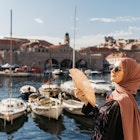
Mar 20, 2024 • 11 min read

Mar 15, 2024 • 10 min read
Change location
- UK / International
- Call toll-free until 8pm EDT
- 617-223-4521 617-223-4747 or
- REQUEST A QUOTE
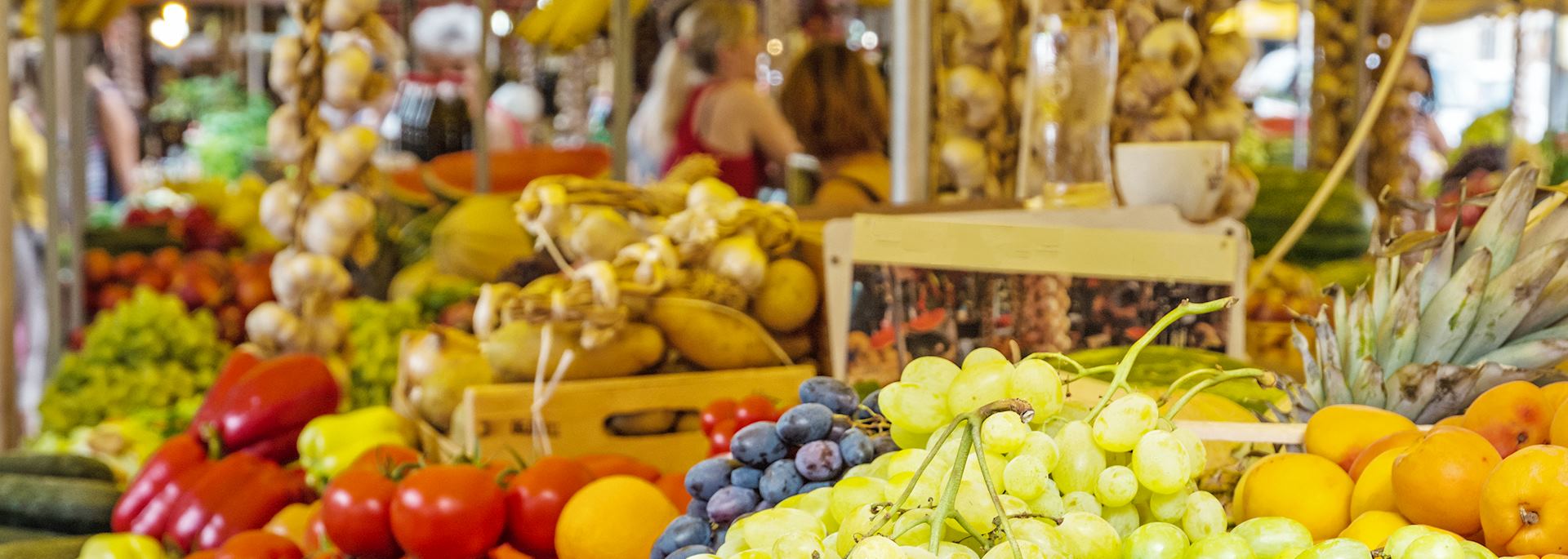
When is the best time to visit Croatia?
- Month-by-month
The best time to visit Croatia is during the summer months, from June to September, when sunlight is plentiful and temperatures are warm, between 66°F and 86°F. These conditions are ideal for boating and swimming in the blue waters around the islands.
The cooler conditions of April, May and October lend themselves to a wide range of other outdoor activities, from hiking to kayaking.
In November to March, Croatia’s winter, you can focus on Zagreb or Split when they’re at their quietest and most relaxed.
- Make an inquiry
- Request a brochure
Month-by-month guide for traveling in Croatia
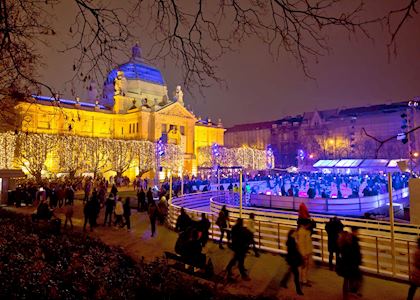
Visiting Croatia in November - April
As winter begins in Croatia, many island hotels close for the season to make their refurbishments. But, although the beaches and boat trips are off-limits, you’ll still find plenty of cultural experiences, and those hotels that stay open offer exceptional value. The winter months also present a great opportunity to enjoy the country almost exclusively with the locals.
Events & Festivals
- Carnival (January 17): Costumes ranging from medieval garb to futuristic visions are on display at this international festival celebrated in various Croatian cities, most notably Dubrovnik and Rijeka. Parades take place next to street parties, food stalls and sporting competitions.
- Feast of Saint Blaise (February 2): Dubrovnik pays tribute to its patron saint with a day of music, parades and festivities.
- Easter (March/April) is celebrated throughout the country with parades and traditional costumes, as well as decorated pisanica eggs.

Visiting Croatia in May - June
As spring begins, so does the visitor season, with temperatures rising throughout the country. With little rain and long daylight hours, this is an excellent time to visit Croatia to take advantage of fewer crowds and ideal hiking conditions.
- Saint Domnius Day on May 7 sees Split celebrate its patron saint with a daytime procession through the streets and promenade, followed by traditional klapa music, a rowing contest and a street fair throughout the afternoon and evening.
- Statehood Day on June 25 marks the date Croatia claimed independence from Yugoslavia with celebrations across the country, ranging from cultural events to lively street parties and live music.
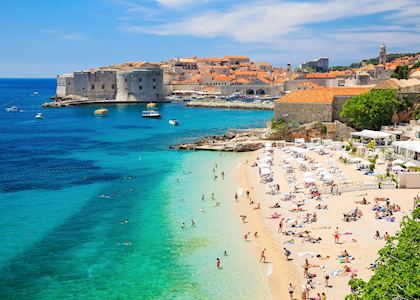
Visiting Croatia in July - August
The summer is peak season in Croatia, as visitors and locals alike enjoy the dry, hot weather. Outdoor venues host music, food and cultural events on a weekly basis, offering an entertaining and lively experience. This time of year also brings larger crowds, longer lines and increased prices at most hotels.
- Zagreb’s International Folklore Festival in July celebrates traditional Croatian culture and customs through music, dance and theater, drawing visitors from across the world.
- The Alka in the town of Sinj is held on the first Sunday of August — a uniquely Croatian festival celebrating a military victory over Ottoman forces in 1715 in which horsemen in full costume compete to lance a small metal ring for the accolade of top knight.
- Night of the Full Moon in Zadar (July/August): The waterfront promenade in Zadar is illuminated with torches and candles in this festival of regional culture and food.
- The International Puppet Theatre Festival takes place in Zagreb at the end of August or beginning of September, when professional puppeteers converge to show off their mastery in the artform.
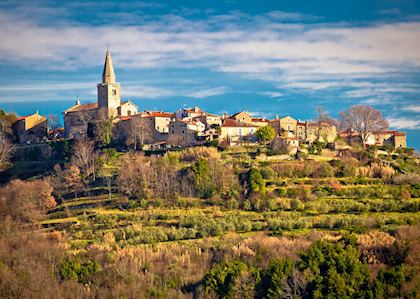
Visiting Croatia in September - October
The temperatures begin to recede during September and October, when the summer break has also come to an end. These months offer you great value with reduced crowds, enjoyable weather and plenty of cultural events taking place throughout the country. Most hotels and boat operators on the islands remain open until the end of October, and locals and visitors enjoy the quieter beach atmosphere.
- Nights of Diocletian (September) in Split is a weekend of Roman re-enactments where toga-clad performers pay their respects to the city’s ancient history in addition to parades, street food and live music.
- Truffle Days (September/October): Each autumn, the small Istrian town of Livade celebrates the local delicacy, the truffle, over 10 weekends with cooking contests, demonstrations and tastings.
Croatia Climate Guide
Why travel with audley.
- 100% tailor-made tours
- Fully protected travel
- Established for over 25 years
- 98% of our clients would recommend us

Travel advice
Practical tips for traveling to Croatia, from social protocols to guidance on money matters, with a link to the latest US State Department travel advice.

Request our brochure
Covering all seven continents, The World Your Way shows you how you can see the world with us. It features trip ideas from our specialists alongside hand-picked stays and experiences, and introduces our approach to creating meaningful travel experiences.
Trip ideas and travel guides for exploring Croatia

Family tour of Croatia
10 days from $7,875pp
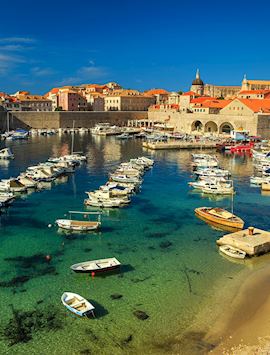
Croatia's Dalmatian Coast highlights
10 days from $8,895pp
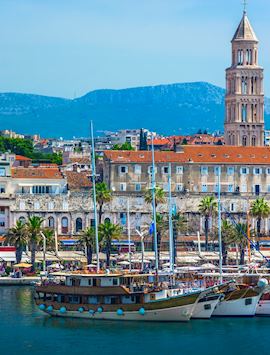
Crossing the Balkans: Slovenia, Croatia, Bosnia & Montenegro
11 days from $11,950pp

A highlights guide to Croatia
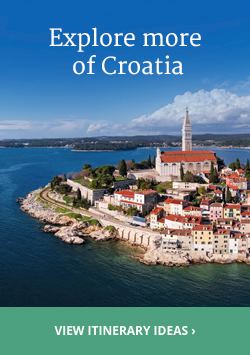
Best Time to Visit Croatia: For Good Weather and More!
Adventurous Kate contains affiliate links. If you make a purchase through these links, I will earn a commission at no extra cost to you. Thanks!
When’s the best time to visit Croatia? You deserve a fantastic trip to Croatia — and that includes timing your trip perfectly! Croatia is one of the most beautiful bucket list destinations in all of Europe.
Croatia is one of my all-time favorite countries, and I’ve spent months traveling the country extensively. Not every time of year in Croatia is the same, and you’ll have a lot more fun in September than January.
Most people travel to Croatia in the summer months — and for good reason. Croatia has arguably the most beautiful coastline on the planet, with roads curving around mountains, tiny white stone villages topped with orange roofs, and hidden pebble beaches leading to bright teal water. Summer in Croatia is like turning the volume up to 11.
But summer isn’t the only option in Croatia. For certain kinds of travelers, the shoulder season might be even better for you than summer.
You can have fun in Croatia year-round! Even in January! But a lot of what makes Croatia wonderful — swimming in the Adriatic, hiking through national parks, dancing at music festivals — is very seasonally dependent.
Read on for the best time of year to visit Croatia!
Table of Contents
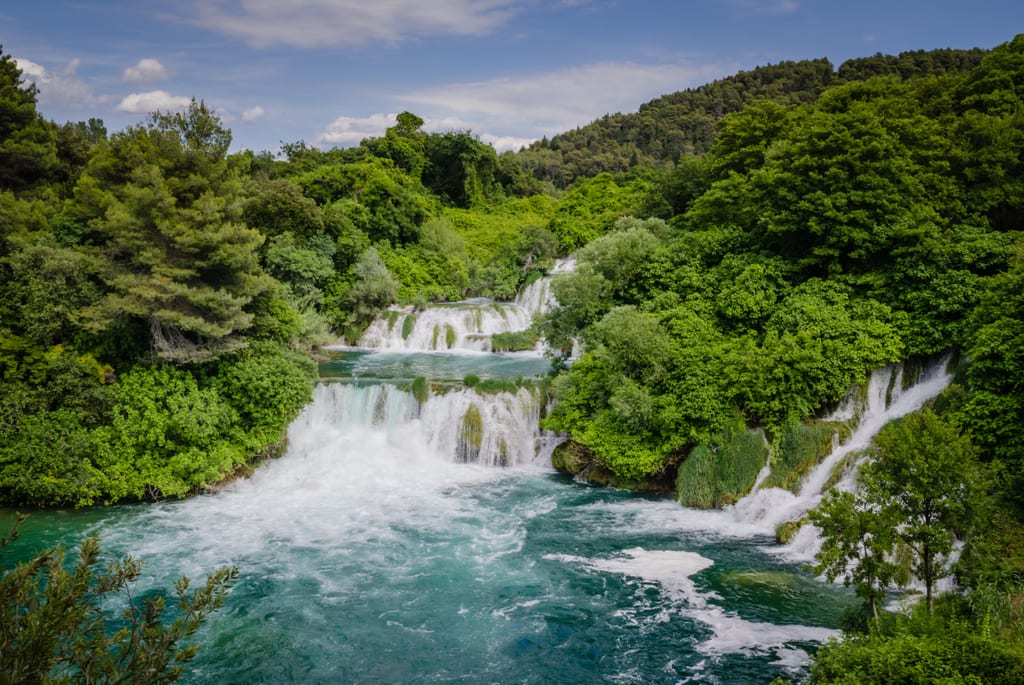
Best Time to Visit Croatia
Most travelers come to Croatia during the summer months to enjoy the beaches and islands. And while peak summer can be a bit too busy, you can enjoy yourself in the shoulder season as well.
Most people visit Croatia during the summer months , from June through September, so they can enjoy the beaches, islands, and warm days with very little rain.
In my opinion, September is the best month to visit Croatia , ideally late September. You get summer weather, fewer crowds, and the water is much warmer than in June.
You can visit Croatia year-round with kids . The summer months are your best options for a beach holiday, but spring and fall are excellent times for exploring Croatia’s culture.
Dubrovnik is best in June and September , when the weather is warm and summer-like but there are far fewer large cruise ships and tourists.
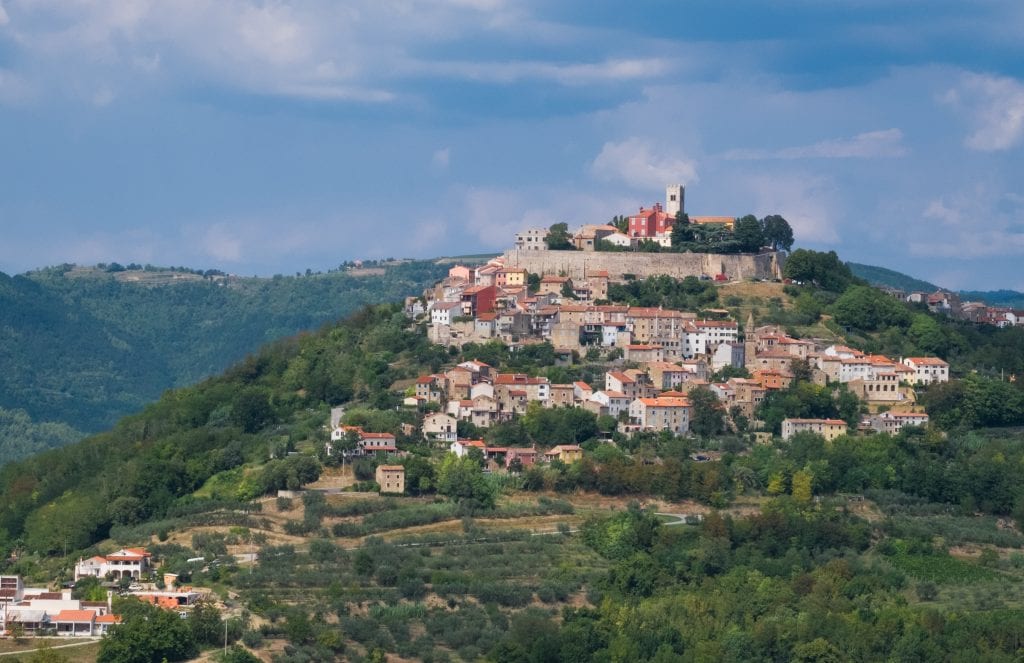

Croatia Weather
Croatia has an Adriatic climate, generally speaking, which is not surprisingly quite like a Mediterranean climate. Even so, the country doesn’t have one universal climate. There is a lot of variation within the country when it comes to weather.
Most Croatia travelers come to visit the Dalmatian coast in southern Croatia — including places like Dubrovnik, Hvar , and Split. This is the warmest and sunniest part of Croatia with a long summer season that runs from late May to early October.
Istria, the Italian-flavored peninsula in Croatia’s northwest, isn’t quite as sunny or as warm as Dalmatia, but you still have hot summers with slightly cooler springs and falls and a shorter summer season overall.
Zagreb is further inland and it can get both quite hot and quite cold here — and it snows most winters. Shoulder season is when Zagreb is at its best.
Slavonia, the off-the-beaten-path region in the far northeast, has more extreme temperatures than the rest of the country. Expect stiflingly hot summers and bitterly cold winters.
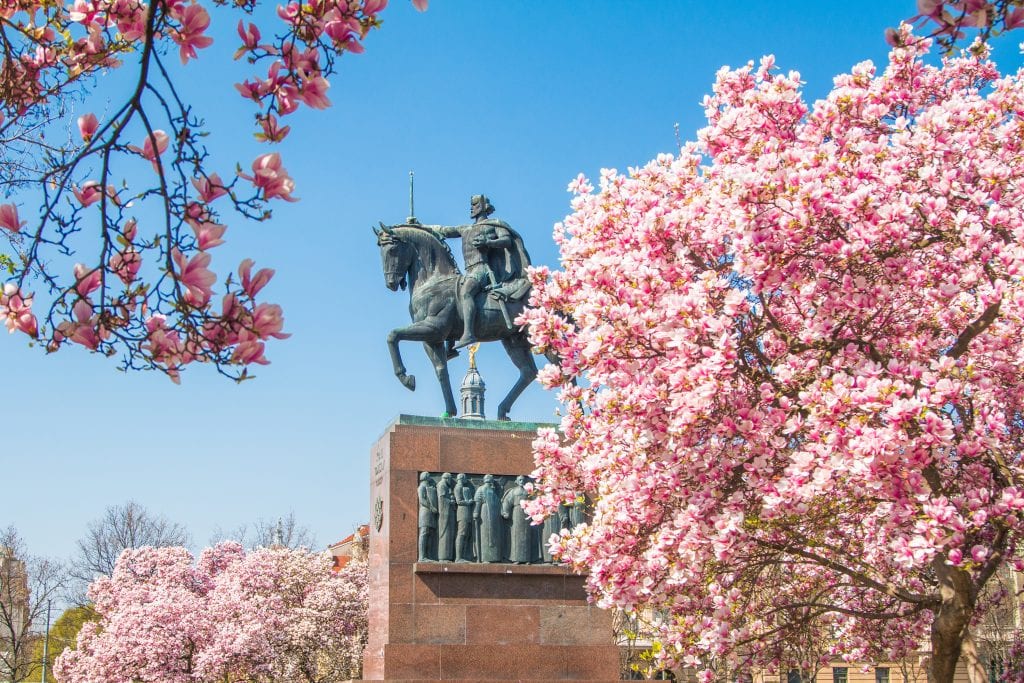
Spring in Croatia
Spring is when Croatia bursts into bloom. The weather starts to warm in early March in Dalmatia and later March in regions further north like Istria and Zagreb. Flowers dot the landscape in April and continue into May, making it a beautiful time to visit Croatia.
Croatia is a deeply religious country and Easter is the major holiday of the spring. Many Croatians take Easter week as a mini-holiday to enjoy the coast before the tourists arrive. Spring is also a popular time for cultural festivals.
Spring can be a particularly nice to visit the Plitvice Lakes and Krka National Park, as the waterfalls are extra flush with snowmelt.
Spring in Croatia lasts until late May. By that point, Jadrolinija (Croatia’s ferry line) starts up its summer schedule and people will be sunning on the beach in Dalmatia. The heat slowly creeps northward.
Overall, spring can be a lovely time to experience a beautiful and warm Croatia without the tourist crowds — but I would recommend visiting in April or May rather than March.
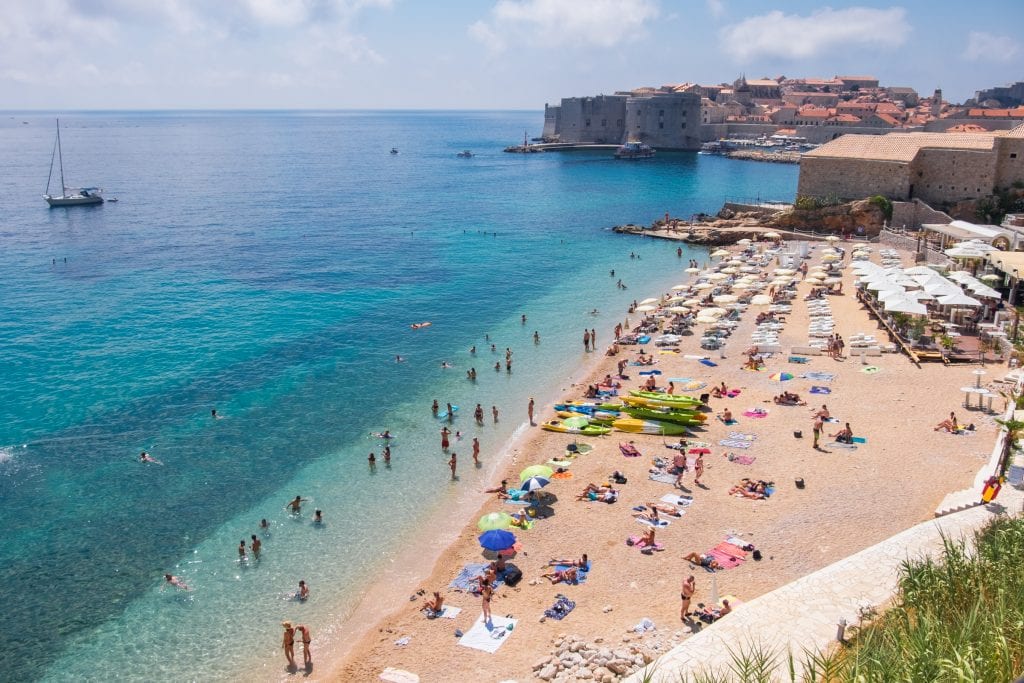
Summer in Croatia
Summer in Croatia is a sizzling time of year. This is when the Adriatic Coast comes to life! Summer is what most travelers have in mind when they visit Croatia, and summer is when Croatia receives most of its tourists from abroad.
Summer is a wonderful time to visit the Dalmatian Coast because it’s sunny and hot with very little precipitation. However, there tends to be one mega-thunderstorm once every summer, so know that it could happen during your visit! (I was in Pelješac for the 2020 storm. It rained so hard it felt like the world was ending. But a few hours later it was over!)
Summer is also when cruise ships are at their peak — particularly in late June, July, and August. Dubrovnik’s old city in particular is crammed with cruise ship tourists during the day, and for this reason I recommend avoiding the old city during the heat of summer days and sticking to visiting at dusk and at night.
Summer can also be quite hot in inland parts of Croatia, like Zagreb and the Slavonia region. Summer also brings tourists to the coastal areas of Istria, which don’t have quite as long a season as those in Dalmatia, so tourism is a bit more condensed here.
Summer brings you the Croatia of your dreams — but because it’s so busy, it’s a good idea to plan your trip ahead of time, especially accommodation, which can book out quickly. I find that early June and late September are better times to enjoy the best of Croatia’s summer while avoiding the worst of the crowds.
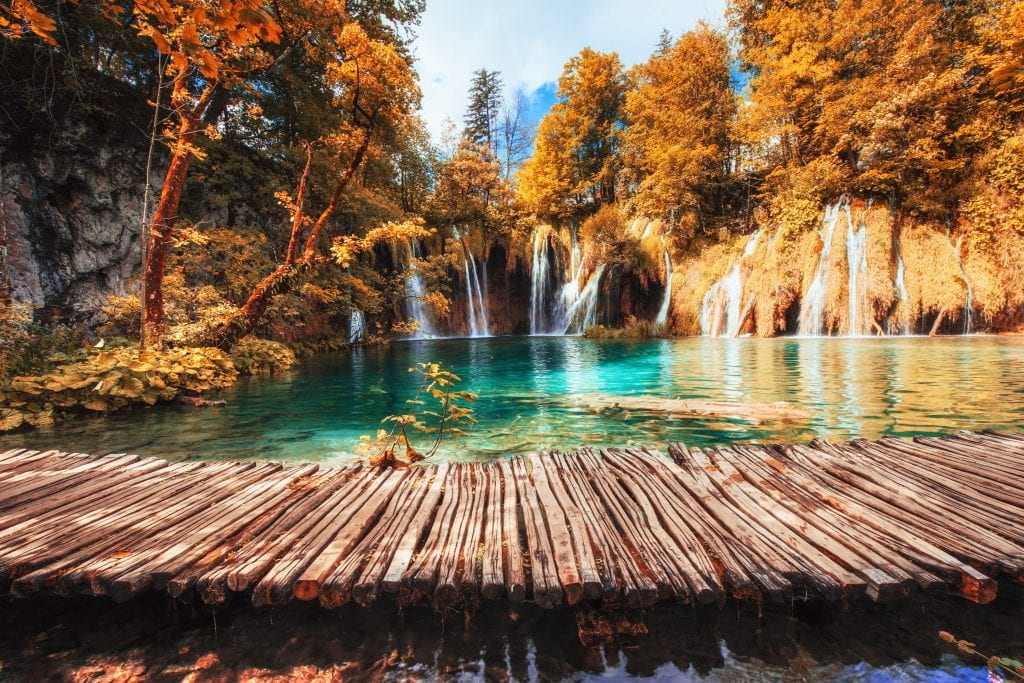
Fall in Croatia
Fall in Croatia — or autumn in Croatia — varies quite a bit based on where you are. In Dubrovnik, you’re enjoying summer weather into October; in Zagreb, Motovun, and Slavonia, October is when things start to get chilly. Either way, it can be a welcome relief from the summer heat and tourist crowds.
When does fall begin in Croatia? Usually in October, as September is still very much the summer months. The further north you go, the earlier the fall begins.
Croatia does get some fall foliage, and this can be a beautiful time to photograph the Plitvice Lakes and other national parks.
Fall is especially a wonderful time to visit Istria, where you can enjoy the bounty of the harvest, truffle hunting, and newly released wines.
Fall can also be a rainy time in Croatia and the rainiest months of the year are November and December. Make sure you bring your umbrella and have a plan for when the sun isn’t shining!
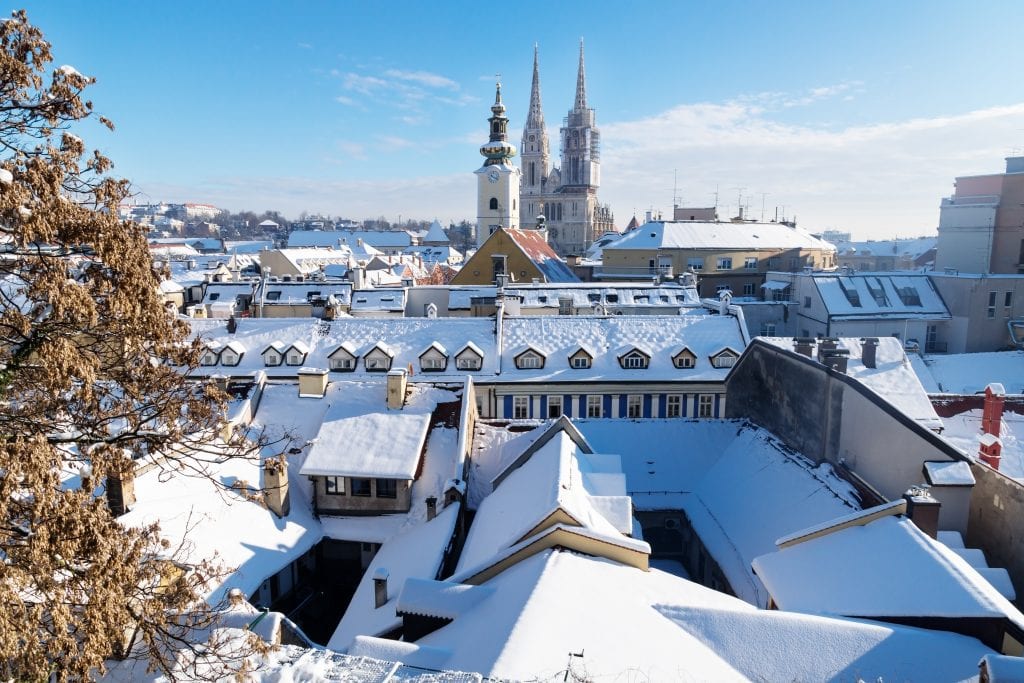
Winter in Croatia
From December through February, Croatia is engulfed in the winter months. In Zagreb, Slavonia, and mountainous parts of Croatia, you can see snow. In warmer parts of the country, like Dalmatia, you’ll have chilly temperatures and rain. It snows in Dubrovnik once in a blue moon.
Is winter a good time to visit Croatia? Generally, I don’t recommend it.
The exception would be if you’re spending time exploring Zagreb, which of course is a year-round city; visiting the Plitvice Lakes to photograph them in the snow; or perhaps spending time in a city like Zadar, which is very quiet but not shut down.
That said, there are a few big winter events in Croatia that deserves mention: Carnival, or Maškare , which takes place mostly in February, and Advent in Zagreb , Zagreb’s Christmas market celebration that lasts the full month of December. Both of these events are well worth your time.
Just understand that visiting Croatia in the winter is a very different experience.
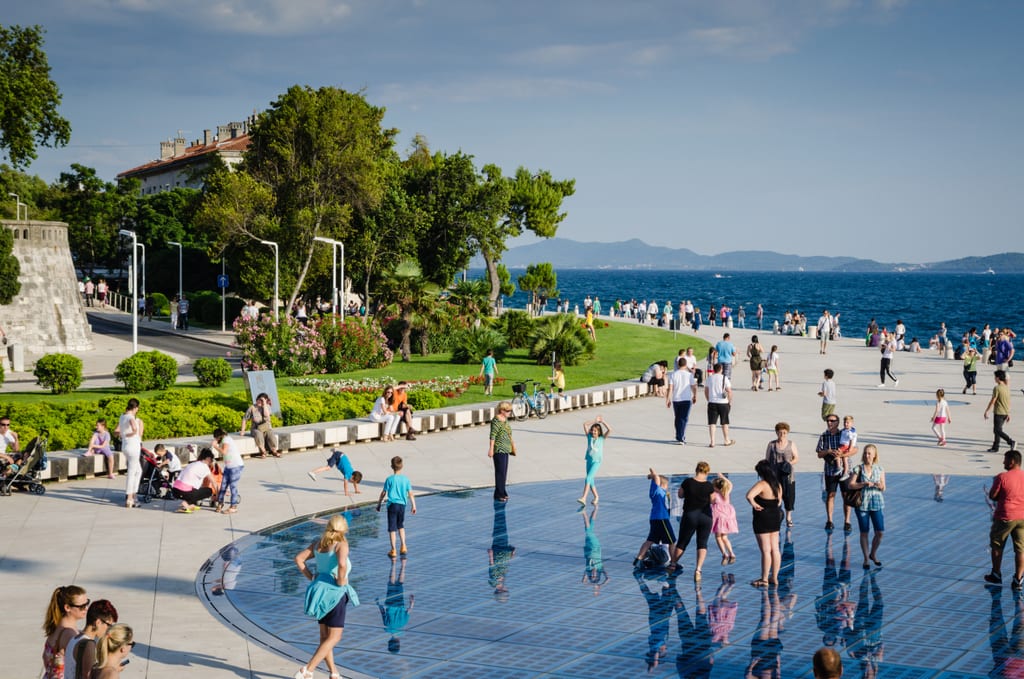
High Season and Low Season in Croatia
High season in Croatia is during the summer months, particularly in Dubrovnik and along the Dalmatian coast, from June through September. This is when prices and temperatures are at their highest and crowds are at their worst.
The absolute peak of high season in Croatia is during the months of July and August, and these months are when most of the cruise ships are docked in ports. While June and September are still technically considered high season, there is a world of difference in crowd levels in places like Split and Dubrovnik.
Shoulder season in Croatia is April to May and late September to October. During this time you have decent prices, few crowds, and zero cruise ships. Most resorts along the Dalmatian coast operate from May through October.
If you’re looking for more of a cultural trip and less of a lie-on-the-beach trip, this can be an excellent time to travel in Croatia. Shoulder season is also my favorite time to travel in Zagreb, Istria, and Slavonia.
Low season in Croatia is during the cold months of the year, from November through March. There are deals to be had during these months, particularly in the larger cities, but much of the Dalmatian coast and more resort-y towns and islands mostly shut down.
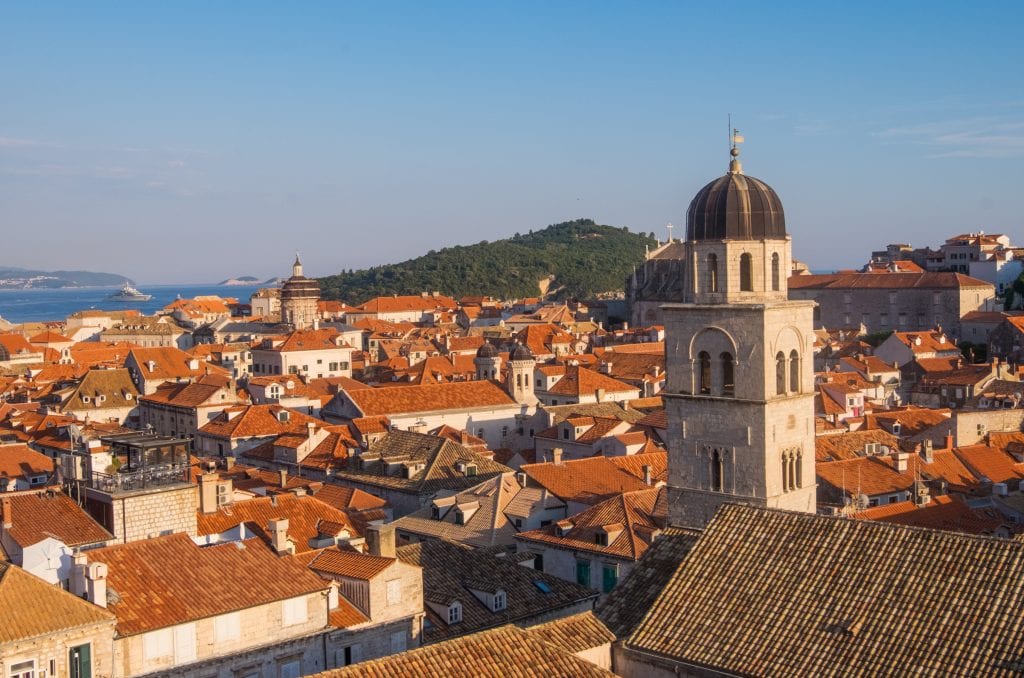
Best Time to Visit Dubrovnik, Zagreb, Rovinj, and More
Croatia may be a small country, but the weather can vary quite a bit. One of my favorite experiences in Croatia is driving from the Zagreb area to Split and the Dalmatian coast, because you drive through mountains under a cloudy sky, go through an enormous tunnel, and when you come out, it’s bright and sunny, like you’ve entered a new country!
That’s how different Dalmatia is — and that’s how different Croatia’s climates can be.
Best Time to Visit Dubrovnik
Dubrovnik is one destination in Croatia where I recommend timing your trip with precision, and the best time to visit Dubrovnik is during September or October. During these months you’ll enjoy warm weather and beach time, and the water will be warm enough for swimming, but you’ll avoid the worst of the cruise ship crowds that arrive in July and August.
Late May and June is another nice time to visit Dubrovnik, but the water won’t be as warm for swimming. If you’re not a swimmer, or you don’t mind cold water, go ahead! You might actually enjoy that more than September.
Dubrovnik Summer Festival takes place during July and August and features concerts, performances, and events in and around the city.
Good Food Festival , either in late September or early October, is a fabulous food celebration in Dubrovnik.
Winter in Dubrovnik is extremely local and very quiet. Locals celebrate the Feast of St. Blaise, Dubrovnik’s patron saint, on February 3 with performances, costumes, and dancing.
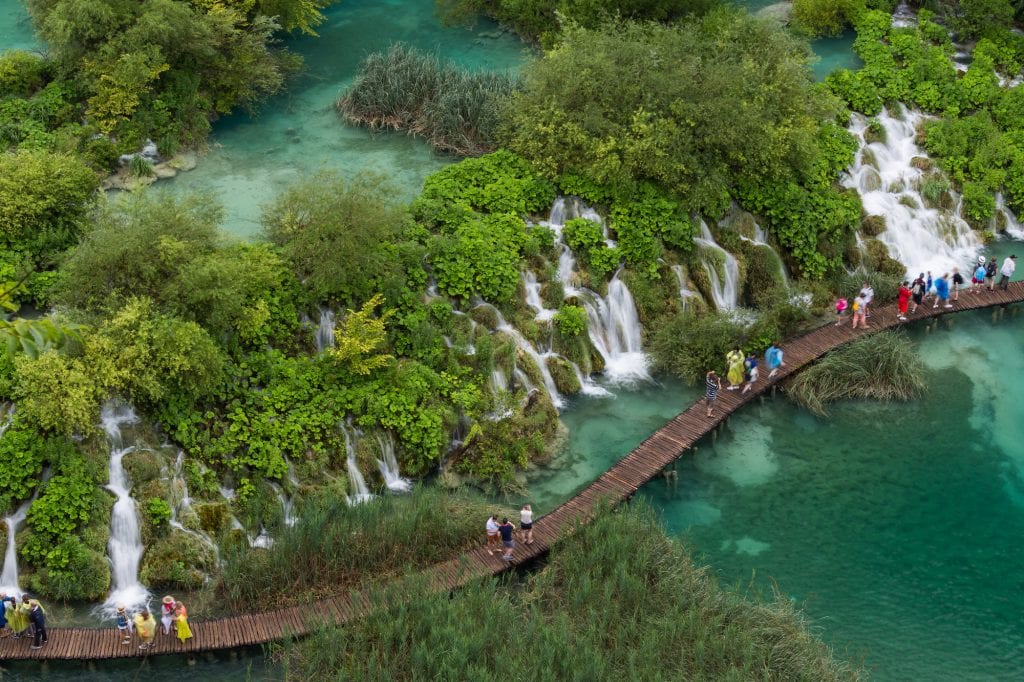
Best Time to Visit Plitvice Lakes
The Plitvice Lakes with their iconic waterfalls are one of the most stunning natural sights in all of Croatia. And because of that, they are a joy to photograph year-round!
In the spring you get extra-flush waterfalls due to snowmelt, plus flowers and budding trees. In the summer you get full, lush greenery. In the fall you get changing colors. And if you time your visit right in the winter, you can experience snow and frozen waterfalls — images that are coveted among many nature photographers.
No matter what time of year you visit, be sure to dress for the weather. The Plitvice Lakes aren’t outfitted with many indoor stations to take a break from the outdoors.
Like the rest of Croatia, July and August are the busiest months at the Plitvice Lakes and host lots of cruise ship shore excursions. It can get very crowded during this time, particularly at the Lower Lakes, so if you’re looking to avoid the worst of the crowds, I would recommend avoiding these two months.
And if you enjoy the Plitvice Lakes, don’t miss Krka National Park !
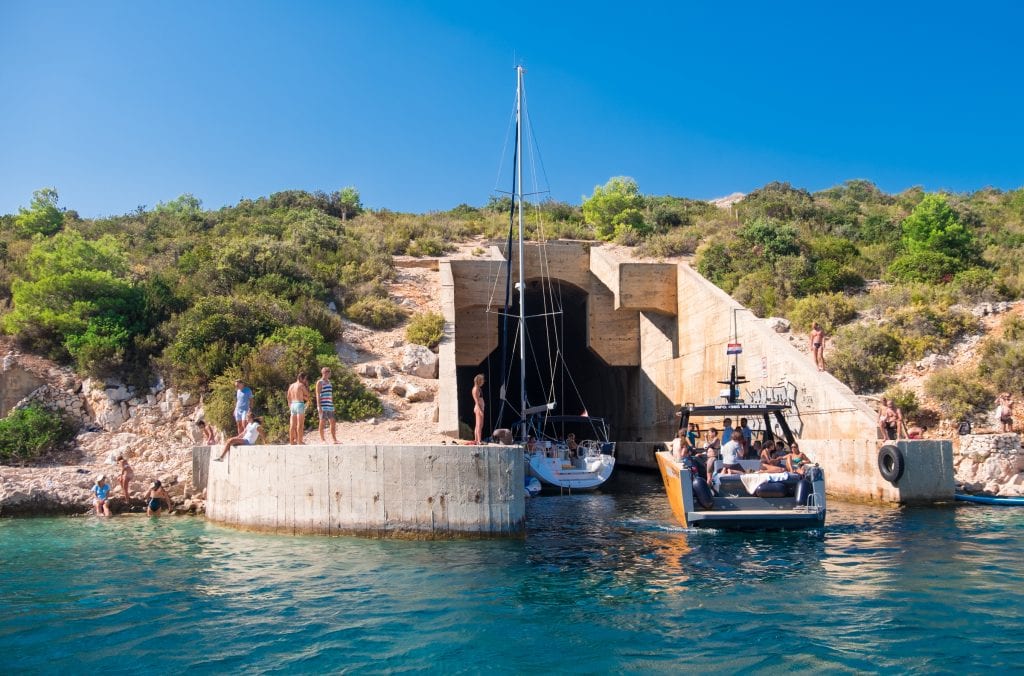
Best Time to Visit the Dalmatian Coast
The Dalmatian coast is blessed with a long and languorous high season. Summer is when this part of Croatia is at its best. You can enjoy summer-like temperatures from late May through early October (though the water is much warmer in September than June).
Whether you’re visiting the relaxing city of Zadar or the endlessly interesting island of Korčula , enjoying the forests and saltwater lakes of Mljet or hiding away in remote Vis, there is plenty to enjoy along the Dalmatian Coast in the summer.
However, I recommend avoiding July and August if possible. This is when tourism is at its peak along the Dalmatian Coast, and some destinations like Dubrovnik are overrun with cruise ship tourists.
My personal favorite month to visit the Dalmatian coast is September.
Shoulder season can be a nice time to visit the Dalmatian coast, but know that some places are going to be closed. I recommend sticking to April, May, and October — months when places are a bit more likely to be open.
In the winter, much of the Dalmatian coast shuts down. Accommodation closes, restaurants close, and ferries run less often. Honestly, I don’t see much of a reason to visit the Dalmatian coast during this time of year.
Split has a lot of festivals. April brings Gast Fair , Croatia’s largest culinary festival. May brings the Feast of St. Dominius, Split’s patron saint, and lots of celebrations leading up to it. Mediterranean Film Festival Split takes place each July. Split Summer Festival is similar to Dubrovnik Summer Festival and brings all kinds of concerts and performances in July and August.
In Ston on the Pelješac peninsula, the Festival of Oysters takes place on March 18, St. Joseph’s Day, and features lots of delicious oysters and wine. The mainland town of Šibenik celebrates Supertoon in July, a festival of animation. See below for more on music festivals.
The island of Korčula celebrates the Sword Dance Festival in June.
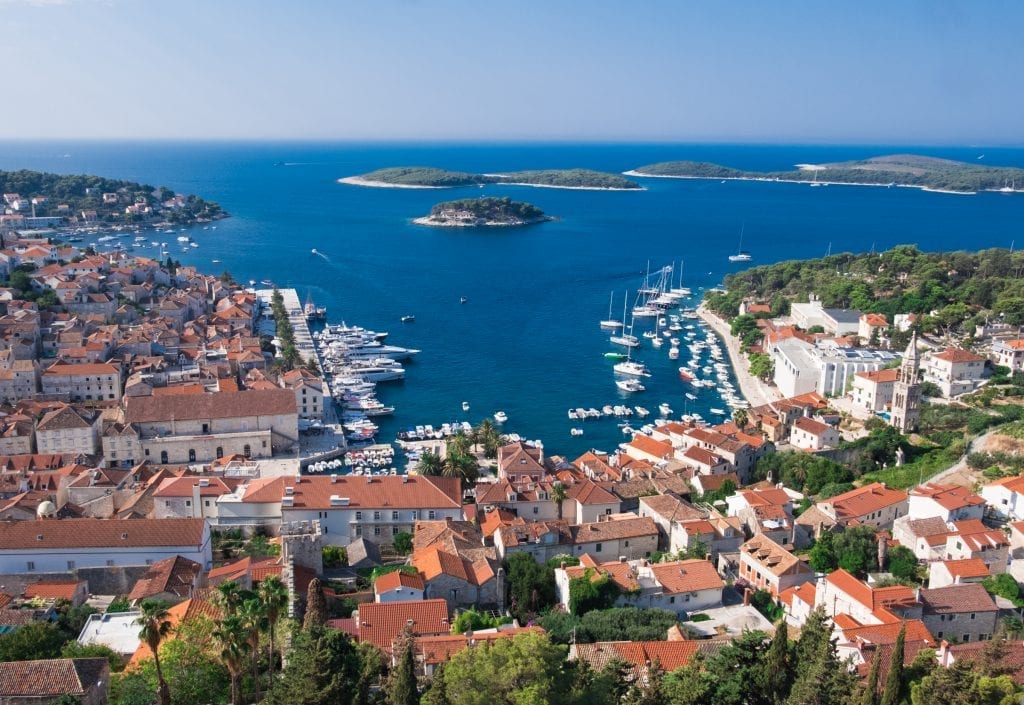
Best Time to Visit Hvar
Being on the Dalmatian Coast, Hvar is blessed with blissful summers — and locals like to say it’s the sunniest island in Europe. Hvar is very much a summer destination, but here summer can extend from late May into early October.
If all you’re looking for is sunshine and warmth, anytime between late May and early October is lovely.
If you’re looking to see Hvar’s famous lavender fields, aim for late June or early July. Lavender has a short season in Hvar.
But if you’re looking to visit Hvar specifically for the party scene, as many travelers do, the season is at its peak in July and August. You’ll pay in terms of crowds and prices, but that’s why you’re here, isn’t it? Being a party person in Hvar comes with a price tag.
In terms of festivals, Hvar celebrates the Feast of St. Prosper, its patron saint, on May 10 with traditional celebrations and a feast. Hvar Summer Festival puts on concerts, events, and performances throughout July and August.
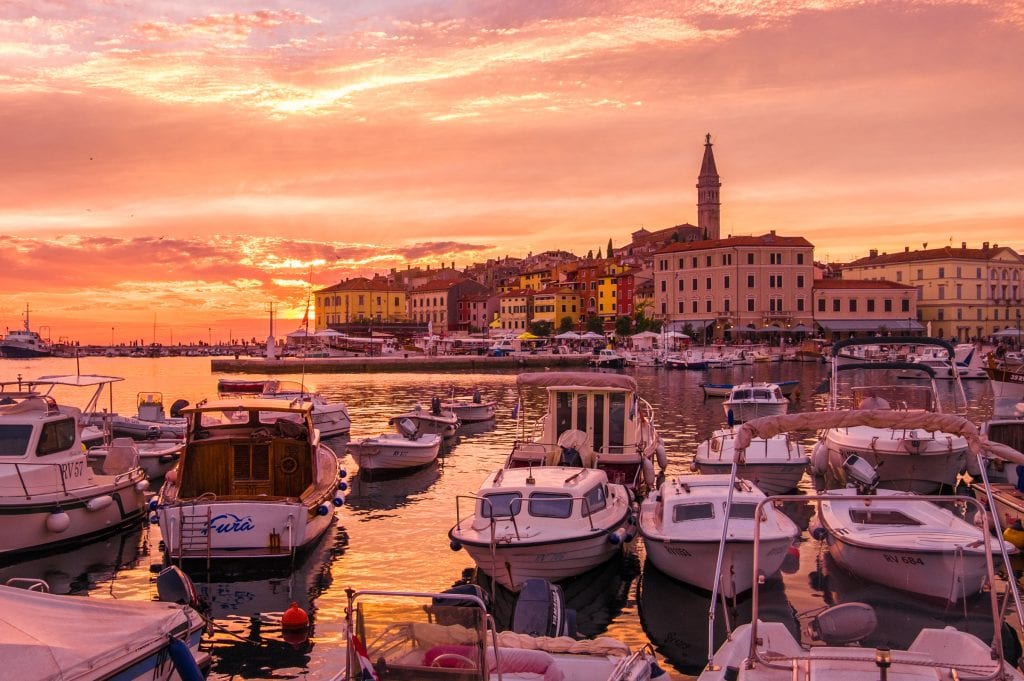
Best Time to Visit Rovinj and Istria
Most people visit Istria in the summer months, and like the Dalmatian coast, summer can be a wonderful time to visit Istria and cities like Rovinj and Motovun. But Istria is not as warm as Dalmatia, nor as sunny as Dalmatia, and the season doesn’t last as long.
If you’re looking to experience summer in Istria, I recommend aiming between mid-June and late September. Know that tourism will be at its peak in July and August.
But shoulder season is another wonderful time to visit Istria — you can visit quiet beach villages and interesting hill towns, all without the high temperatures or peak crowds.
Istria was once part of Italy, feels a lot like Italy, and has many of the same qualities that make Italy great — including a wonderful harvest season. For that reason, visiting Istria during the fall months can be a lot of fun.
Winter in Istria is quiet, particularly in resort towns.
Some festivals to keep in mind for Istria: Rovinj celebrates a three-day Easter Food Festival just before the holiday; the renowned Motovun Film Festival takes places in late July or early August; the Pula Film Festival takes place in July.
The Visualia Festival in Pula takes places in September, with light installations throughout the city; and Zigante Truffle Days in Livade, near Motovun, has events from September through November. Marunada , a celebration of chestnuts, takes place in Lovran, near Opatija, in October.
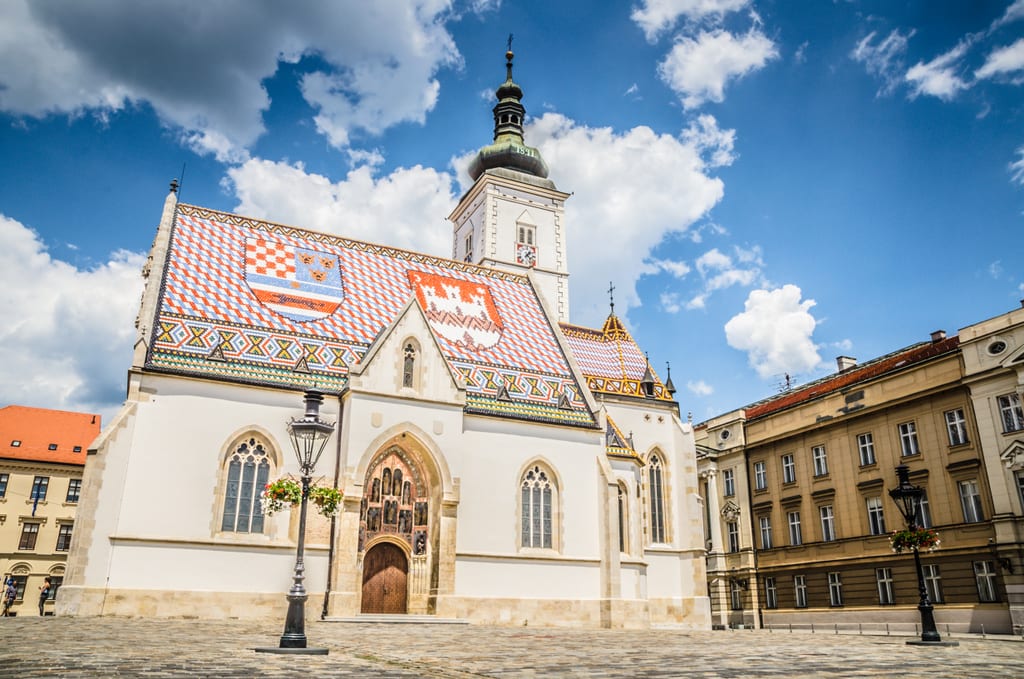
Best Time to Visit Zagreb
Zagreb is Croatia’s largest city, home to 800,000 people. As a result, this city is vibrant year-round. Zagreb has the most tourists in the summer, but it’s nowhere near the level of tourism in Rovinj, Split, or Dubrovnik.
Personally, I think the best time to visit Zagreb is during the shoulder season — April, May, October — to enjoy nice temperatures and city life.
Keep in mind that Zagreb gets much colder than the Dalmatian coast and gets snow in the winter!
March brings the Zagreb Festival of Lights , with light installations over the city. July brings the International Folklore Festival , one of the biggest celebrations of the year.
September brings the International Puppet Festival , with both Croatian and international artists showcasing their craft. Zagreb Film Festival usually takes place in early November.
Perhaps most impressive, though, is Advent in Zagreb — Christmas market season. Zagreb goes all out with decorations, art installations, an ice rink, and food stands featuring traditional Croatian Christmas treats. Unlike Christmas markets in other parts of Europe, this market lasts until January 1 rather than December 23.
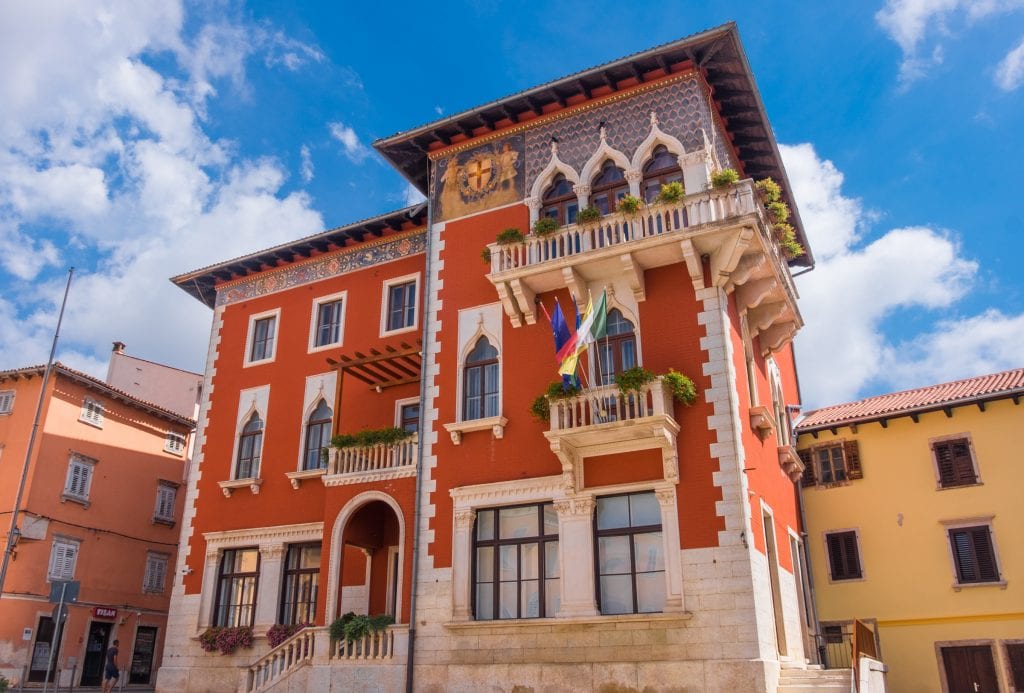
Best Time of Year to Visit Croatia
What is the best month to visit Croatia? Check out the overview here and find out which month is best for you.
January in Croatia
January is when you get the lowest temperatures of the year in Croatia. It will be cold, but there will be few other tourists around, and you’ll have many attractions to yourself — if they’re open, that is.
Some Carnival, or Maškare , celebrations begin in mid-January — particularly in the big Carnival cities like Rijeka.
Temperatures in Zagreb in January average from a low of 28 F / -2 C to a high of 37 F / 3 C.
Temperatures in Dubrovnik in January average from a low of 43 F / 6 C to a high of 54 F / 12 C.
February in Croatia
February is another similar month to January, with low temperatures and few tourists, but that’s okay — this month is when Carnival is at its peak!
Carnival, or Maškare , culminates in February with big celebrations. This is the time for costumed parades and parties. While Rijeka is the undisputed best place to celebrate Maškare, every place in Croatia puts their own spin on it in February.
Dubrovnik marks the Feast of St. Blaise, the city’s patron saint, on February 3 with local events and celebrations.
Temperatures in Zagreb in February average from a low of 32 F / 0 C to a high of 43 F / 6 C.
Temperatures in Dubrovnik in February average from a low of 43 F / 6 C to a high of 55 F / 13 C.
March in Croatia
March is when Croatia starts waking up to spring, with warming temperatures the first appearances of wildflowers. Like many countries, Croatia starts out firmly in winter and emerges into spring.
The Zagreb Festival of Lights takes place in March, with bright light installations representing the arrival of spring and a time of rebirth. In Ston on the Pelješac peninsula, the Festival of Oysters takes place on March 18, St. Joseph’s Day.
Temperatures in Zagreb in March average from a low of 37 F / 3 C to a high of 52 / 11 C.
Temperatures in Dubrovnik in March average from a low of 46 F / 8 C to a high of 57 F / 14 C.
April in Croatia
April is the first official full month of spring. Easter is a major holiday in Croatia and many Croatians take this time to travel domestically. International tourists begin trickling into Croatia in mid-to-late April.
In the days before Easter, Rovinj hosts an Easter Food Festival . Keep in mind that some years this can be in March. Enjoy traditional Istrian Easter dishes, listen to traditional brass bands, and enjoy chocolate eggs! In April, Split hosts Gast Fair , Croatia’s largest culinary festival.
Temperatures in Zagreb in April average from a low of 46 F / 8 C to a high of 61 F / 16 C.
Temperatures in Dubrovnik in April average from a low of 52 F / 11 C to a high of 63 F / 17 C.
May in Croatia
Early May and late May have very different feelings in Croatia. Early May is still firmly in spring with lots of flowers, and by late May, it feels like summer. Tourists are pouring in, hotels have raised their prices, and ferries are running on their summer schedule.
May 7 brings the Festival of St. Dominius, Split’s patron saint, and Split goes all out in celebrations.
Temperatures in Zagreb in May average from a low of 54 F / 12 C to a high of 70 F / 21 C.
Temperatures in Dubrovnik in May average from a low of 57 F / 14 C to a high of 70 F / 21 C.
June in Croatia
Hello, summertime! June is undisputedly the kick-off of summer throughout Croatia. Expect the crowds to swell and temperatures to get fiercely hot.
While you can see Moreška sword dancing throughout the summer in Korčula, June hosts the Sword Dance Festival . Dancers from all over Korčula and other islands come together to compete and perform.
Temperatures in Zagreb in June average from a low of 57 F / 14 C to a high of 75 F / 24 C.
Temperatures in Dubrovnik in June average from a low of 64 F / 18 C to a high of 77 F / 25 C.
July in Croatia
Hot, sweaty, and incredibly crowded. July in Croatia brings long days, lots of sunshine, and the most tourists of the year.
July is festival season in Croatia! Zagreb hosts the International Folklore Festival , featuring traditional music performances all over the city in traditional costume. Šibenik celebrates Supertoon , a festival celebrating animation, in July.
July is a big month for film festivals: Motovun Film Festival , Pula Film Festival , and Mediterranean Film Festival Split all take place in July.
July is also a big month for music festivals: see the music festivals section here .
On the Dalmatian Coast, Dubrovnik Summer Festival , Split Summer Festival , and Hvar Summer Festival bring concerts, events, and performances throughout the month of July.
Temperatures in Zagreb in July average from a low of 61 F / 16 C to a high of 77 F / 25 C.
Temperatures in Dubrovnik in July average from a low of 70 F / 21 C to a high of 84 F / 29 C.
August in Croatia
Yet another month of peak travel in Croatia. August is incredibly hot and one of the most crowded months of the year.
Music festivals continue into August. See the music festivals section here .
On the Dalmatian Coast, Dubrovnik Summer Festival , Split Summer Festival , and Hvar Summer Festival bring concerts, events, and performances throughout the month of August.
Temperatures in Zagreb in August average from a low of 61 F / 16 C to a high of 77 F / 25 C.
Temperatures in Dubrovnik in August average from a low of 70 F / 21 C to a high of 82 F / 28 C.
September in Croatia
Welcome to the sweet spot. September is my personal favorite month fo the year in Croatia, where you can enjoy summer temperatures, warm water, and far fewer tourists than July or August. Early September is still busy (though most families have left), but late September, particularly in Dalmatia, is warm, airy, and divine.
September brings Visualia Festival in the Istrian city of Pula, where light shows take place all over the city and the cranes at the water’s edge light up in bright colors. Zagreb hosts the International Puppet Festival . Zigante Truffle Days in Livade, near Motovun, has events beginning in September.
Temperatures in Zagreb in September average from a low of 55 F / 13 C to a high of 70 F / 21 C.
Temperatures in Dubrovnik in September average from a low of 64 F / 18 C to a high of 77 F / 25 C.
October in Croatia
October can vary quite a bit through Croatia. In Dalmatia, early October feels like an extension of summer, but as you head further north, it’s a time for pleasantly cool temperatures, a bit more rainfall, and the food harvest.
Good Food Festival takes place in Dubrovnik (though occasionally in September). Zigante Truffle Days in Livade, near Motovun, has events throughout October. Marunada , a celebration of chestnuts, takes place in Lovran, near Opatija in Istria, in October.
Temperatures in Zagreb in October average from a low of 46 F / 8 C to a high of 59 F / 15 C.
Temperatures in Dubrovnik in October average from a low of 57 F / 14 C to a high of 70 F / 21 C.
November in Croatia
November is when it cools down throughout the country — and it’s also at its rainiest time of year. You can enjoy some clear days in November, but be prepared for all kinds of weather.
Zagreb Film Festival usually takes place in November. Zigante Truffle Days in Livade, near Motovun, has events concluding in November.
Temperatures in Zagreb in November average from a low of 37 F / 3 C to a high of / 48 C.
Temperatures in Dubrovnik in November average from a low of 50 F / 10 C to a high of 63 F / 17 C.
December in Croatia
Croatia has firmly cooled down by December, and there’s still some rain carryover from November. Zagreb and Slavonia might see the first snow. Christmas celebrations begin throughout the country.
Zagreb explodes with Christmas markets through the month of December for Advent in Zagreb , one of the most underrated city-wide Christmas celebrations in Europe.
Temperatures in Zagreb in December average from a low of 30 F / -1 C to a high of 39 F / 4 C.
Temperatures in Dubrovnik in December average from a low of 46 F / 8 C to a high of 57 F / 14 C.
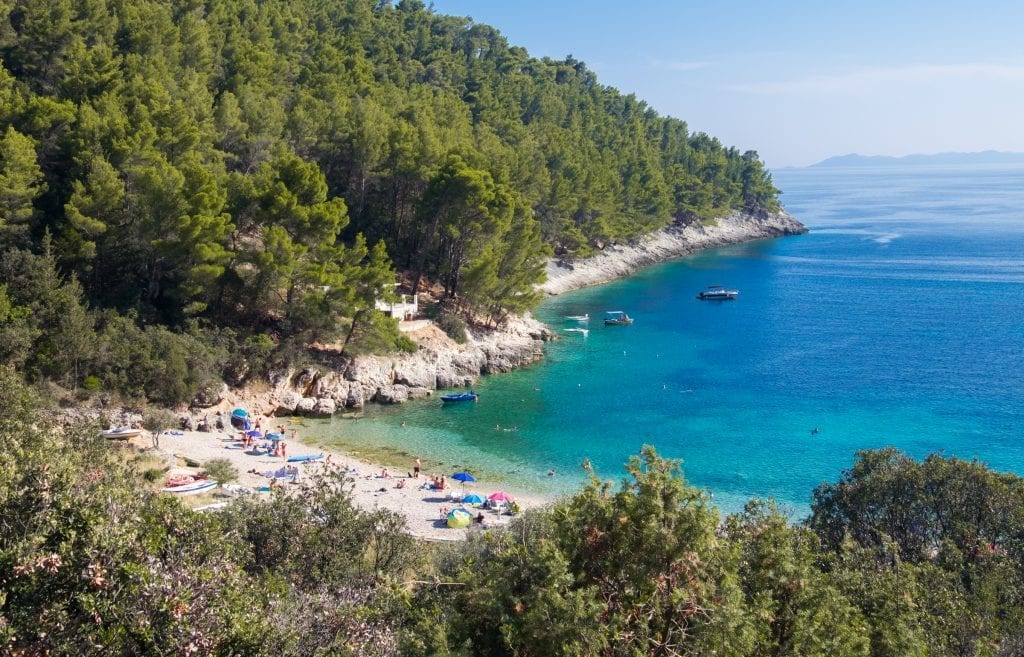
Best Time to Visit Croatia for a Beach Holiday
September would be my first choice for a beach vacation in Croatia. At this time of year you’ve got summer temperatures, yet the crowds are smaller, the cruise ships are gone, and the kids are back in school.
Croatia in September is not exactly a secret, and there will be plenty of travelers there — but it’s nowhere on the level of tourism you see in July and August. For that reason, I recommend aiming toward later in September, when things calm down even more.
Planning a beach holiday in Dalmatia? Aim for late September. Planning a beach holiday in Istria? Plan for early September, as it isn’t quite as warm there.
On the other hand, if you don’t mind water that’s a little bit on the colder side, early June can be another lovely time in Dalmatia. For Istria I’d recommend aiming for late June.
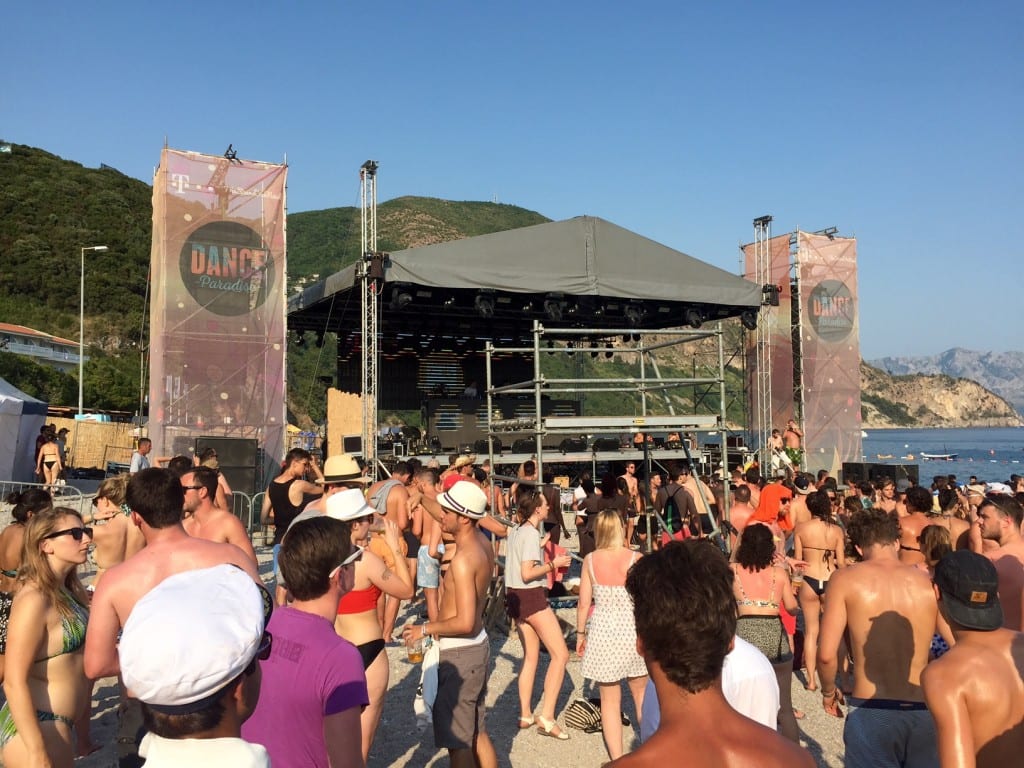
Best Time to Visit Croatia for Music Festivals
Croatia’s coastline explodes with music festivals during the summer months. If you want to hit up a festival or two, the majority of them take place in July and August.
Ultra Europe is the biggest festival with the biggest names in EDM, and it takes place in July in Split.
Umag, a seaside town in Istria, hosts Sea Star Festival in May.
Tisno, on the Dalmatian Coast near Šibenik, hosts Dimensions in July, Hospitality on the Beach in July, SuncéBeat in July, Outlook Origins in July, and Defected Croatia in August.
Zrce Beach on the island of Pag hosts Hideout Festival in June, Fresh Island Week in July and Sonus Festival in August.
INMusic is held in Zagreb in June and draws big names like The Killers.
If you’re hoping to go to music festivals in Croatia and open to a longer trip to the Balkans, consider extending your trip to EXIT in Belgrade, Serbia, and Sea Dance in Budva, Montenegro (the latter of which I quite enjoyed).
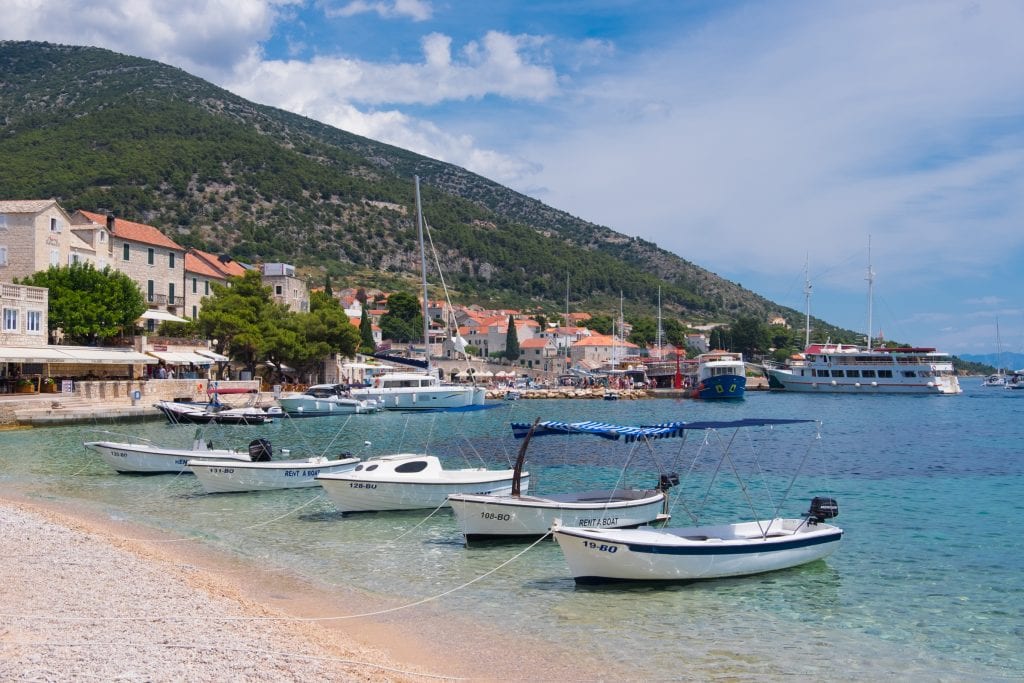
Best Time to Visit Croatia with Kids
Croatia is an extremely family-friendly destination, so don’t worry about bringing your kids to Croatia! Croatians love children and the country is set up to welcome families with kids of all ages.
Most families traveling to Croatia with kids are looking for beach time. If that’s the case for you, aim during their summer vacation. It will be crowded, but it will be easy.
You may be tempted to plan a trip in May or early June, but keep in mind that the Adriatic can be cold during these months. It spends the whole summer warming up. If your kids don’t like swimming in cold water, they probably won’t be a fan of the Adriatic in late spring.
If you’re not visiting for a beach trip, consider visiting during the spring or fall months. You’ll still have nice weather and you won’t have the complete shutdown of winter.
Finally, if you’re up for visiting in February, Carnival can be a LOT of fun for kids — especially if you hit up one of the big festivals like Rijeka.
Bonus tip: of all the places I visited in Croatia, I think the island of Brač is a great choice if you have young kids. It’s the easiest to get to (a short ferry ride from Split, the biggest air hub), and the area around Bol seems designed for families with lots of beaches, a boardwalk, and kid-friendly amenities.
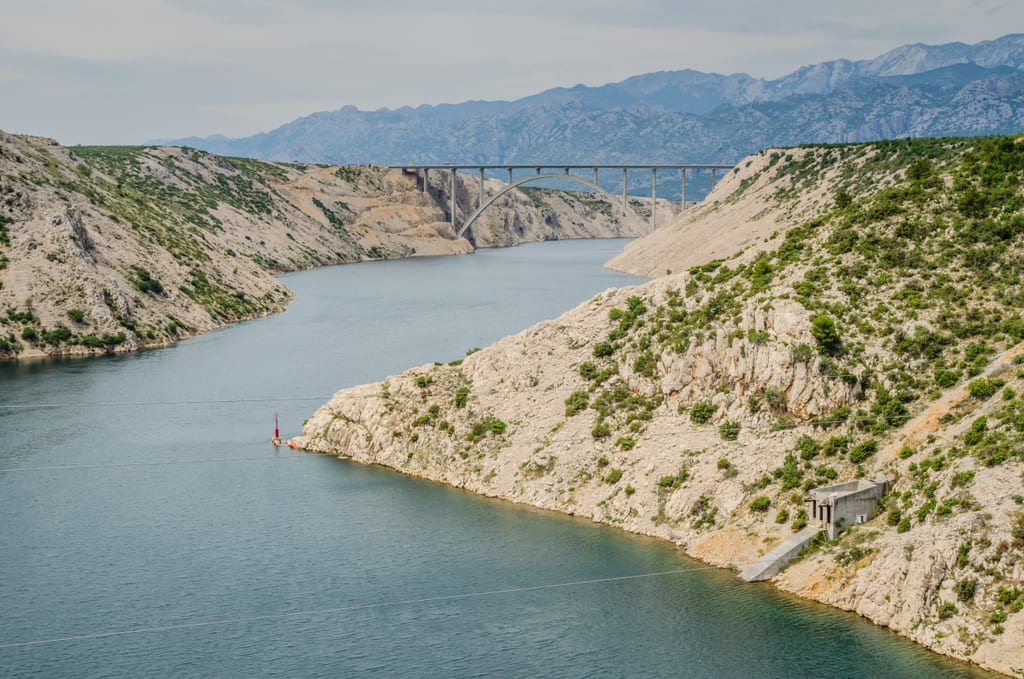
Cheapest Time to Visit Croatia
The cheapest time to visit Croatia is during the winter. This is when accommodation is at its cheapest; if you’re flying to Croatia from North America, you’ll likely find cheaper transatlantic flights.
However, keep in mind that winter in Croatia is cheap for a reason.
Much of Croatia is shut down during the winter months, from restaurants to shops to hotels. Places like the Makarska Riviera almost feel like ghost towns. Many seasonal flights in Croatia don’t run at all in winter; you may need to fly to Zagreb and drive or take public transportation from there.
It’s especially tough traveling the islands in the winter. The island population dwindles down to just the year-round locals, most of whom will wonder why you’re even there, and all the tourist-driven restaurants that the locals avoid won’t be in business.
If you’re looking to experience Croatia at a more active time of year that isn’t the heat of summer, consider April or October — not winter.
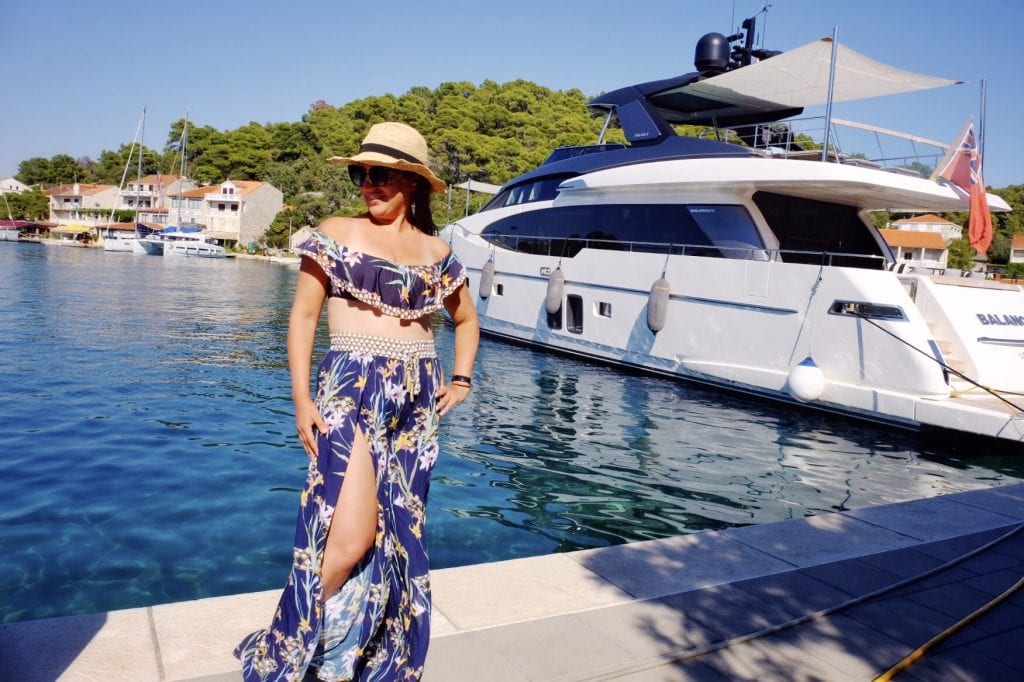
Best Time to Visit Croatia Overall
If you’ve read this far, you know what I think — the best month for visiting Croatia is September, and if you can, aim for mid-to-late September. That is the best time of year to enjoy the best of Croatia’s weather (as well as the Adriatic at its warmest temperature) while avoiding the worst crowds.
September may be golden — but there are so many wonderful times to visit Croatia. You can’t beat Zagreb in December, all decked out for Advent, or Rijeka in February, filled with costume parades, or Split in April, exploding with food festivals.
I hope you enjoy your time in Croatia, no matter what time of year you choose to visit. Then come back and tell me all about it!
Planning a Trip to Croatia:
- Two Weeks in Croatia Itinerary
- What NOT to Do in Croatia
- Solo Female Travel in Croatia: Is it Safe?
- 30 Stunning Mediterranean Islands To Visit In Your Lifetime
Croatian Islands and the Dalmatian Coast:
- How to Spend Three Days in Dubrovnik
- Why Korčula, Croatia, is the Coolest Island of All
- Vis, Croatia, is a Quietly Stunning Island
- Dubrovnik Survival Guide
- The Waterfalls of Krka National Park
- A Place Like Zadar
- 30 Fabulous Things To Do in Split, Croatia
- 29 Sunny Things To Do In Hvar, Croatia
Istria and the North:
- Guide to Rovinj, Croatia’s Prettiest City
- Places to Visit in Istria, Croatia’s Italian-Flavored Peninsula
- 21 Unforgettable Things To Do In Zagreb, Croatia
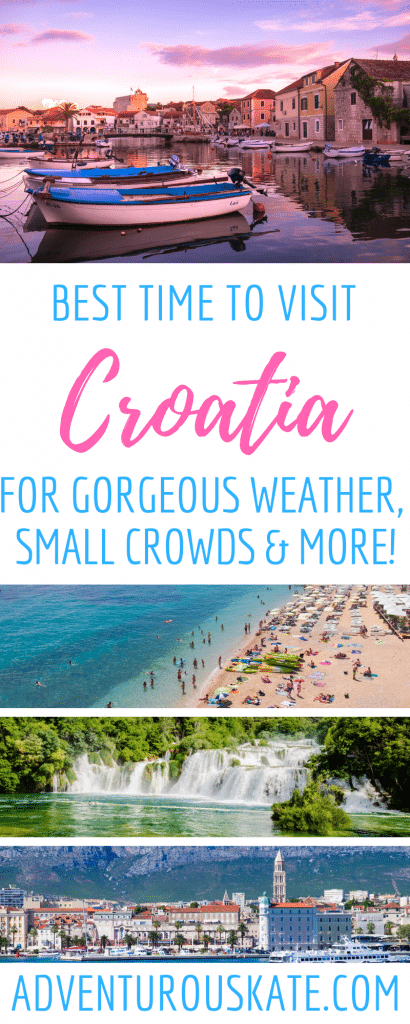
Have you been to Croatia? What time of year did you visit? Share away!
Leave a Comment Cancel Reply
Your email address will not be published. Required fields are marked *
This site uses Akismet to reduce spam. Learn how your comment data is processed .
Best time to visit Croatia

The best time to visit Croatia is in the summer (June to September) when the weather is hot and sunny, the glittering coast is at its best and the festival season is in full swing. That being said, figuring out when to visit ultimately depends on what kind of vacation you want. Croatia's climate varies from continental to Mediterranean and there’s plenty to do throughout the year. You also need to factor in if you mind peak season crowds. Let’s break it down.
Best for: skiing and snowboarding, thermal spas.
January is the coldest month with average highs of 41 to 50°F along the coast and 28 to 32°F inland. It's the best month for powder hounds looking to hit the slopes. Plus, popular ski resorts like Sljeme and Platak are usually quieter and more affordable than resorts in France and Switzerland. With little to no crowds, it's an ideal time to explore Plitvice National Park in solitude or gush over Krka's frozen waterfalls (if it’s cold enough). If you prefer R&R over adrenaline-pumping snow sports, the cold weather is the perfect excuse to relax in one of Croatia’s many thermal spas.
Best for: Mardi Gras, skiing and snowboarding.
One word: carnival. Mardi Gras is a big thing in Croatia with vibrant celebrations all over the country. The biggest and boldest festivities take place on the Sunday before Shrove Tuesday in the port city of Rijeka – think colorful float parades, dancers donning glitzy costumes and performers wearing animal head masks to ward off evil spirits. It’s a great opportunity to party with locals and eat traditional foods like krofne (Croatian doughnuts). February is the last month to hit the slopes, though the powder might not be as good as in January.
Best for: exploring with thinner crowds, the Mali Ston Oyster Festival
March kicks off the spring. The weather is unpredictable, but daylight savings means you can get out there and explore Croatia's natural beauty – just make sure you bring warm layers and a waterproof jacket. It’s not quite beach weather and many hotels, restaurants and ferry routes are still closed, but you’ll have Dubrovnik’s charming Old Town, Diocletian’s Palace and other major tourist attractions (almost) all to yourself. There’s also the annual Oyster Festival in the charming coastal village of Mali Ston – if you like seafood, this festival promises to be a treat.
Best for: getting active, the Weekend Food Festival.
The weather can still be a bit iffy in April, though it’s usually warmer and sunnier. If you don’t mind the odd shower, it’s one of the prettiest times to go hiking or cycling with colorful wildflowers dotting the landscape. There’s more of a buzz in the air as ferries, bars and restaurants start opening up, and it’s a good time to strike up a conversation with locals who travel domestically around the Easter weekend. Foodies can head to the Weekend Food Festival held in the picturesque city of Rovinj to enjoy a smorgasbord of local produce, workshops and cooking demos.
Best for: enjoying the beaches and national parks before the summer rush.
With more stable weather and warmer temperatures, beach days are back on (especially towards the end of the month). As May is considered a shoulder month, it’s a fantastic time to hit the trails and waterfalls in Krka and Plitvice, discover Dubrovnik’s ancient city walls or enjoy seafood along Split's promenade without the scorching summer sun and crowds. The cruising season starts mid-May, and while the conditions aren't as good as in June through September, it's a good time for seafarers who prefer cooler temperatures and quieter marinas.
Best for: enjoying Croatia’s beautiful beaches, cruising and sailing.
Hello, summer! With hotter temperatures, it’s prime time to enjoy the sparkling Dalmatian and Adriatic coast, dive into Plitvice’s lakes or appreciate the cool water of Krka’s cascading falls. With a lively, upbeat atmosphere in the air, it’s a great time to set sail on an island-hopping adventure or listen to live music in Dubrovnik’s, Split’s and Zagreb’s squares. Despite an influx of tourists, it’s still not as busy as July and August. Accommodation gets booked up quickly from June, so you might want to plan ahead.
Best for: watersports, enjoying the summer buzz, festivals.
July is one of the hottest and busiest months. It’s particularly hot and sticky in the cities, so sightseeing might be a no-no if you don’t cope well with the heat. Bars, restaurants and hotels along the coast are pumping, and the azure waters are at their most enticing with a wide range of watersports on offer. If you enjoy the summer buzz, it’s a great time to sip cocktails in Hvar, wander Zadar’s cobbled streets or enjoy balmy alfresco dinners – seafood plucked straight from the Adriatic, anyone? The festival calendar is also chockablock with the Dubrovnik Summer Festival, the Split Summer Festival and the Full Moon Festival in Zadar to name a few.
Best for: enjoying the coast, cruising and sailing.
August is the peak of summer. Temperatures soar and large crowds congregate at national parks and tourist attractions (our tip: wake up extra early to avoid long queues). If you want to lap up the beauty of the Croatian summer but without the crowds, get yourself on a small ship cruise or sailing boat to explore where the big ships can't go. With stunning coastal vistas and plenty of adventures waiting for you on and off the water, it’s the perfect way to balance adventure and relaxation.
Best for: enjoying the perks of summer without the crowds, Varaždin Baroque Evenings
Things settle down in September. You’ll still get to enjoy the balmy buzz of summer but with milder temperatures, more room to sprawl on the beach and shorter lines at popular sites. The sea is at its warmest which is great for watersports and it's the last month to enjoy a sailing trip . Plus, you'll benefit from thinner crowds once you drop anchor to explore islands, coastal towns and national parks. Music lovers will also love the Varaždin Baroque Evenings – a world-famous event that takes place in beautiful churches in the historic city of Varaždin.
Best for: hiking, the Zagreb Film Festival, the Good Food Festival
October weather is mild and the sea is still warm enough for swimming, but the days start drawing in earlier and there’s more rain – so you’ll need an umbrella and a hoodie for the evenings. With the changing foliage, it’s one of the best months to go hiking and swimming in Plitvice Lakes National Park. October is also a month for foodies with Dubrovnik’s much-anticipated Good Food Festival – a week-long extravaganza of workshops, cooking demos and tastings. There's also the annual Zagreb Film Festival which features a wide range of film and cultural events all over the city.
Best for: photography in Croatia’s national parks, feasting on local wine and produce
November marks the start of the low season, so bear in mind that ferry timetables may be limited and bars and restaurants along the coast may close. National parks like Krka are a photographer’s dream thanks to dramatic fall foliage, and the turning weather also lends itself to exploring Croatia’s ancient castles. St Martin's Day, known locally as Martinje, is a highlight of November. Join locals to celebrate St Martin, the patron saint of wine and winegrowers, by indulging in local wine, olives and traditional Croatian dishes.
Best for: Dubrovnik Winter Festival, Zagreb Christmas Market
Winter in Croatia can get cold, but don't let that put you off. December is a magical month with the sight of snow-topped mountains and festive cheer flooding the streets. Winter is a time to explore Croatia's cities, enjoy hot beverages in cosy bars and learn about history and culture in galleries and museums. To soak up the seasonal vibes, head to Zagreb (voted one of the best Christmas markets in Europe ) to shop, eat, drink and be merry. Or visit Dubrovnik for the lower-key Dubrovnik Winter Festival to experience more traditional festivities.
Let's create an exclusive trip for your group.
Best places to travel in June
Best places to travel in July
Best places to travel in September
How a group trip with strangers gave me the courage to pursue a new career
Greece vs Croatia: Where to travel next?
What to expect on an Intrepid Premium trip
9 ways to make meaningful cultural connections through food in 2023
9 ways to get to know a place through multi-active adventures in 2023

When to Go to Croatia
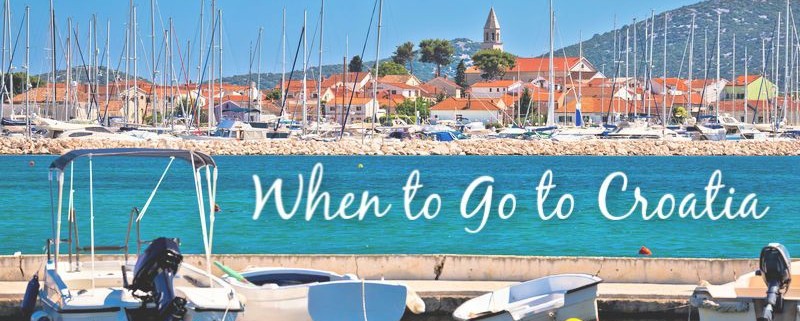
The weather will most likely be a pretty big deciding factor if you’re wondering when to go to Croatia.
As such, almost anytime between May and October is suitable for a holiday. Temperatures are already relatively pleasant in May – coastal temperatures may be in the low 20s °C/low 70s °F and there’s a good deal of sunshine. Swimming in the sea should be possible too – although it may still be a little on the chilly side, especially in the early part of the month! Understandably, the further south you go, the warmer the sea will be – so if you’re very keen for some sea swimming, consider holidaying in the south Dalmatia (e.g. Dubrovnik ) area.
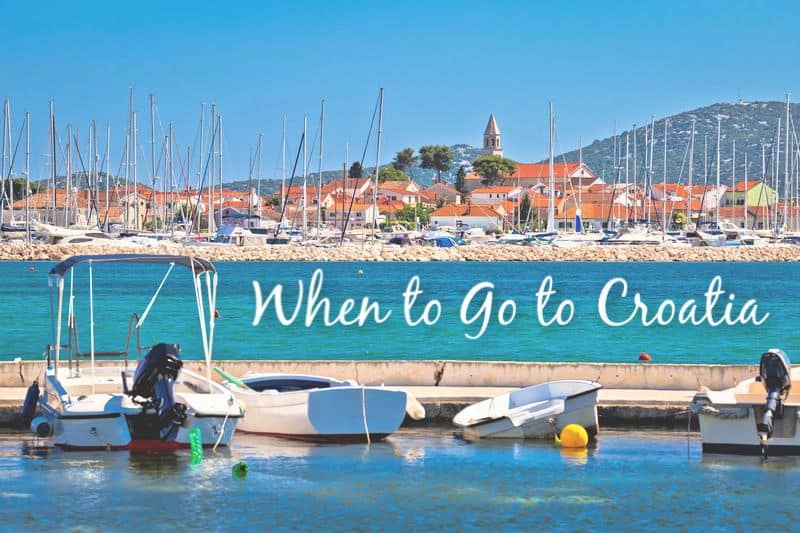
Likewise, September will still see very good weather and the sea (having heated up all summer) will definitely still be warm enough for swimming. This pleasant weather often stretches out into October.
The other summer months – June, July and August – are of course the height of summer with near-perfect weather. In some cases, temperatures may even be a little too hot, but as long as you’re prepared for plenty of dips in the sea you’ll be fine.
The main issue with these months, however, is that they tend to be very crowded. Not only will you find large numbers of holidaymakers flying in from all sorts of far-flung places, you’ll also encounter many Europeans who have literally packed up their cars with all their holiday essentials for a few weeks on the Adriatic. July and August tend to the be vacation months for most continental Europeans (which you may have noticed if you’ve been in any large cities during these months) as they “shut up shop” and head to the seaside. Accommodation, cafes, restaurants, beaches and roads on the Croatian coastline can all get very full.
Note that prices for rooms and meals will also rise during these months so expect things to be a bit more expensive than at other times of year (and vice versa, of course – so keep this in mind too).
On the other hand, Croatia does still tend to operate seasonal tourism, meaning that outside the popular months, some establishments (hotels, restaurants) may be closed. Smaller resorts and islands may be pretty empty as there are hardly any visitors so, although you may have a peaceful holiday, you may not have all of your resort’s facilities and amenities at your disposal. However, the country is trying to “expand” its season so you will find that more and more hotels and amenities stay open longer during the year.
Transport and travel
This may also be a deciding factor for you. Many flights to Croatia operate only during “summer” (i.e. beginning of April to end-September, or mid-October), though some routes operate year-round. (See our Flights to Croatia page for timetable details.)
More importantly, a number of ferry routes are cut down or cut completely during off-season. Jadrolinija (the largest ferry operator in Croatia) runs its high season from 1st June to 30th September each year. It still, however, runs a number of its most popular routes such as services to and from Italy (Ancona) even in low season. Other ferry operators also run reduced services during off season. Local routes (i.e. from the mainland to the islands and vice versa) obviously operate year-round.
The coastal catamaran from Split to Dubrovnik (stopping on Brac, Hvar, Korcula and Mljet) from Kapetan Luka runs from mid April (daily) to the end of October (three times a week in the final week). The other two coastal catamaran routes run from the end of May/beginning of June to the end of September/early October.
Bus and train services operate year round. (Croats have to travel around too!)
Is it a bad idea to visit Croatia in winter or out of season?
No, not at all! In fact, winter’s a great time to visit. If you visit in December, almost all the main cities and towns will have Christmas celebrations of some sort. As well as decorations, fairs, ice skating rinks and more, there are usually relatively big outdoor celebrations (live music and fireworks) to welcome the New Year.
Zagreb, in particular, offers a number of Christmas celebrations – see Advent in Zagreb for more. The city was also the winner of European Best Destinations’ Best Christmas Market in 2016, 2017 and 2018! Split and Dubrovnik are also very suitable winter destinations, and both offer up plenty of events even during the off-season.
Winter will also bring snowy conditions to many parts of the country (not normally to southern parts of the coast, but it’s certainly possible!). Visiting the Plitvice Lakes during winter takes on a magical dimension, with snow covered scenery and frozen lakes and waterfalls.
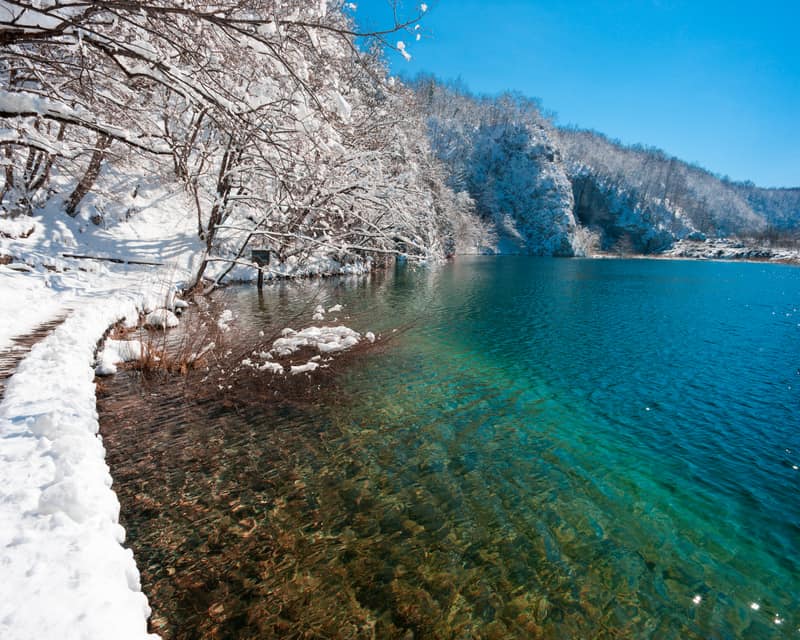
Most ‘resorts’ (that are strongly aimed at summer holidaymakers) and islands will be pretty quiet in winter, it has to be said. However, they are still interesting places to visit (offering up quite a unique opportunity, in fact) as long as you’re prepared for the fact that they definitely won’t be bustling. Many restaurants, bars and so on will be closed, although don’t worry, you’ll always find somewhere to eat.
Weather -wise, some of the interior can get very snowy and cold indeed during winter. The coast normally doesn’t tend to get too cold (temperatures between 0 – 10C/32 – 50F) but it can be quite rainy and/or blustery.
All in all, do consider a visit to Croatia during winter. But just wrap up warm!
More on Visit Croatia
About Visit Croatia
Contact Visit Croatia
Buy us a coffee!
Cookie Policy
Privacy Policy
Updated daily
New & Updated on Visit Croatia
Sightseeing in Pula A Wellness Break in Croatia Stari Grad Obonjan Bol Porec Two Days in Zagreb Slano How to do Croatia on a Budget Two Days in Split Nin Campsites in Croatia City Break in Croatia Two Days in Pula Family Holidays in Croatia 15 Things You May Not Know About Croatia Two Days in Zadar Koprivnica
Useful information on Croatia
Money in Croatia Visa Requirements for Croatia Buses in Croatia Ferries in Croatia Top Ten Destinations in Croatia Map of Croatia About Croatia

The best time to visit Croatia: our season-by-season guide to planning an Adriatic adventure
Whether you’re chasing summer sun, celebrating the harvest, or cozying up for winter festivities, Croatia is a glorious, welcoming country full of postcard-worthy scenery, captivating cities, and joyful festivities.

by Go Ahead Tours team
October 23, 2023
When is the best time to visit Croatia? Whenever you’re ready! Whether you’re chasing summer sun, celebrating the harvest, or cozying up for winter festivities, Croatia is ready to welcome you. Join us on one of our Croatia tours and see for yourself why there’s no bad time to visit this diverse, coastal country.

Croatia: best time to visit by month
Croatia experiences four distinct seasons, but it can be challenging to determine the weather since it varies depending on your proximity to the coast. We recommend packing seasonally and accounting for at least a 10-degree variation between the warmer shores and cooler inland regions. If you want to make the most of your trip to Croatia , check out our recommendations for seasonal activities below.

For lighter crowds and sweet-smelling flowers
There isn’t one best time of year to visit Croatia, but springtime holds a certain magic. The weather is pleasant, with mild temperatures and sunny afternoons interwoven with cool, coastal breezes. The anticipation of the busy summer season may hang in the air, but you’ll find fewer visitors at many of the best locations in Croatia—meaning you won’t have to fight through crowds in popular places like Split’s Diocletian’s Palace or Dubrovnik’s Old City.
“This trip has a little bit of everything the country offers,” said traveler Annalise after returning from our A Week in Croatia: Zagreb, Split & Dubrovnik tour . “It’s not too slow nor too fast-paced. We went in May, and it was perfect and just before the height of the summer tourism season. We had a great guide, bus driver, wonderful hotels, and excellent included dinners. We learned so much about this beautiful country and look forward to being able to go back someday.”
Since the crowds will be lighter, but the weather will be warming up, spring is an ideal time to explore Croatia’s outdoor attractions, like the Roman ruins of Salona or the historical village of Kumrovec. This quaint, riverside town is an open-air museum featuring more than 30 restored buildings. The charming cottages and gardens provide a glimpse into what rural life was like near the Croatia-Slovenia border more than a hundred years ago. Join us on the Kumrovec & Medieval Tabor with Dinner excursion on our A Week in Croatia: Zagreb, Split & Dubrovnik tour to see the landscape awash with spring flowers.
Months to experience spring in Croatia: April and May
Spring events and things to do in Croatia:
- If you happen to visit Croatia around Easter, you’ll find the country blossoming with festivities. Larger cities, like Zagreb, will be adorned with colorful decorations and come alive with music and dance performances. Peruse handmade crafts and sweets in the city’s many markets, attend a religious ceremony, or sit down to eat a traditional meal of lamb or ham with sweet breads and cakes.
- Provence, France, may be seen as the lavender capital of the world, but the Croatian island of Hvar boasts gorgeous, rolling fields of the purple flowers—with breathtaking views of the Adriatic Sea and distant mountainous islands to boot. If you join us on the Korčula Island extension of our Greece, the Balkans & Croatia tour in May, you can use your free time to take an hour-long ferry ride to Hvar to see the fields just as they begin to bloom. Even if you don’t make it to the island, you’ll find lavender from Hvar available to purchase in markets all over Croatia.
Weather in Croatia in the spring: Average temperatures range from 41–69 F.
Travel tip for Croatia in the spring: The inland weather can be chilly in the spring, especially in the morning, so pack light layers. “When you head out on your sightseeing tour of Plitvice Lakes, it will likely be crisp and chilly, no matter the time of year, so make sure you wear a light jacket to keep you warm in the morning,” said staffer Emily. We recommend a light, waterproof jacket that you can tie around your waist or throw in a bag as the day warms up.
What our travelers say about spring in Croatia: “Early May is a good time to see Croatia,” said traveler Cynthia after taking our Croatia & Slovenia: The Old-World Adriatic tour . “Our weather included 70-degree temps and sunny, blue skies with scattered showers that brought out the colors and fresh scents of flowers and ocean. I will never forget the breathtaking views of Dubrovnik from our coach on the way from the airport. I literally gasped at the sharp beauty of blue skies, the ocean, and red tiles on the roofs of the Old City. Yes, I walked the ancient wall around the city, which is a must, as that’s the only way you’ll see the full panoramic splendor of this jewel on the Adriatic. The optional coast cruise and dinner was a pleasant surprise, with fresh fish cooked to order at the table and a beach sunset to die for.”

For island-hopping and sun-drenched days
According to our Croatia Travel Guide , summer is the best time to visit Croatia for days of endless sunshine. The warm Mediterranean climate is ideal for beach vacations and coastal exploration. When you join us on one of our Croatia tours during the country’s peak season, you may have to contend with larger crowds—especially along the Dalmatian Coast in seaside retreats like Cavtat and Korčula— but it’s worth it for the salt-kissed summer breezes. Take a tip from staffer Emily’s book and cool down with a frosty treat while you immerse yourself in the unique musical experience of Zadar’s sea organ. “Instead of getting a sit-down lunch in Zadar, I ordered gelato and enjoyed it while sitting on the steps,” she said. “Good food and seaside views. It’s the perfect combo!” The coastal installation emits calming sounds in response to the gentle movement of the waves.
The warmest months are also the best time to transport yourself to Westeros at Croatia’s many Game of Thrones filming locations . Sure, you can visit the UNESCO-listed Cathedral of St. James in Sibenik any time of year, but the summer heat really makes it feel like you’re walking up to the Iron Bank of Braavos. Winter may be coming, but summer is the perfect time to stroll through the streets on one of our tours of Dubrovnik . Head up the Baroque Staircase, which stood in for the steps leading to the Sept of Baelor, and make your way to Lovrijenac Fortress. (True Westerosis will recognize it as the Red Keep.)
Months to experience summer in Croatia: June, July, and August
Summer events and things to do in Croatia:
- Summer is hands-down the best time of year to visit Croatia if you’re dreaming of sun, sand, and the sapphire Adriatic Sea. Go beach-hopping on the Croatian coast or add the Korčula Island extension on our Greece, the Balkans & Croatia tour for an extra dose of salt air and seaside life. (The Korčula Archipelago Kayaking excursion is a fantastic way to spot local wildlife). While you’re on Korčula, taste wine made from Grk, a rare grape only planted on the island.
- Warm summer nights are the perfect time to head out on the water on the Scenic Dubrovnik Coast Cruise & Dinner excursion offered on our Croatia tours . Cruise beneath the city’s famous soaring walls and dine at a restaurant on the beach. If an excursion on the water sounds like it might be your favorite part of your trip, join us on our Italy, the Adriatic & Greek Islands Cruise to spend 12 days cruising along the Mediterranean coastline.
Weather in Croatia in the summer: Average temperatures are between 56–83 F.
Travel tip for Croatia in the summer: Summer is the peak travel season, so if you’re planning a trip to Croatia, book it now to secure your spot and beat the rush. Staffer Nic said, “If you’re going in the summer, it is HOT, so bring clothes that will be breathable and allow you to move around.”
What our travelers say about summer in Croatia: “I had a fantastic time on this tour,” said traveler David after returning from our Greece, the Balkans & Croatia tour . “Great weather (high 70s and 80s every day), hotels, food, and fellow travelers. The best part was the Adriatic Coast in Croatia and Lake Ohrid in North Macedonia. Dubrovnik and Split were so beautiful.”
Check out these tours

For changing leaves and spectacular sunsets
If you’re planning a trip to Croatia , you should know that visiting the Adriatic Coast in the fall could be a life-changing experience. The weather is warm and mild, and the shorter days mean earlier sunsets, so you’ll have plenty of opportunities to admire them when you’re out and about. Autumn is the best time to visit Croatia if you want to spend some time in its abundant countryside and spectacular national parks. Mid-to-late autumn, after the rains have passed, is one of the best times to visit the Plitvice waterfalls as the water flowing off the falls is at its strongest. Hiking around the terraced lakes of Plitvice Lakes National Park is always a pleasure, but it’s especially exhilarating when the weather is still warm and the foliage is ablaze with color. “This was a fabulous trip,” said traveler Starr of our Croatia & Slovenia: The Old-World Adriatic tour . “The excursions were totally worth purchasing. Our group and local guides well met my expectations. Fall is definitely a time to go due to the beautiful fall colors—truly a bonus.”
Months to experience autumn in Croatia: September, October, and early November
Autumn events and things to do in Croatia:
- Autumn is Croatia’s grape harvesting season, and the whole country celebrates with an array of wine festivals. When you join us on our Croatia & Italy: Dubrovnik to Venice tour , you’ll have the option to add our Pula, Istria Wine Tasting & Dinner excursion for a tasting and a chat with local winemakers. Istria celebrates the harvest with a Wine & Walk, which typically takes place in mid-October. Participants hike through the region’s vineyards with glasses of wine in hand, stopping along the way to taste and judge local offerings.
- The fall harvest season is also a wonderful time to visit a Croatian agriturismo. When you join us on our Greece, the Balkans & Croatia tour or on the Konavle Wine Tasting & Lunch excursion offered on our A Week in Croatia: Zagreb, Split & Dubrovnik tour , you’ll head to a family-run farm in the Konavle Valley to learn about the fruits, vegetables, and flowers grown on the farm. Tour their gardens, then sit down in the warm autumn sunshine to enjoy lunch and a sampling of traditional liqueurs made from the farm’s produce.
Weather in Croatia in the autumn: Average temperatures are between 48–77 F.
Travel tip for Croatia in the autumn: The autumn abundance brings a wealth of seasonal delicacies to Croatian cuisine. Look for dishes featuring chestnuts, truffles, olives, quince, and game meats when you’re dining out on your tour of Croatia .
What our staffers say about autumn in Croatia: “I traveled to Croatia at the end of September into early October, and I could not have asked for better weather,” said staffer Emily. “Our Tour Director even told us that the fall was one of his favorite times to visit the country because it’s the perfect temperature and all of the summer crowds have returned home. He was completely right!”

For festive lights and hearty meals
It’s no secret that we love off-season travel. From lower prices to lighter crowds and holiday festivities, there are so many reasons to travel in the off-season . If you join us on a tour of Croatia between December and February, you’ll get all of these benefits and more. Coastal towns like Rovinj and Dubrovnik look downright magical, with their narrow streets adorned with decorations and their holiday lights reflected on the calm winter sea. Cities like Zagreb are lively year-round, and winter is the best time to visit Croatia if you want a chance to really get to know the locals. Sip some mulled wine or rakija—a popular Croatian spirit made from distilled fruit—while chatting with some new-found friends, and you’ll soon realize why our A Week in Croatia: Zagreb, Split & Dubrovnik tour made the list of our favorite week-long off-season trips .
Croatia’s ski resorts might not be as famous as those in France, Switzerland, or Austria, but the country is home to several mountain ranges, and skiing in Croatia is a much more affordable pastime than it is in other parts of Europe. If you’re a ski enthusiast, we recommend designing a custom tour with us to visit some of Croatia’s best Alpine destinations, like the Gorski Kotar region or the Platak Ski Resort. If you choose to visit Sljeme, the highest peak in the Medvednica mountain range outside of Zagreb, make your way back into the city for a hearty seasonal meal of čobanac (a spicy meat stew) or sarma (cabbage rolls stuffed with meat and rice) to warm up after a day on the slopes. The nearby Terme Čatež thermal pools are another excellent way to relax and enjoy Croatia in the wintertime.
Months to experience winter in Croatia: December, January, and February
Winter events and things to do in Croatia:
- Istria may be completely absorbed in wine in the autumn, but in the winter, the peninsula is all about the truffle hunt. Each year, locals and visitors take to the forests in search of the gourmet treasures. Even if you don’t make it out for the hunt, you’ll find plenty of opportunities to sample Istria’s truffles throughout the country in the form of pastas, oils, and even ice cream.
- In the winter, there’s nothing quite as cozy or as cheerful as a European Christmas market. Advent in Zagreb runs from November through January and transforms the Croatian capital into a sparkling winter wonderland. The Christmas markets spread throughout the city are the perfect place to shop for souvenirs , and the city comes alive with music, dancing, and entertainment.
Weather in Croatia in the winter: Average temperatures are between 30–53 F.
Travel tip for Croatia in the winter: While we love that winter in Croatia means lower prices and thinner crowds at our favorite sites, it also means reduced services and hours for many businesses—especially those on the coast. If you’re venturing out in your free time with a destination in mind, plan ahead and double-check their hours.
What our staffers say about winter travel: “One of the things I loved about winter travel is that I didn’t break the bank, financially or with vacation time,” said staffer Jim. “I love traveling around Christmas and New Year’s because you can get a lot of low-cost options, particularly right after the new year. For vacation time, traveling over two different calendar years can help save some vacation days for summer months, and the cluster of paid holidays a lot of people get between December and January helps, too!”

Shoulder season
For discovering hidden gems.
Early spring and late autumn are considered the shoulder seasons in Croatia, and they bring with them the lightest crowds and deepest discounts. It’s a lovely time to explore some of Croatia’s charming hidden gems, like the tiny island of Trogir. The tranquil, pedestrian-only town is a UNESCO World Heritage Site and was founded by the ancient Greeks. The shoulder season is the ideal time to leisurely wander cobblestone streets like a local and snap some perfect, unobstructed photos of beautiful Croatia .
Months to experience the shoulder seasons in Croatia: March through early April and November
Shoulder season events and things to do in Croatia:
- Every March, the quaint seaside town of Ston hosts an oyster festival to celebrate its famous export. Ston’s oysters are internationally recognized for their exceptional taste and texture. Join us on our Croatia & Italy: Dubrovnik to Venice tour or the extension of our Greece, the Balkans & Croatia tour to meet with local fishermen and learn about shellfish cultivation aboard their ship.
- The cooler months of the shoulder season are ideal for walking the high walls of Dubrovnik—one of the best ways to spend free time in Dubrovnik . The view from atop the centuries-old fortifications is spectacular, but there isn’t much shade, which means it can get quite hot in the summer sun. Visit Dubrovnik in the shoulder seasons for a pleasant stroll and magnificent views of the Old Town and the Adriatic Sea.
Weather in Croatia in the shoulder season: Average temperatures range between 37–57 F in early spring, and between 41–59 F in the late fall.
Travel tip for Croatia in the shoulder seasons: March and November can both be rainy in Croatia, so pack an umbrella or a raincoat.
What our travelers say about the shoulder seasons in Croatia: “This great tour took us to four countries and at least seven UNESCO World Heritage Sites,” said traveler Davara of our Croatia & Slovenia: The Old-World Adriatic tour . “With few exceptions, visits were outside. We experienced a wonderful blend of locations of historical significance and places showcasing the spectacular beauty of nature. There was a specialized local guide for almost every location. Free time provided additional opportunities for tour personalization, and we received excellent recommendations for places to see, things to do, and restaurants for non-included meals. For our mid-to-end-of-April tour, the weather was cool and mostly cooperative.”
The best time to travel to Croatia? As soon as possible! Join us on one of our trips to Croatia .
About the author
Go Ahead Tours team
We’re a team of passionate travel experts, dedicated to helping people explore the world. From inspiring stories to tips for an amazing trip, the topics we cover are all about getting you out there and making discoveries.
Related tours
More travel inspiration, save up to $400 by 8/28.
Time’s ticking—lock in your best tour price before they increase after 8/28.† Your next adventure awaits.

7 destinations that’ll whisk you to the world of “A Court of Thorns and Roses”

Winter blues got you down? Here are the 10 best cities in Europe to visit this summer to shake off the cold

Traveler reviewed trips to book for Southern Europe this Black Friday

Ready to spend a week in Europe? You don’t want to miss these 10 trips in the off-season

7 reasons to visit Dubrovnik, Croatia

11 of the best cities in Croatia that you can see on one tour

8 of the best places to travel solo this spring

15 incredible new tours you should add to your travel wish list

The best places to visit in August to stay cool, see wildlife, or get off the beaten path

7 top-reviewed trips to popular destinations you should book this Black Friday

6 things to experience your first time traveling to Europe

Booking a summer trip? Here are 7 unique places to travel that are popular for Europeans

Best beaches in Europe to visit based on your interests

The 6 best sunset spots in the world
A look at time zones around the world

The Go Ahead Travel Guide to Croatia

5 reasons to travel to the Balkans

My Trip in 5 Photos: Exploring beautiful Croatia

4 Reasons to visit Mostar
The Best Time To Visit Croatia (& The Top Activities to Do!)
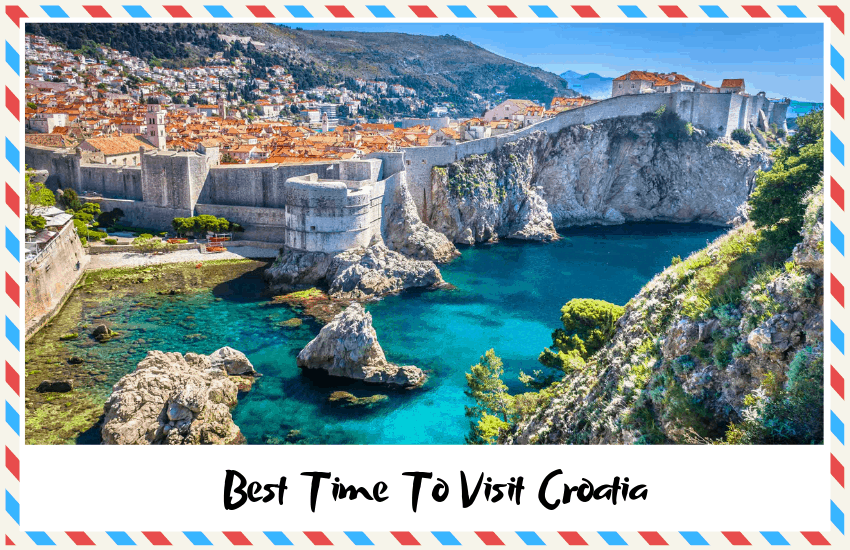
- Latest Posts
- KLM vs Air France: Which is Best? - January 17, 2022
- 6 Best Samsonite Backpacks for Travel Under $100 - January 12, 2022
- The Best Time To Visit Portugal – Get the Most Out of Your Trip! - January 11, 2020
Why visit Croatia?
A crossroads of cultural influences, the dalmatian coast.

Stari Grad Plain

Istria County
Diverse natural heritage.

- Mediterranean along the Adriatic coast – Identified by dry summers and mild winters.
- Alpine in the regions of Gorski Kotar and Lika – Climate region above the tree line.
- Pannonian in Danube and Drava – A grassland ecosystem as found in the Pannonia Basin.
- Continental in the remaining areas, characterized by hot summers and cold winters.
- Krka National Park – Featuring the Krka river and swelling waterfalls.
- Brijuni Islands National Park – Where beautiful scenery meets fascinating archaeological remains.
- Mljet National Park – With white sandy beaches, lush green forests and pearly blue waters.
- Risnjak National Park – Home to wild forests and rugged mountain ranges.
- Paklenica National Park – With dramatic canyons cutting through a rich ecosystem.
- Sjeverni Velebit National Park – The largest mountain range in Croatia.
- Kornati National Park – A group of stunning islands perfect for the avid sailor.
- Ucka Nature Park – Climb the 1401 peak for amazing views.
- Biokovo Nature Park – A rocky landscape ideal for hikers with sweeping views of Adriatic Sea.
Best Time Of The Year To Visit Croatia
The climate in croatia.

Croatia’s winds: a part of life and a part of legends

Top Activities And Average Temperatures By Season

Spring (March – June)
- International Documentary Film Festival in Zagreb (March)
- Sailing and swimming (in May and June)
- Dance week Festival in Zagreb (June)
Summer (June – September)

- Dubrovnik Summer Festival (July)
- Split Summer Festival (July)
- Full Moon Festival in Zadar (August)
Summer is the busiest and most expensive time of the year . Croatia celebrates this rush of tourists by providing entertainment and offering a wide variety of activities and day-trips, especially during the months of July and August . In these months, Croatia also hosts various spectacular festivals like most other European countries. While the above mentioned festivals are the biggest ones around at this time, you can expect music and performances practically very evening during high season.
If you are traveling for a specific event or are just looking to enjoy long, hot days, summer will be a good time for you. However if you are looking to soak up some culture and visit some of the stunning national parks, it is better for you to travel in Spring or Autumn.
Autumn (September – December)
- Varazdin Baroque Evenings (September)
- Zagreb Film Festival (October)
- Istrian Truffle Days (October)
- Festival of animated film (November)
September is another delicious month to travel with the warmth still in the air and the tourists on their way back home . Since summer has just ended, you will still be able to take advantage of the usual summer offers such as regular ferries to get around on the islands and organized day-trips. On some days, it is even still possible to head out for a swim.
Once October rears its head, be prepared for a country that is slowly settling into its everyday routine, including harvest season which is now in full swing. Tourism is no longer the number one concern and even ferries go on their winter schedule until the month of May. This makes October one of the more interesting months for those who travel independently, but not for those who enjoy organized tours.
From November, tourism hibernation will have settled in deeply around the country and culture holidays will be the number one trip to organize for you and your family. This is your chance to fully connect with the locals as they are, not with the show they put on during high season .
Winter (December – March)

- February Carnival
- Feast of St. Blaise in Dubrovnik (February)
- Skiing and hiking
Frequently Asked Questions
What is the food like in croatia, where are the game of thrones sets in croatia.

Do I need a visa to travel to Croatia?
Is croatia a safe place for tourists.

How big is Croatia?
What is the local currency in croatia, how do i get around in croatia, is croatia expensive.

The Best Time To Travel To Croatia – Final Thoughts
- Epic Destination List: Most Popular Travel Destinations!

- Living In Croatia
- Croatian Recipes
- Balkan Recipes

Home > When Is The Best Time To Visit Croatia For 2024
When Is The Best Time To Visit Croatia For 2024

Written by our local expert SJ
Sarah-Jane has lived in Croatia for 10+ years. SJ, as she is known, has been traveling the Balkans & beyond since 2000. She now shares her passion for traveling with her husband & kids.
This is the best and only guide that you need to know when the best time to visit Croatia is – written by two locals who have lived in Croatia for more than ten years!
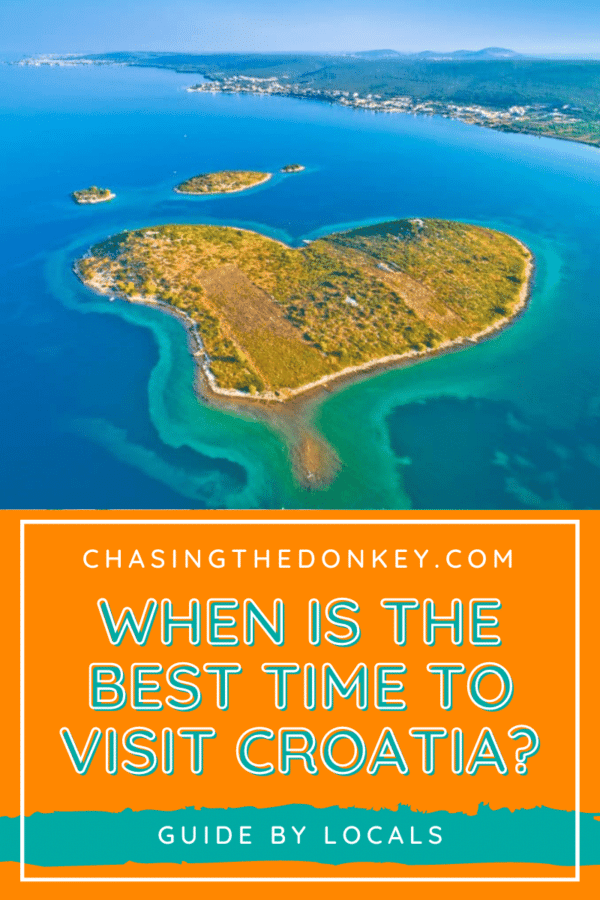
Croatia has become increasingly popular as a tourist destination in Europe over the last decade that I have been living in Croatia, and it’s not surprising!
There are stunning white sand beaches , gorgeous islands with a Mediterranean feel, beautiful lake s and woodlands, and lively historic cities to explore.
There’s not much you can’t do in Croatia, so it’s also an excellent destination for families looking for somewhere with a range of activities to keep everyone happy. Whether you want to be rafting down rivers , hiking in the mountains , or sunbathing on the beach – Croatia is the place to go.
But before you start packing your bags and buying plane tickets, it’s worth considering what you want to do on your holiday so you can figure out the best time to go.
- What To Pack For Croatia
Skip Ahead To My Advice Here!
Croatia Travel Seasons

Most people consider the summer months the best time to visit Croatia. It can get quite hot in summer, but the sunny weather and soaring temperatures are perfect if you plan to sunbathe for most of your holiday and drink cocktails on the beachfront.
On the other hand, spring and autumn have their appeal. While winter can get quite cold, spring is mild and sunny, and autumn is far less crowded, thanks to everyone heading home after the peak summer season.
It’s also worth remembering that the coast is always warmer than inland, even in winter. At this time of year, the coast of Croatia is worth visiting as long as you’re more interested in sightseeing than sunbathing and you don’t mind putting up with occasional rain.
That said, one major drawback of visiting in winter is that you can’t guarantee things will be open. Local business owners tend to take time off in the winter when there aren’t many visitors around, so it’s not unusual for hotels and restaurants to shut down in areas that rely on tourism.
- What To Do In Croatia During Spring
- Best Things To Do In Winter In Croatia
Temperatures In Croatia Throughout The Year
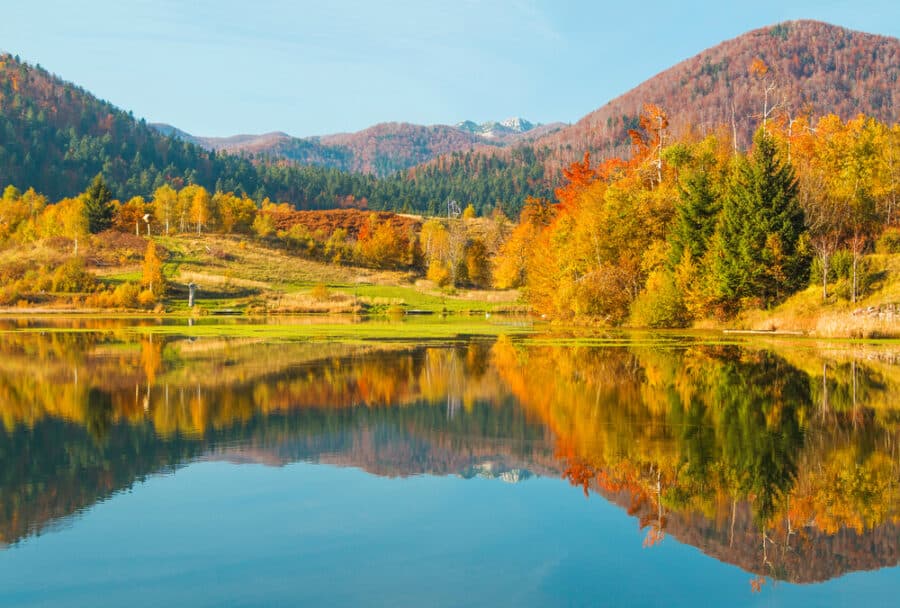
Temperatures vary a lot depending on where you are. To get an idea of the difference in average temperatures in Croatia between the coast and inland, let’s have a look at the temperatures during the year in Split and Zagreb .
Once you know Croatia’s temperatures by month, it’ll be easier for you to decide when the best time to visit is.
December & January Temperatures – Low Season
To start with, December and January are the coldest months of the year, with lows of -2 degrees and highs of 5 degrees in Zagreb. It’s a fair bit warmer along the coast, with lows of 4 degrees and highs of 12 degrees in Split, but it’s definitely not ideal beach or sightseeing weather.
February & March Temperatures
February is slightly warmer, but it’s worth waiting until March when temperatures rise considerably. It’s still chilly in March, with lows close to zero degrees in Zagreb and highs of about 15 degrees even on the warmest days in Split .
April, May & June Temperatures. – Shoulder Season
Ideally, you want to be visiting Croatia in April, May, or June. These are the most pleasant months temperature-wise, with highs oscillating around 20 to 25 degrees and lows of about 7 in April and 14 degrees in June in Zagreb. The coast is warmer again, with highs reaching almost 30 degrees by June and lows staying above 10 degrees throughout April, May, and June.
July & August Temperatures – High Season
In July and August, temperatures don’t drop below 15 degrees in Zagreb, and warm days reach almost 30 degrees. On the other hand, Split doesn’t get cooler than 20 degrees, and super hot days reach over 30 degrees.
September, October & November Temperatures – Shoulder Season
September and October are mild but still holiday-worthy. Split still has highs well over 20 degrees in September, with a slight drop in temperature happening in October, and even the coldest days don’t drop much below 15 degrees.
There’s a noticeable difference in temperatures in Zagreb, though, with lows of 12 degrees in September and 7 degrees by October. However, there are occasional days when the city hits 20 degrees or more in September, and highs in October oscillate around 15 degrees.
November is cooler still, and temperatures drop significantly, especially in Zagreb, in the lead-up to winter.
Overall, the best time to go to Croatia is from April to June , or holding off and visiting in September after most of the big crowds of tourists are gone. May is arguably the best month to visit Croatia, and spring and autumn are the best time of year to see if you want to save money and avoid other tourists.
When To Go To Croatia On A Budget

If money is a big factor in your holiday, and you’re looking to travel on as little as possible, then avoid Croatia in the summer, when all the cruise ships start sailing in, and tourists from around the globe make their way to the coast to enjoy the sun and sand.
It has to be said that Croatia isn’t a seriously expensive destination, which is part of why it’s so attractive compared to other countries in Europe, but prices definitely go up in summer.
Late spring and early autumn are great times to visit Croatia without making a big dent in your bank account. The weather is warm in late spring, and businesses are starting to open back up after the winter, but there aren’t many people around, so prices are much lower.
In autumn, things are starting to cool down after the summer, temperature and crowd-wise, but everything is still open, and it’s warm enough, even in early November, to laze on the beach and snorkel.
One of my first trips to the country was in late September back in 2000; I was on a budget without missing out on anything. I stayed with locals and in the occasional small hotel , cooked when there was a kitchen available but still ate out a fair bit, and traveled to all the major tourist destinations (Plitvice Lakes, Zagreb, Split, and Dubrovnik) without having to miss out on adventure sports or sightseeing.
Of course, I made some compromises, like buying a cheap snorkeling set and exploring the waters closer to shore rather than going on a snorkeling tour. Still, I honestly didn’t feel I missed out on anything on my Croatia bucket list because of my shoestring budget!
- How To Travel Croatia On A Budget
When To Go To Croatia To Party

If anyone knows how to party, it’s the Croatians. They leave it all on the dance floor, and their enthusiasm will keep you up till sunset more than once!
July in Croatia is when most of the nightlife seekers come. University students have finished their exams and are ready to de-stress and go wild while everyone else starts cashing in their time off from work.
While summer is party season around the globe, Croatians have a way of keeping spirits high year-round. So even if you come outside of peak season, you’ll find it hard to avoid the nightlife.
I distinctly remember checking into a hotel in Zagreb in late October to get an early night, only to arrive and find all the locals had shown up for karaoke night!
I’ve never seen anything like it. Safe to say I didn’t make it to bed till after sunset…
Head to Pag, Hvar, Brac, Dubrovnik, or Split if you’re solely in Croatia to party!
- Where To Party In Croatia
Brands We Use And Trust
When to visit croatia for water sports.
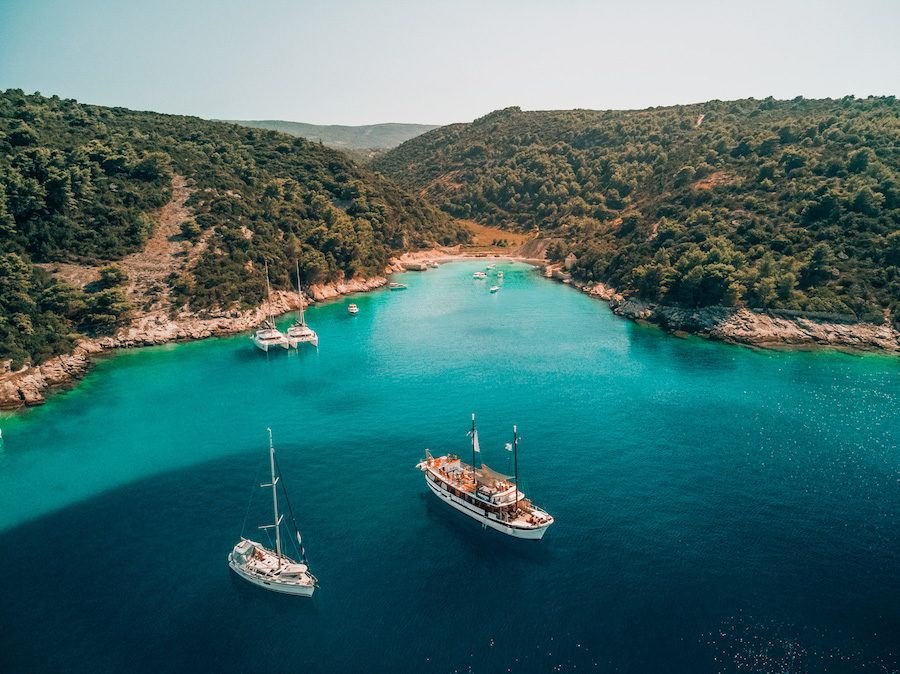
Hello, glorious summer! While late June through to early September aren’t as budget-friendly, it’s definitely the best time of year to visit Croatia for water sports. The warm Adriatic Sea and unique aquatic fauna will make the water hard to resist!
There isn’t just swimming, snorkeling, and scuba-diving , though Croatia is also a hotspot for sailing, rafting, and cruise ships from all over making overnight stops along the coastline.
If you’re planning anything crazy, like renting a yacht for a birthday celebration or going island hopping on a private sailing boat , be sure to book way in advance over the summer months, or slots will get full up – one of the biggest drawbacks of visiting Croatia in the summer.
Outside of peak season, island hopping is also a great thing to do; you’ll get a whole island beach to yourself off the coast of Zadar in October!
If you’re an avid sailor and you want to explore the Adriatic Sea – go sailing in Croatia in September . Lots of sailors will give you this advice, and there’s a good reason for it.
The prices of yachts and sailing boats are lower in September as peak season is over, more rentals are available, the sea and marinas are less busy, and temperatures are still great.
September offers sailors a mix of perfect sailing conditions and fewer crowds, all for a lower price!
- Why You Should Book A Sailing Trip In Croatia
Best Time To Go To Croatia For National Parks
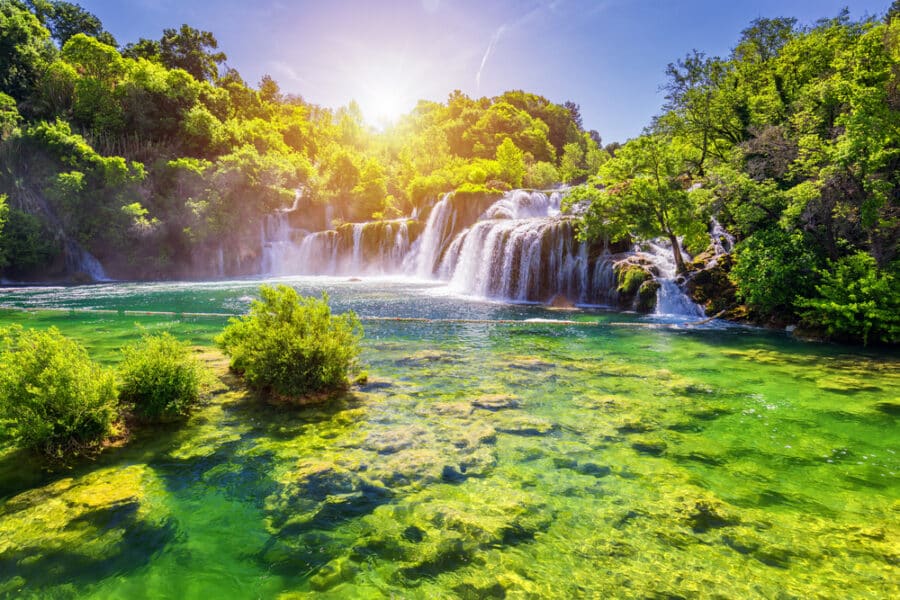
The best time to visit Croatia if you want to visit national parks is spring! It’s not as hot as in the summer, which is a relief if you’re planning on going on long hikes in nature. There’s also very little rainfall in spring, and the lakes and rivers are brimming with water as the winter snow begins to melt.
Suppose you’re planning on going to Croatia in April. In that case, it’s worth checking the temperatures and rainfall in different areas before deciding what national parks you want to go to, as early spring can be a bit hit-and-miss weather-wise. The weather in Croatia in May and June is much more reliable!
Some of the best national parks in Croatia, and there are loads to choose from, are Krka, famous for its stunning clear-blue waterfalls, and Plitvice National Park, a labyrinth of pristine lakes .
Pack your hiking boots and get ready to enjoy Croatia’s incredible national parks without the crowds!
While spring is the best time to visit the country’s national parks overall, some might be worth saving until the summer (but bear in mind there will be more tourists around).
Mljet National Park , which is made up of a network of islands off the coast of Dubrovnik, and Kornati National Park, which is an archipelago in the Northern Dalmatia region known as every sailor’s heaven are hotspots for watersports, so they’re worth visiting in the summer if you want to make the most of the kayaking, sailing, and snorkeling!
- How To Choose Between Krka & Plitvice National Parks
- Where To Stay In Plitvice Lakes
Best Time To Go To Croatia For Festival Season
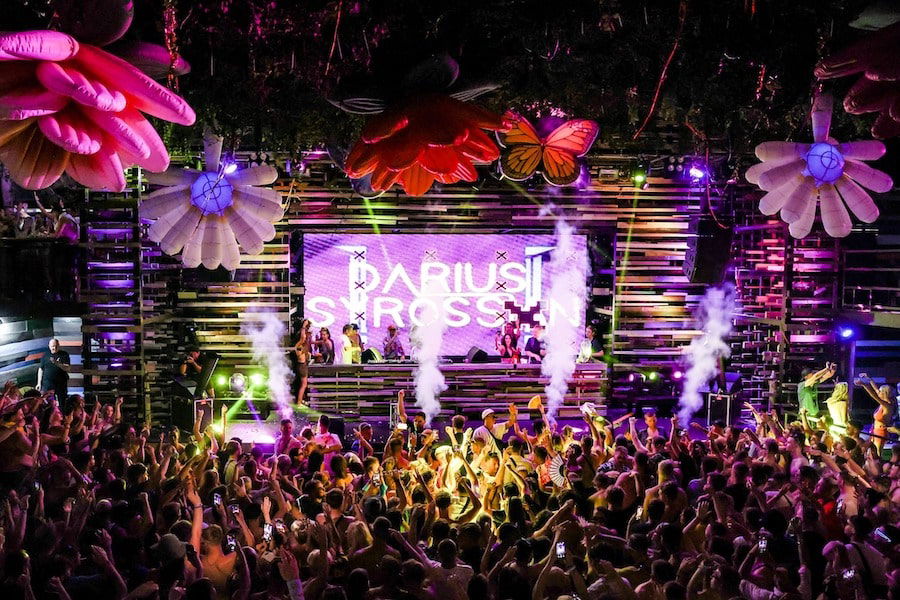
Croatia has a unique culture and heritage, which, mixed with the high spirits of the locals and a few glasses of wine , make their festivals one-of-a-kind. May through September is the best time to visit if you want to dance at music festivals or get an insight into the local culture.
The most well-known festivals are the Nights of Diocletian, the Festival of Flowers, the Dubrovnik Summer Festival, and Zagreb Design Week. They showcase a mixture of Croatia’s old traditions and the country’s modern flare.
There are also a handful of music festivals across the country in spring and summer, like the INmusic Festival, Sonus Festival, and Hideout Festival.
Whether you want to go raving or take part in strange traditions – Croatia has a festival for you.
- Music Festivals In Croatia
- Our Favorite Festivals In Istria
- Festivals In Croatia Not To Miss
Best Time To Go To Croatia With Kids

Traveling with kids can be tricky, especially when they’re little. The tantrums are often as frequent as the memorable moments, so it’s definitely easier to travel to less crowded destinations if you’re going with little ones, and being able to keep things affordable is another plus.
But, with school dates and work, it’s not always easy to go on holiday outside peak season. Ideally, try and make it in late spring or early autumn, and make the most of a half-term week or Easter holidays if you’ve got young children; that way, you’ll avoid being in big crowds or missing out on activities because everything is booked.
On the other hand, if you’re traveling with older kids and you want to do as many activities as possible, summer is the best time to come. It’s worth booking things in advance to avoid disappointment, and the prices increase, but the weather is perfect for beach holidays and water sports!
- What To Expect When Traveling To Croatia With Kids & Babies
- Things To Do In Croatia With Kids
- Backpacking Croatia With Kids
The Best Time To Visit Croatia’s Major Cities
Sightseeing can be super exhausting when it’s really hot, so it’s worth exploring Croatia’s cities in the cooler months. Generally, April, May, September, and October have temperatures ranging from the mid–teens to early twenties, making them the best months for a city break.
On the other hand, if you really want to experience Croatia when no one else is around, then November to March is the best time. Cities along the coast are cool but pretty mild throughout the winter months, though further inland, it is definitely colder.
Another date to consider being in one of Croatia’s major cities is the 25th of June, which is Statehood Day! Locals unite to celebrate the date Croatia gained independence with cultural events and street parties!
Let’s dive deep into the best places to go in Croatia and when!
The Best Time To Visit Dubrovnik
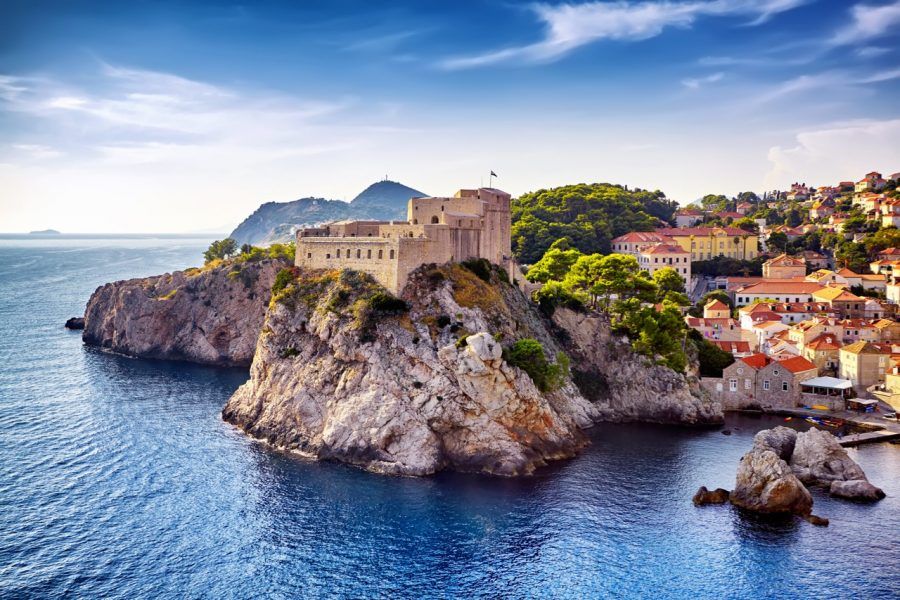
Possibly the most famous city in Croatia, Dubrovnik is as far south along the coast as most travelers go. The city dates as far back as the 7th century and encompasses all the best features of the Dalmatian coast.
The old city walls are a UNESCO World Heritage Site , and as you walk along them, you’ll find lots of artsy cafes, restaurants serving delicious fresh fish, and historical spots.
It’s worth going on a day tour to Lokrum Island and taking the cable car to Mount Srd !
The best time to visit Dubrovnik is off-season , as it’s a super popular destination, and it gets crammed with tourists in the summer. If you’re coming to Croatia in May, during the shoulder season, you’re in luck! This is a great time to head to Dubrovnik – it’s warm, but the cruise ships full of passengers haven’t started rolling in, and hotels won’t be booked out yet.
- Where To Stay In Dubrovnik
- Winter In Dubrovnik? Yes Indeed!
- Best Things To Do In Dubrovnik
The Best Time To Visit Split

Split is the second largest city in Croatia. The old town of Split is a stunning maze of narrow cobbled streets that lead you to open squares and city beaches.
I’d recommend going in the summer to make the most of the city’s beaches, wild nightlife, sightseeing, and outdoor restaurants . Although it’ll be busier than other months, the crowds also mean everything will be open, and more events are on!
If you want to experience a unique cultural event, then you could also come for Saint Domnius Day on the 7th of May and celebrate the city’s patron saint. There are processions, traditional klapa music, street fairs in the evening, and even a rowing contest!
- Where To Stay In Split
- Best Day Trips From Split
- Things To Do In Split
The Best Time To Visit Zagreb

Croatia’s capital city is cute and not as big and overwhelming as some of Europe’s more famous capitals, like Paris and Milan! It’s also much cheaper but still packs a lot of charm and plenty of sightseeing opportunities – making it one of my personal favorites.
It’s one of the colder destinations in Croatia, but coming into the depths of winter is still a top option; autumn is pretty cold and rainy. If you can come in late spring (May and June) or early September, you’ll enjoy the best weather and have the city to yourself!
- Where To Stay In Zagreb
- Zagreb’s Christmas Markets
- Things To Do In Zagreb
The Best Time To Visit Zadar
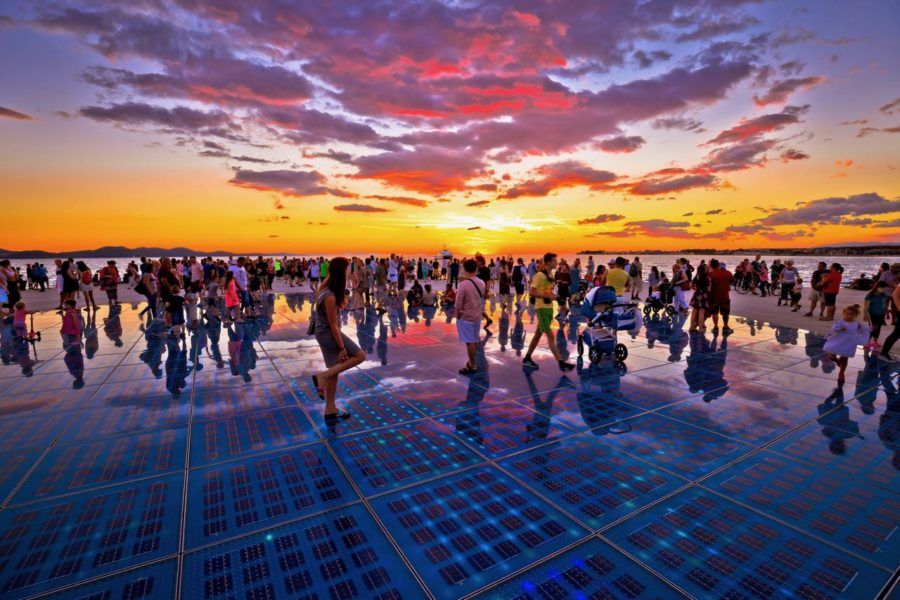
Zadar is less popular than other cities in Croatia, but it’s one of my personal favorites as it’s where I live. It’s surrounded by cute islands with small towns on them that few people visit. The city is riddled with Roman ruins, and it sits at the base of the Velebit mountain range, so there are plenty of hiking trails nearby.
The edge of the city is a long promenade that you can jump off straight into the sea! It boasts some of the best sunsets and is home to the famous Sea Organ and Sun Salutation.
As it’s along the coast, the autumns are warm, and there’s little rain. You can enjoy sunny weather until early November, but it does get ominous quiet! I’d go in late spring when there are still other people out and about and everything is starting to open up.
- Where To Stay In Zadar
- Best Beaches In Zadar
- Things To Do In Zadar
The Best Time To Visit The Coast And Go Island Hopping In Croatia
Croatia has a diverse set of landscapes, and depending on what you want, some seasons are better than others. While hiking in national parks is more enjoyable in autumn, island hopping is a great thing to do in the summer or late spring.
There are about 1,200 islands off the coast of Croatia , so it’s fair to say that wherever you are along the Dalmatian coast, you’ll be able to reach a little island in the Adriatic with a short boat ride. It’s also one of the reasons that Croatia is so popular for sailing!
A great number of the islands are inhabited, so there’s a whole island sub-culture in Croatia that is very different from that of the mainland. The islanders are generally very friendly and generous, too!
One time, I was on a small island off the coast of Zadar, and an older woman came running out of her house and gave me a bag of pomegranates and a smile for no reason!
There’s a huge choice of islands you can go to; some are so small they have little more than a lighthouse turned Airbnb on them designed to accommodate the most solitary holidaymakers; others were once the home of Tito’s political prisoners. Others attract party lovers thanks to their bustling nightlife!
Whichever island you decide to visit if you’re wondering when the best time to visit Croatia’s islands and coast is, you’ve come to the right place.
Best Time To Visit The Dalmatian Coast
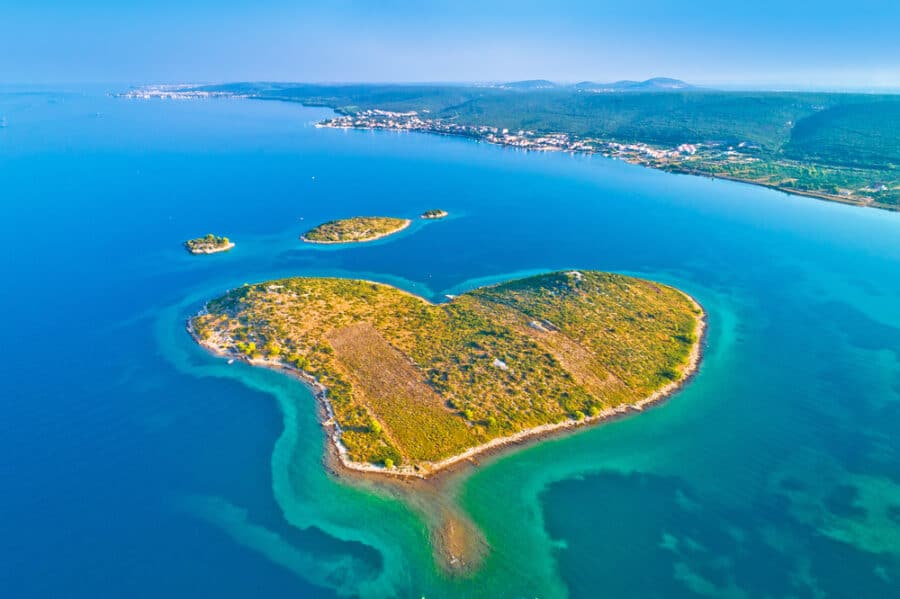
The Dalmatian coast is one of the more year-round, travel-friendly destinations. From warm and mild winters to scorching hot summers, you don’t need to worry about the weather when booking your Dalmatian Coast trip.
If you’re coming over the winter months, pack light layers and a raincoat, but remember to bring warm clothes if you want to head into the mountainous regions along the coast, as the higher up you go, the more likely there’ll be frost and snow.
Spring and autumn have some rainy days, especially in April, September, and October, but they still get a lot of sun, and the drop in temperatures compared to the summer months is no bad thing – July and August really can get too hot!
Over the summer months, it’s usual for it to get to 30 degrees throughout the day, and even at night, temperatures rarely drop below 20 degrees. It’s not hard to see why you’d be looking to catch a summer tan love coming to Croatia in July and August.
Another thing worth thinking about is the sea temperature. If you’re visiting the coast, you’ll want to spend as much time as possible in the water, but snorkeling is far less fun when the water is cold and your lips start turning blue!
From June until October, the sea temperature is consistently above 20 degrees. From November onwards, there’s a drop in temperature, but even in January, February, and March, the water doesn’t drop below around 14 degrees. If you’re used to swimming in the Atlantic, the Adriatic Sea is going to feel more like a bath than a dip in the ocean!
The Dalmatian coast is split up into three regions: northern, central, and southern Dalmatia.
Top destinations along the Dalmatian coast include Zadar (in the north), Split and the islands of Brač (in central Dalmatia), and Dubrovnik and the island of Korčula (in southern Dalmatia).
- Where To Stay In Korcula
Best Time To Visit Hvar Island

The stunning Hvar Island has a lot of historical sites, like the Stari Grad plains, a UNESCO World Heritage Site, and the Hvar theater, constructed in 1612.
The Illyrians, Greeks, Romans, Byzantines, Croatians, Venetians, Austrians, French, and Italians ruled the island. Thanks to the array of civilizations that have influenced the island, it has a unique and diverse set of traditions that have shaped its people – known to be some of the friendliest and warmest around!
There are a few different destinations worth considering for accommodation, like Hvar Town itself, Stari Grad, and Jelsa. They all have a cute fishing-town feel to them and stretches of gorgeous coast to explore.
Hvar town is the busiest and the most expensive – though it does have the best nightlife and the fanciest places to eat and stay. Jelsa has some charming beaches, though they aren’t all sandy, and it’s a lot quieter than Hvar.
On the other hand, there are also a handful of small villages you can choose from, like Vrboska, Milna, and Sveta, if you’re looking for a peaceful island escape.
Weather-wise, the best time to go to Hvar and the surrounding islands is from June through to October.
With temperatures reaching 30 degrees and sea temperatures reaching 25 degrees in July and August, visiting over the peak summer months is tempting. Still, the prices of accommodation and tours really do skyrocket.
- Where To Stay In Hvar
- Secret Things To Do On Hvar
Best Time To Visit Vis Island

The island of Vis is cute and covered in small towns with a very authentic local feel to them. However, the main reason people visit isn’t really the island itself – it’s the blue cave of Biševo just off the island’s shore that has everyone in a craze.
Curiously, the island was the Yugoslav National Army base from 1950 to 1989, during which tourists weren’t allowed on the island. Now, the two hotspots around the island are Vis Town and Komiža.
Like Hvar, late spring is a great time to come to Vis if you want to avoid the crowds and make the most of the cheaper accommodation.
Best Time To Visit Rab

The island of Rab became popular after King Edward VIII took his wife, Wallis Simpson, here in 1936. It’s nestled into Kvarner Bay and popular thanks to its nudist-friendly beaches. According to legend, the tradition was kickstarted by King Edward VIII himself.
Rapska Fjera is the oldest and largest medieval festival in Croatia, and it all began when Rab Town Council decided to pay tribute to King Louis the Great, who freed the island from Venetian rule. It used to last two weeks, but now it lasts just two – from the 25th to the 27th of July. Small artisan stalls and craft workshops pop up around the island’s towns, and everyone dresses up and enjoys vast amounts of wine in true medieval spirit!
Rustic and quaint, the towns here are a patchwork of terracotta roofs and church towers. There are plenty of festivities throughout the summer months, too, and as it’s lesser known than other islands, it’s a popular destination for families especially. It’s worth coming in peak season when the weather is at its best, or for the festival in late July, the first part of August is also ideal!
What is the best time to visit Croatia for a beach vacation?
The best time to visit Croatia for a beach vacation is during the summer months, from June to August. The weather is warm and perfect for swimming in the Adriatic Sea.
When is the ideal time to explore Croatia’s national parks?
The ideal time to explore Croatia’s national parks is during the spring (April to June) and autumn (September to October). The weather is pleasant, and the parks are less crowded compared to the peak summer season.
What is the best time to visit Croatia to avoid crowds?
If you prefer to avoid crowds, consider visiting Croatia in the shoulder seasons of late spring (May) or early autumn (September). During these months, the weather is still pleasant, but tourist numbers are lower.
Is winter a good time to visit Croatia?
Winter can be an excellent time to visit Croatia if you enjoy festive holiday markets and cultural events . Coastal towns and cities like Dubrovnik and Split are less crowded, but some tourist attractions may have reduced operating hours.
What are the weather conditions like in Croatia during the summer?
During the summer, Croatia experiences hot and sunny weather, especially along the coast. Temperatures can reach highs of 30°C (86°F) or more, making it perfect for beach activities and water sports.
When is the best time to visit Croatia for cultural festivals?
If you’re interested in cultural festivals, consider visiting Croatia during the summer months when many cities host events like music festivals, art exhibitions, and traditional celebrations.
What is the rainy season in Croatia?
The rainy season in Croatia typically occurs during the late autumn and early spring months. November and March are known to have increased rainfall, but it can vary each year.
Are there any specific events or activities during the best time to visit Croatia?
Yes, during the best time to visit Croatia, you can enjoy events like the Dubrovnik Summer Festival, Ultra Europe Music Festival in Split, and various water sports and beach activities along the Adriatic coast.
Phew, that was a lot, right? I hope you now feel like you know the best time to go to Croatia for what interests you.
Leave a Reply Cancel reply
Your email address will not be published. Required fields are marked *
Save my name, email, and website in this browser for the next time I comment.
This site uses Akismet to reduce spam. Learn how your comment data is processed .
Move This Adventure To Your Inbox & Get An Instant Freebie
Subscribe To Unlock Your FREE Customizable Travel Packing List & All Our Best Tips!
Unlock Your FREE Customizable Travel Packing List!
Subscribe Now For Instant Access To Stress-Free Packing
or with email
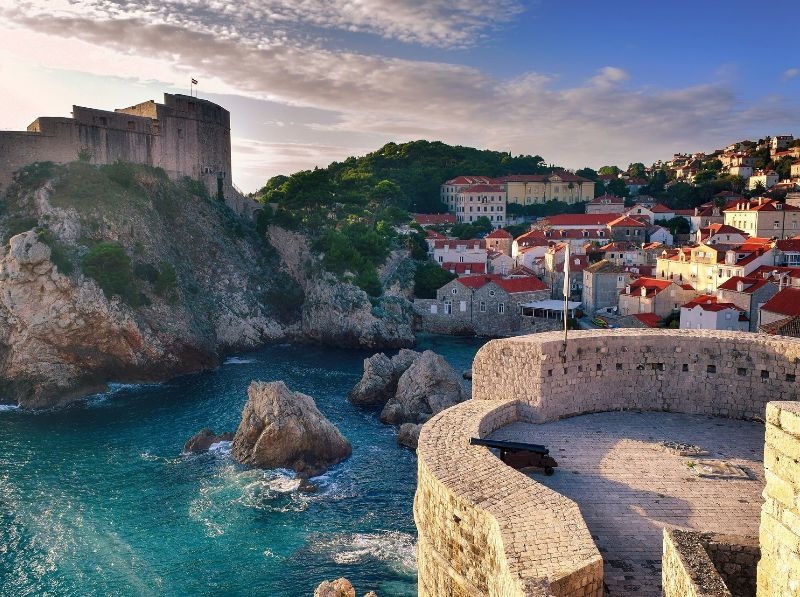
The 20 Best Places to Visit in Croatia
Updated September 6, 2023
Stretching along the Adriatic Sea, Croatia is characterized by striking mountains, warm islands, and lush green nature. It’s a country with a vibrant culture and incredibly rich history, boasting Roman ruins, red-roofed medieval towns, sunny beaches, and amazing seafood. It’s no wonder that Croatia has become an increasingly popular destination for travelers! If you want to experience it for yourself (and you should!), here are the 20 best places to visit in Croatia.
#1: Dubrovnik’s Old Town: A walk back in time

First up is a UNESCO world heritage site that’s absolutely beloved by travelers and locals alike: Old Town Dubrovnik. The walled city of Dubrovnik has been around since the 7th century , and much of its stunning Renaissance, Gothic, and Baroque architecture is still perfectly preserved. It’s so well-preserved, in fact, that Dubrovnik served as one of the main filming locations for Game of Thrones —you can even take a tour of all the important sets while you’re there!
Our advice for seeing old Dubrovnik? Take a cable car for a bird’s eye view of those iconic red roofs and spires.
#2: Pula: A charming town boasting Roman ruins
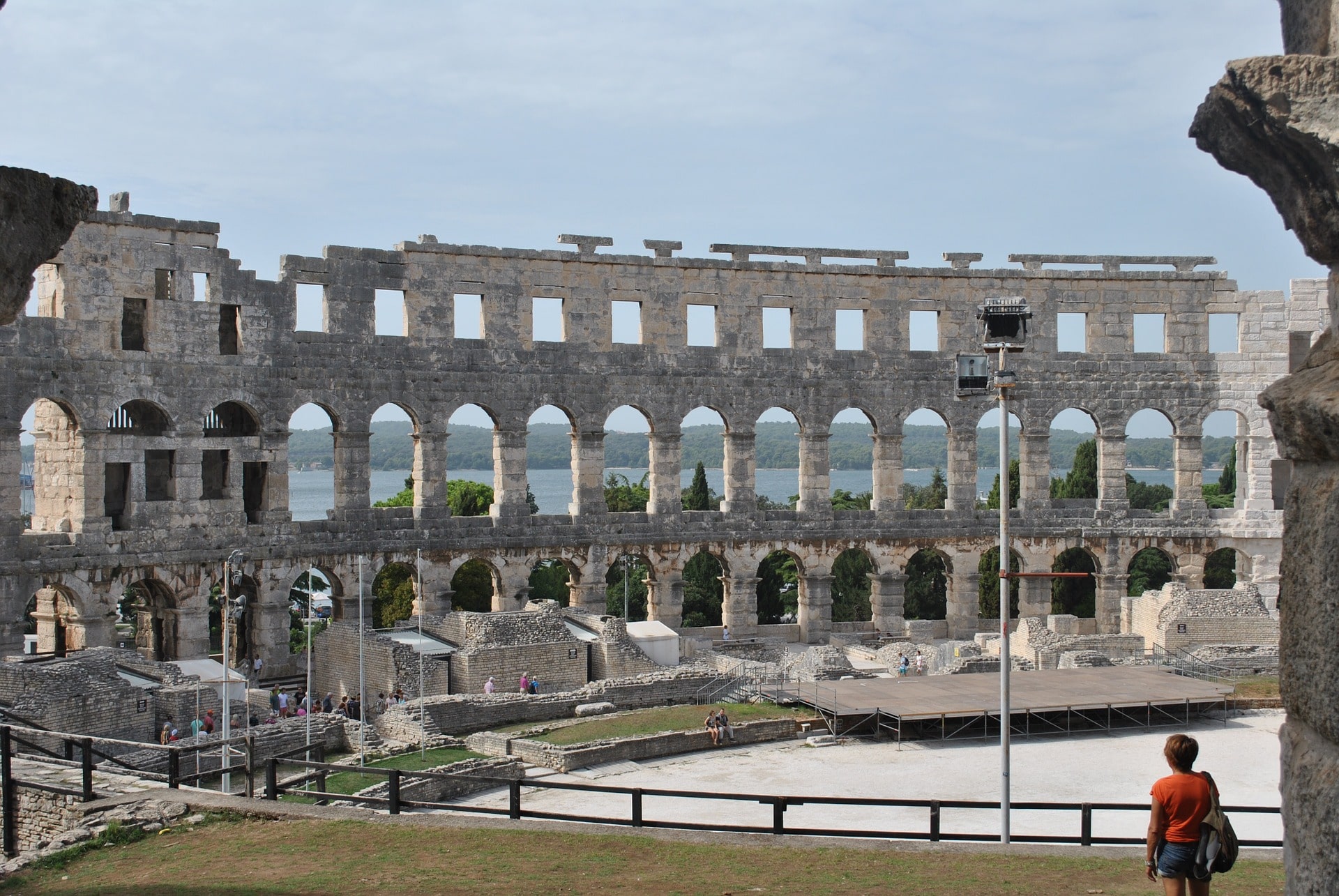
Pula is the capital of Istria, a peninsula in the north of Croatia near the Italian border. It’s a super charming small town full of beautiful beaches and awesome nightlife . One of Pula’s main attractions is its ancient Roman Amphitheater —much of the structure is still standing, making it as impressive as the famous Roman Colosseum—but without all the crowds!
#3: Zagreb: Croatia’s vibrant capital

Croatia’s capital is a small, artsy city in the north of the country. While it’s not home to any beaches, it is home to an amazing art community, a lively bar-and-restaurant scene, and loads of beautiful architecture—from medieval cathedrals to modern marvels, including Croatia’s tallest building. If you’re traveling to Croatia in December, we recommend stopping through Zagreb for one of the world’s best Christmas markets .
#4: Split: An ancient city at the heart of Dalmatia
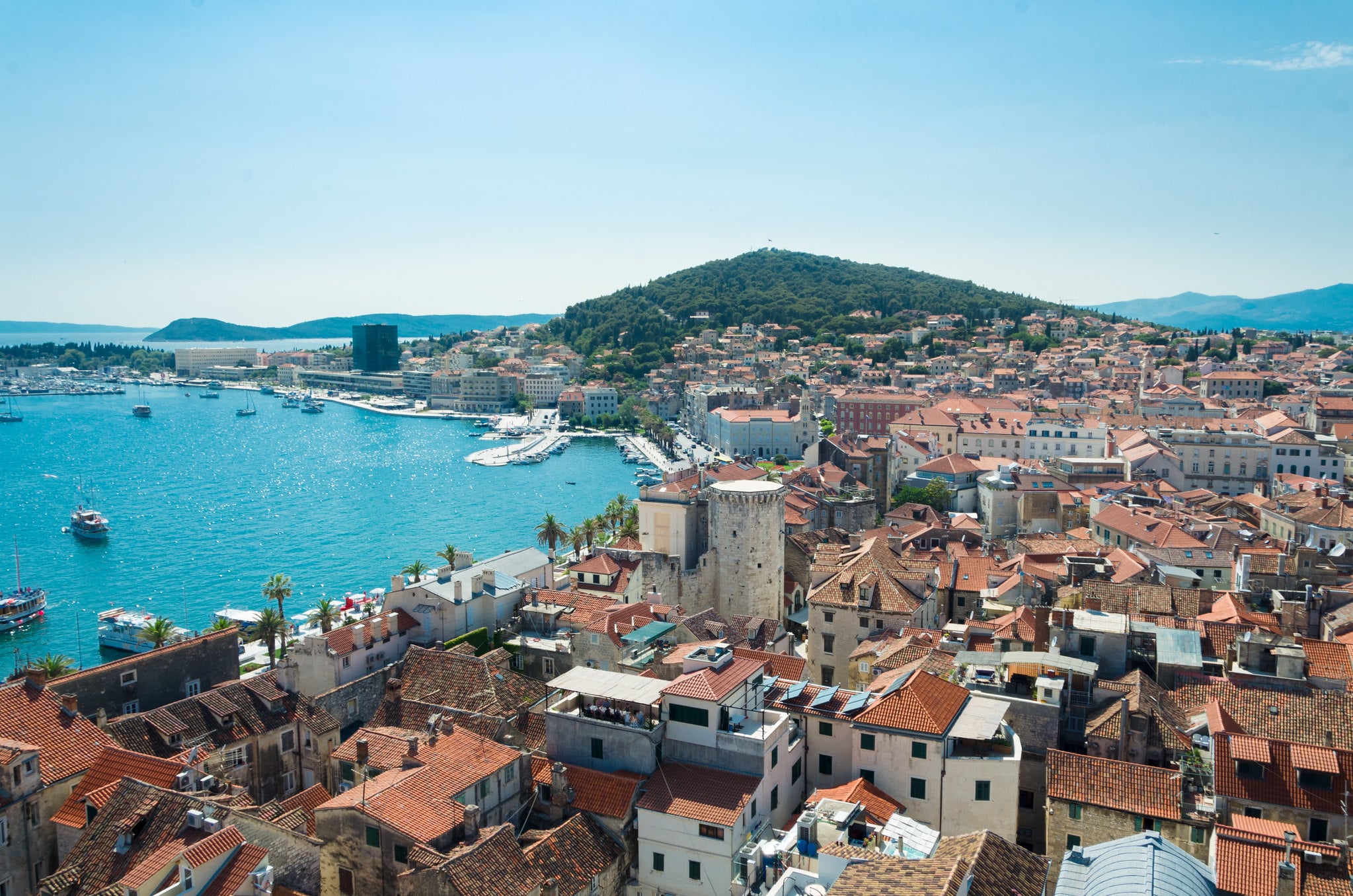
Split, in the southern region of Dalmatia, is Croatia's second-largest city and a super popular destination for travelers. This ancient city was founded as a Greek settlement thousands of years ago and has come under Roman, Byzantine, and Venetian rule over the centuries (among others).
Split is beautiful, with amazing and varied architecture that reflects its rich history, and a sunny, pebbly coastline. Just as in Dubrovnik, you can also find a ton of Game of Thrones filming locations here. Split has been known to host a celebrity or two, so keep your eyes peeled throughout your visit!
#5: Krka National Park: Stunning lakes and lovely waterfalls
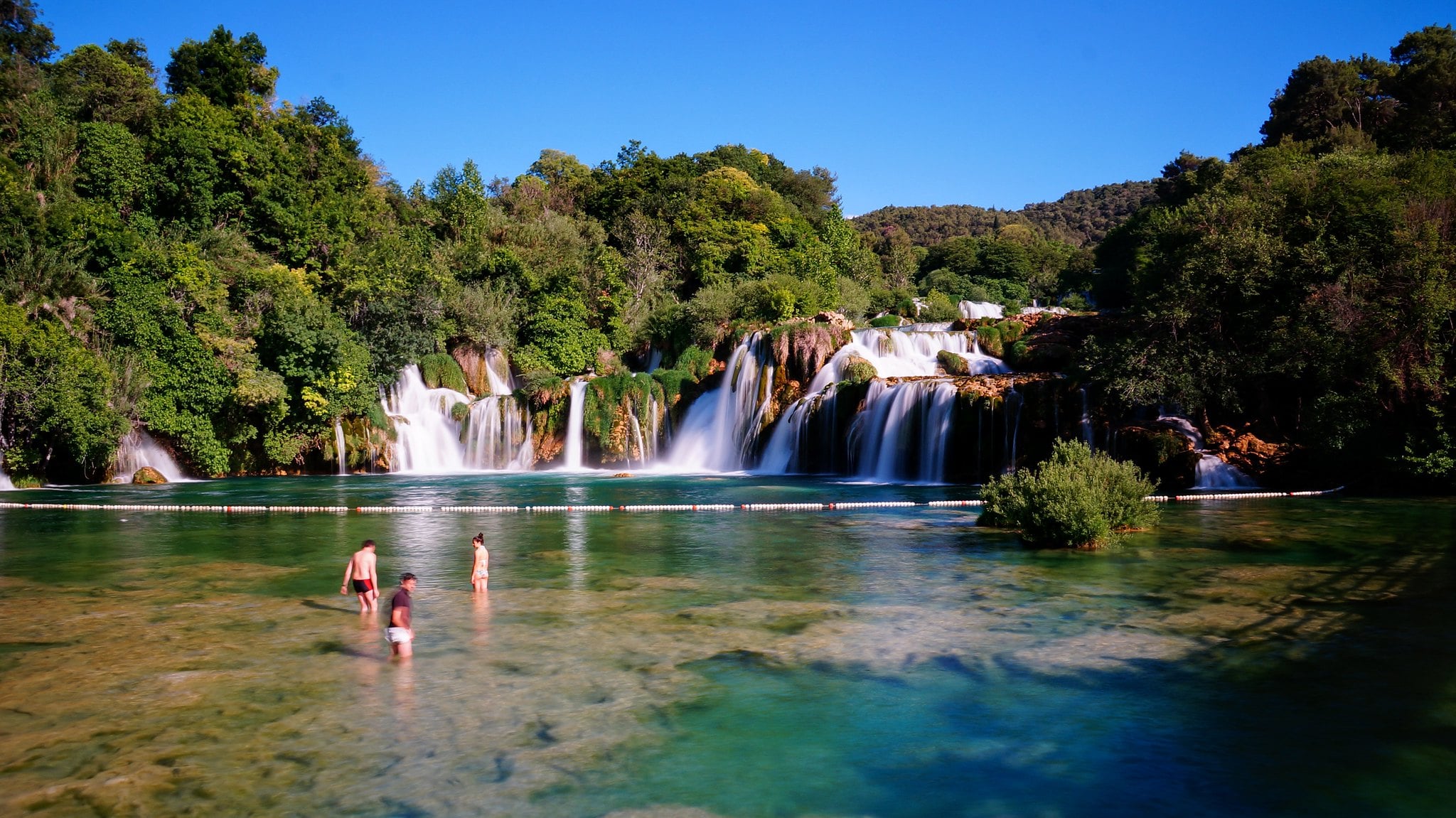
If you’re interested in spending time in some of Croatia’s national parks, Krka definitely has to be high on your list. It’s in the south of the country, not too far from Split (an easy day trip). The park is famous for its series of seven thundering waterfalls and well-preserved natural ecosystems.
You’ll walk through oak and ash forests, flowery grasslands, and green riverbanks—keep an eye out for river otters and tropical birds as you go! It’s a great place for cycling, hiking, or swimming. A walking tour through Krka is also awesome for history buffs, with some striking medieval ruins along the way.
#6: Hvar Island: Beautiful views and amazing parties

Another island off Croatia’s southern Dalmatian coast is Hvar, where you can find an amazing combination of nature and nightlife. Hvar is best known for its rolling purple hills—the lavender fields bloom throughout June and July, with a stunning visual effect. It may be peaceful during the day, but Hvar town is known as Croatia’s town that never sleeps . We definitely recommend stopping by if you want to go out at night and meet other travelers.
#7: Zlatni Rat, Brač: A peninsula of sand and sun

Croatia is known for having some of the best beaches in the world—you definitely have to spend some time in the sun while you’re there! One of the best-loved beaches for travelers is Zlatni Rat, on the island of Brač. The name translates directly to “ Golden Horn ”—and that’s exactly what it is. The beach extends into a sandy peninsula, just outside the charming town of Bol.
#8: The Kornati Islands: Amazing oceanic exploration
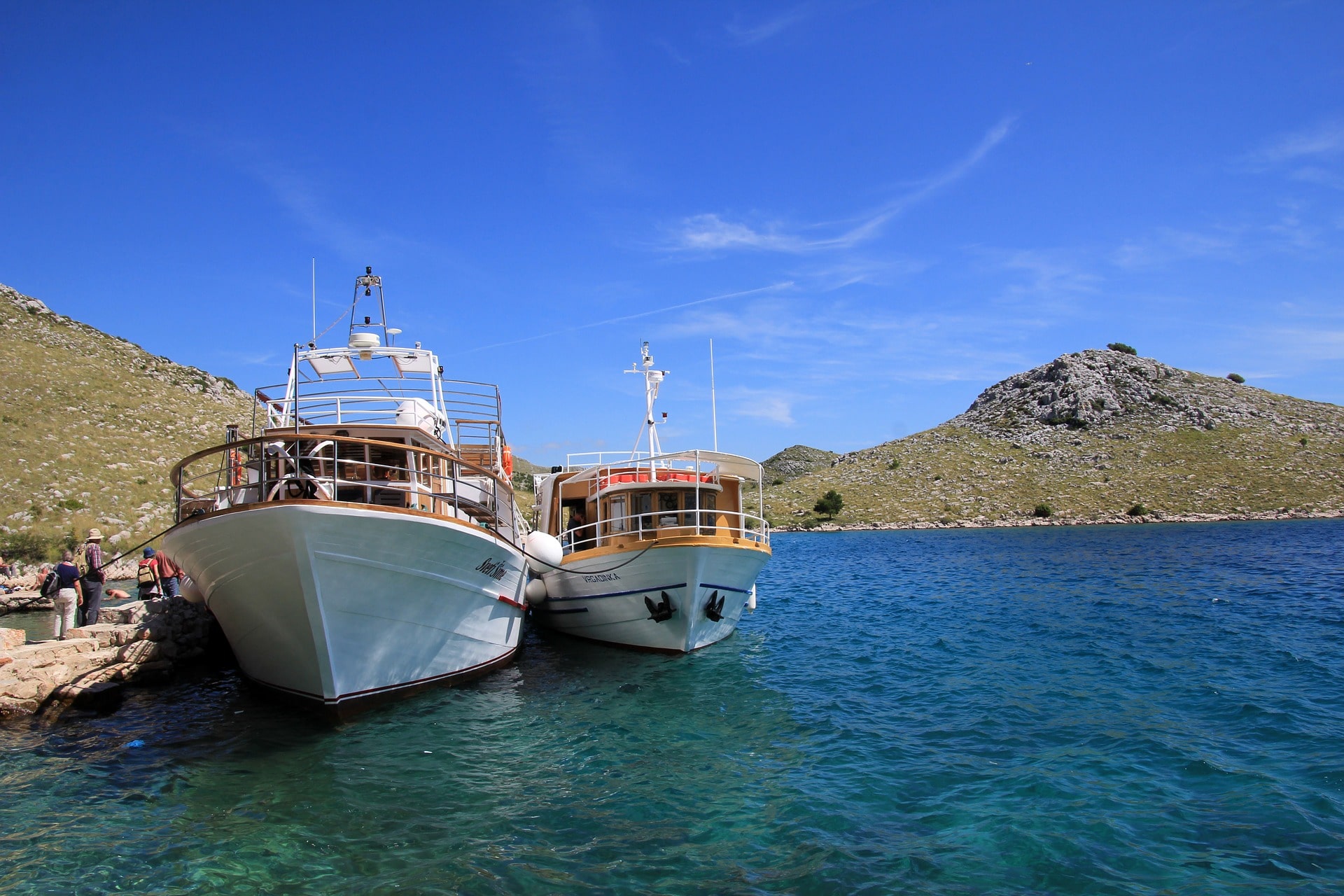
The Kornati archipelago is made up of 140 small islands off the Dalmatian coast. Kornati National Park spans over most of the islands, and the whole chain is mainly uninhabited, with the exception of a few sparse cottages for seasonal agricultural workers. You’ll see tons of rugged cliffs and grottos there—it’s a great place for an adventurous kayaking trip or a day cruise from Split or Zadar.
#9: Plitvice Lakes National Park: Lush green trees and blue lakes
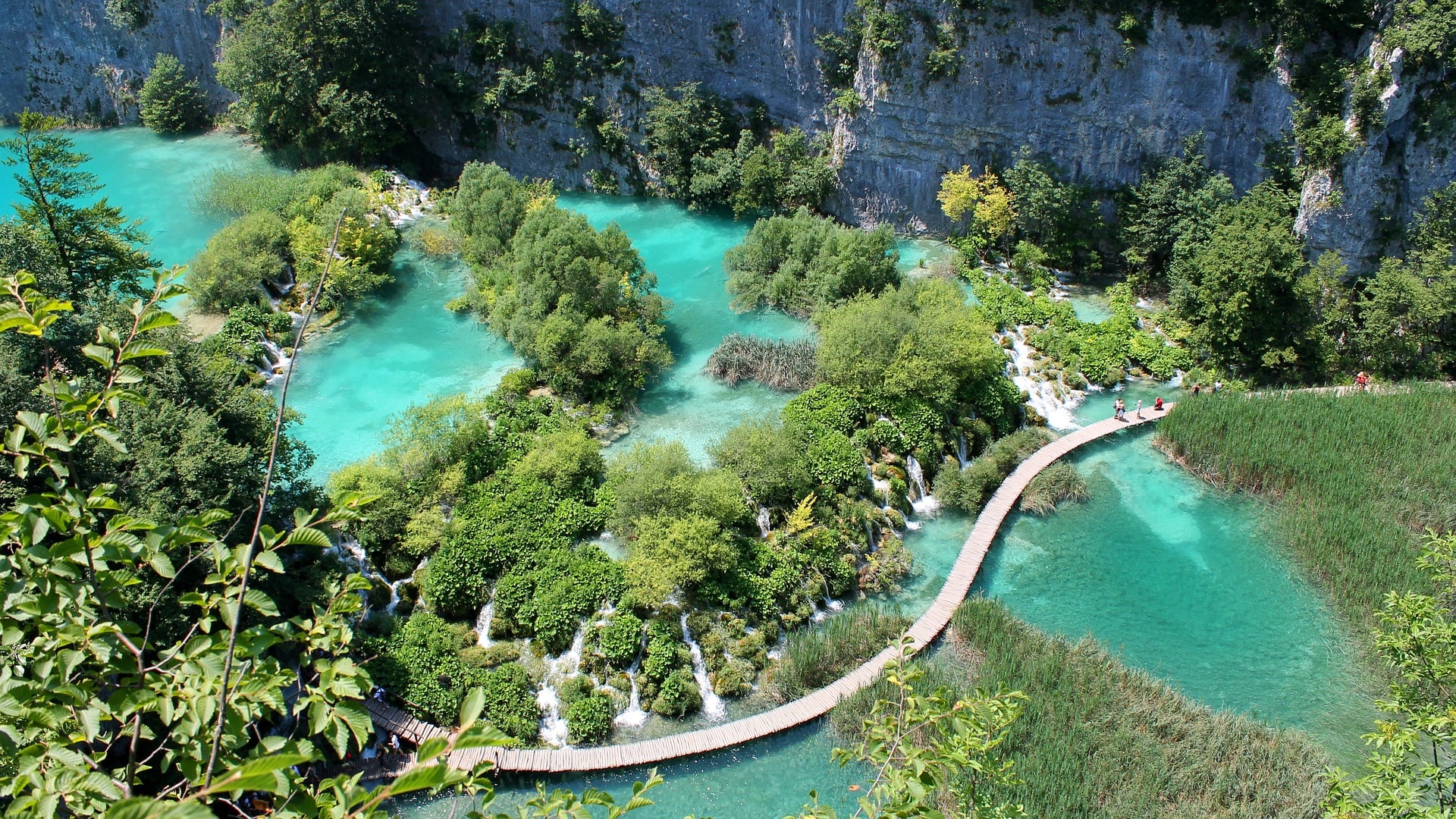
Have you noticed how many national parks are on our list? That’s because Croatia’s natural beauty is unmatched anywhere in the world, and conservationists there work hard to preserve their unspoiled forests and islands. Plitvice is another park travelers love—it’s full of lakes and waterfalls , with clear blue water and diverse wildlife.
#10: The Blue Cave of Biševo: A stunning natural wonder
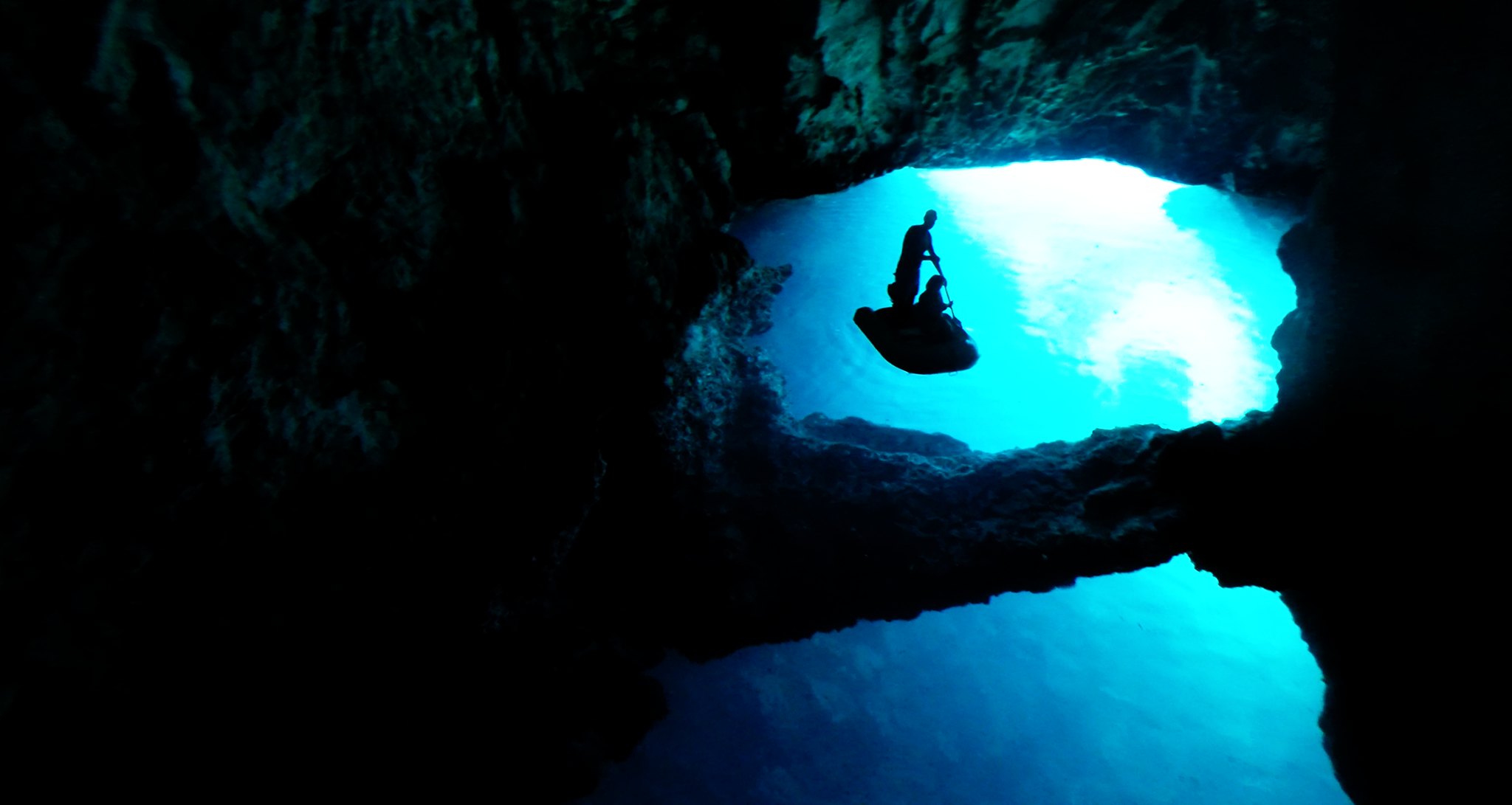
Up for an adventure? The Blue Cave of Biševo isn’t exactly easy to get to, but it is totally worth the journey. It’s off the eastern coast of Vis, another island not far from Split. The water in the cave appears to glow because of the way sunlight reflects off the limestone floor.
#11: Zadar: A beautiful coastline with great food

Located on Croatia’s southern coast, Zadar is a unique European city. You’ll get to see the best of Croatia’s pristine coastline and ancient architecture here, without all the crowds that you might find in Split or Dubrovnik. One of the coolest things about the city is the Sea Organ , a giant stone organ that the ocean “plays” like a harmonica! While you’re there, make sure to try some fresh-caught seafood—Zadar is known for its high-end cuisine, packed with restaurants that put a modern twist on traditional Croatian dishes.
#12: Euphrasian Basilica, Poreč: A 6th-century marvel

Poreč is a small coastal town in the northern part of Croatia. The town itself is super charming, with winding stone alleyways and ancient city walls, but the main attraction for travelers is the Euphrasian Basilica, a UNESCO World Heritage Site . The basilica dates back to the sixth century, around the time Christianity first came to the region. It’s a stunning example of Byzantine architecture and a beautiful place to visit.
#13: Brijuni National Park: A warm island without the rush

We know, we know—another national park? Seriously, this one is just as amazing as the last. Brijuni is a string of islands off the coast of Istria, not far from Pula. There are very few cars on the islands, so it’s an awesome place to see unspoiled natural landscapes without any crowds or noise pollution. Main attractions on the islands include a safari park (where you can see zebras, ostriches, and even an elephant), and an archeological tour of ancient Byzantine ruins.
#14: Mljet Island: For unspoiled nature and Croatian culture
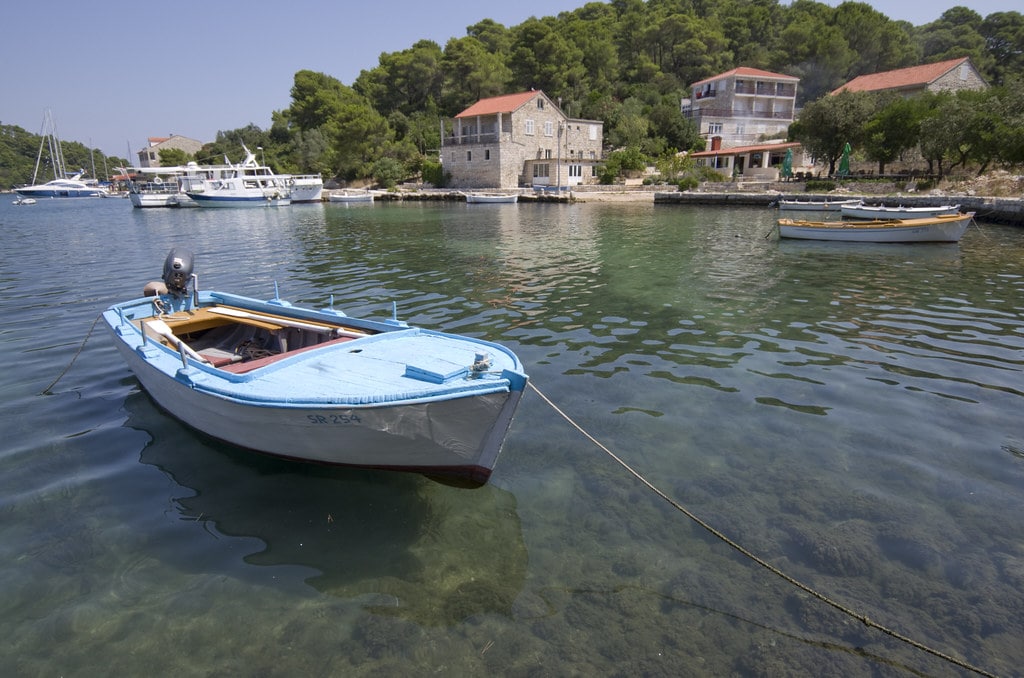
There are a lot of islands off the Croatian coast, but travelers like Mljet best for its green, natural scenery and tropical environment. The northwestern part of the island is covered by a stunning national park , with two huge saltwater lakes and plenty of spots for hiking, swimming, and kayaking. The water is crystal clear, and the weather is balmy year-round!
Mljet is the ideal stop for someone looking to get away from the hustle and bustle of Croatia’s big cities. It’s not a place for partying, but you can experience traditional Croatian culture and cuisine while you’re there—watch local fishermen at work and sample fresh fish, goat, or lamb dishes.
#15: Salona: An ancient Roman capital
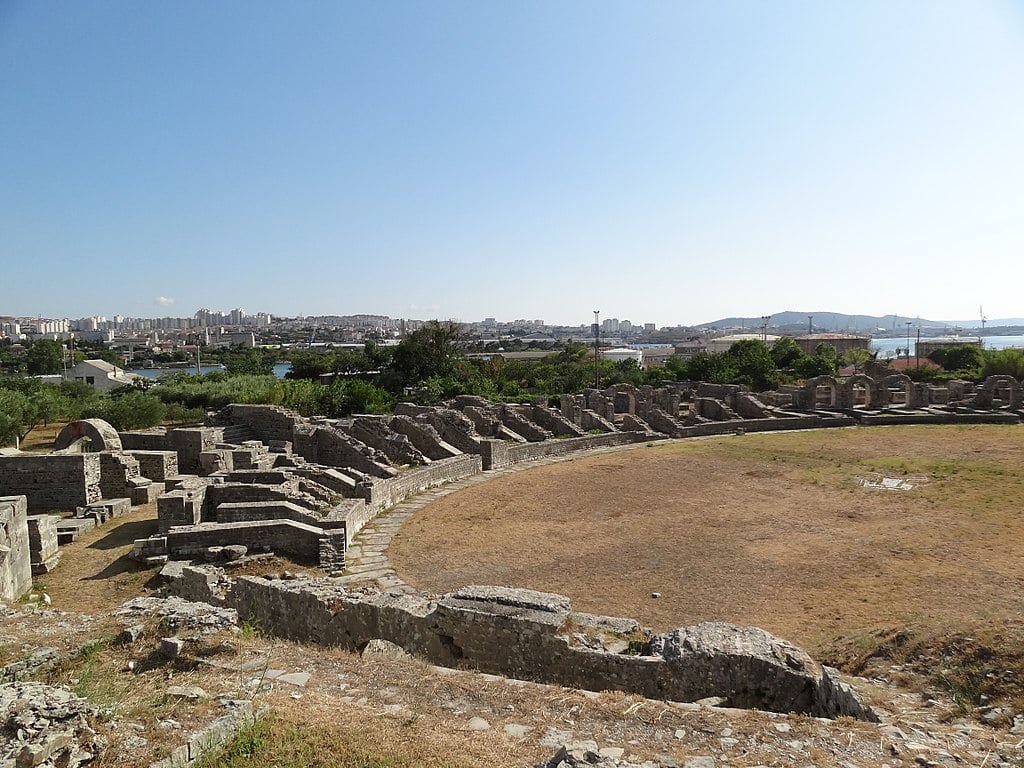
Not too far from Split, you’ll find Salona, another historical city with some really impressive Roman ruins. Salona, or Solin, was the capital of the Roman province of Dalmatia thousands of years ago. You can still see the remains of a grand Roman amphitheater, cemetery, and church there. The ruins are super important to Croatia’s history, so we definitely recommend visiting Salona at least as a day trip from Split or another city.
#16: Stiniva Beach, Vis Island: The best beach in Europe

Vis Island off the Dalmatian coast is a gorgeous natural island, but its main attraction is the pebbly beach that was voted the best beach in Europe back in 2016. High rocky cliffs surround the beach and out into the ocean, creating a stunning natural cove. The water is clear and bright blue, and it’s a great place to relax if you can beat the crowds. While you’re there, be sure to check out some of the old stone fortresses and great Croatian restaurants on Vis.
#17: Korčula Island: Quiet villages and a tropical climate
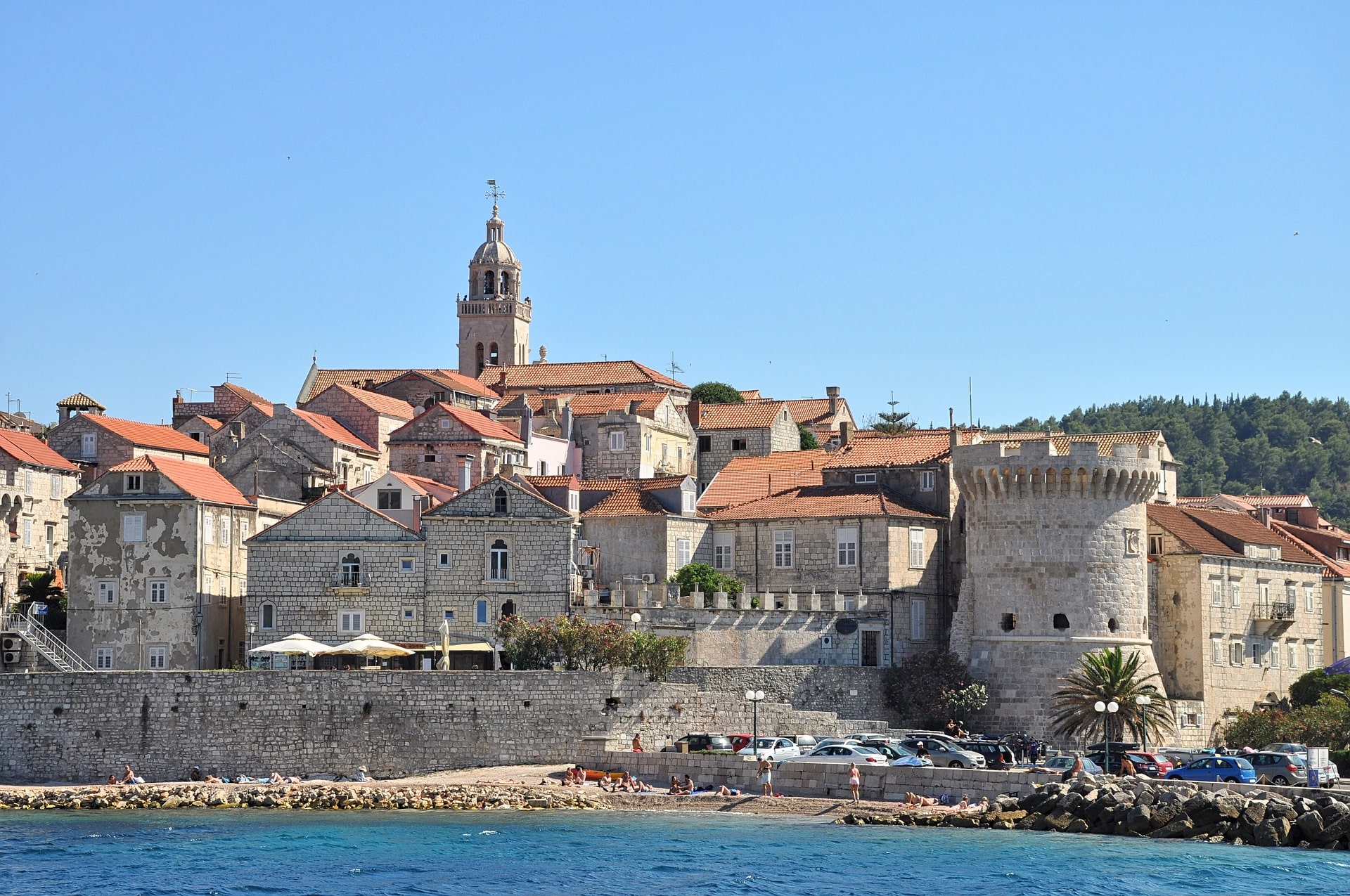
If you love the look of Croatian islands but hate the crowds, Korčula is the place for you. Croatia’s sixth-largest island is a little harder to get to, especially in the off-season, but that means fewer travelers come to visit so you can really experience the island like a local. In the little village of Blato , for example, you can experience the festival of Kumpanija, which celebrates chivalry with ceremonial “fights”.
With a new port , Korčula is only going to gain in popularity—we recommend taking the opportunity to see it now, while it’s still off the beaten path!
#18: Mali Lošinj: A balmy island that’s good for your health

The last island on our list is in the north of Croatia, and only recently became available for travelers to visit. The natural landscape on the island is unspoiled, and a vacation there is even said to improve your health, because the air is so pure. It used to be nearly impossible to get to because there was no airport or main sea lines, but these days you can visit with a quick flight from Zagreb, Split, or Pula.
#19: Trogir: Dalmatia’s "Little Venice"
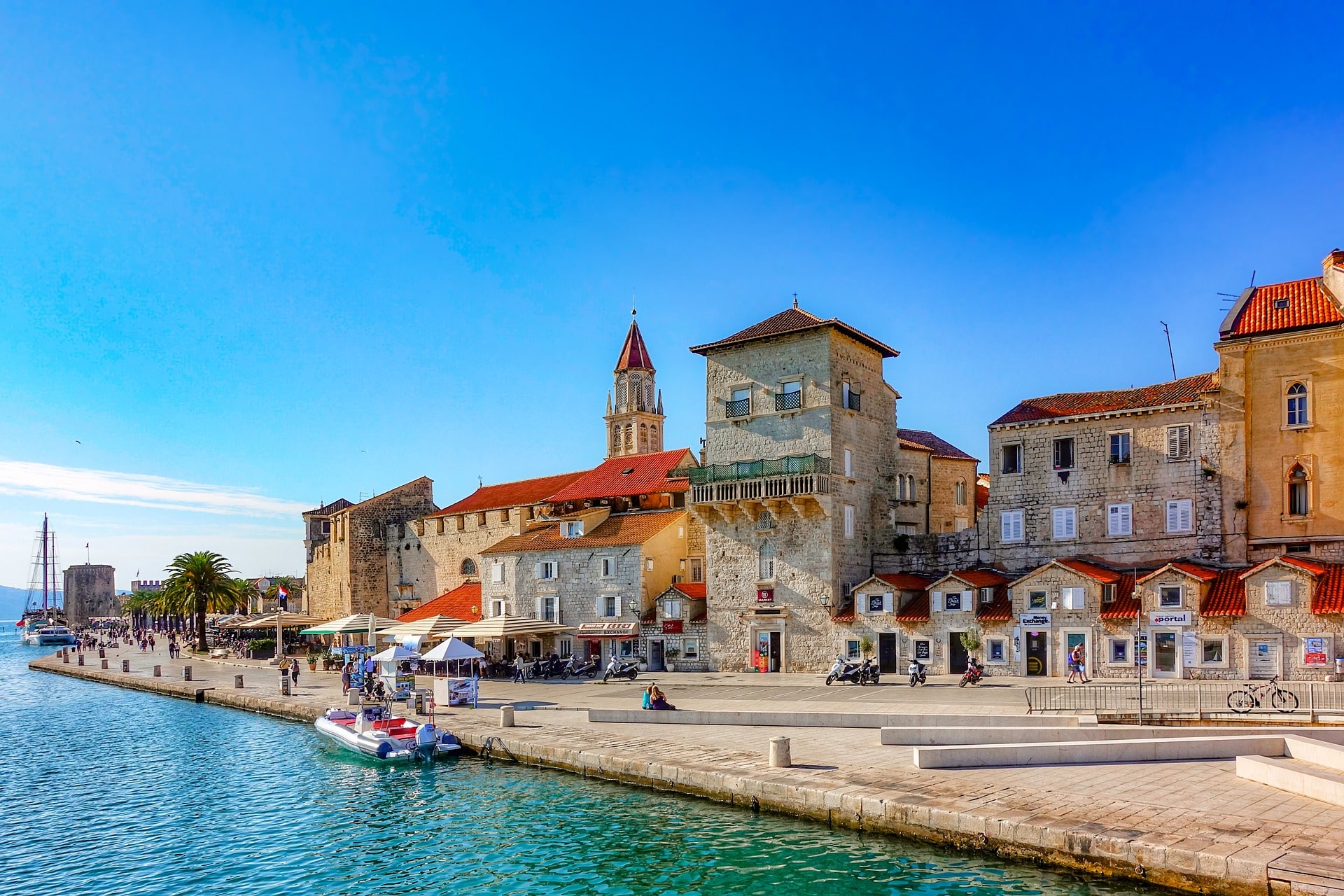
The Dalmatian port town of Trogir is sometimes referred to as the little Venice of Dalmatia for its blue waterways and Renaissance architecture. Its historic old town is a UNESCO World Heritage Site , and has a lot of similar features to Dubrovnik’s old town (red brick roofs, old churches with high spires and a charming main square). While you’re there, be sure to try out some of Croatia’s best cuisine—fish, rich cheeses, and pršut (smoked Dalmatian ham) are abundant. Spot some locations where a variety of shows and movies were filmed, and take a walking tour to absorb some of the city’s rich history .
#20: Rovinj: For a sunny, relaxing family vacation
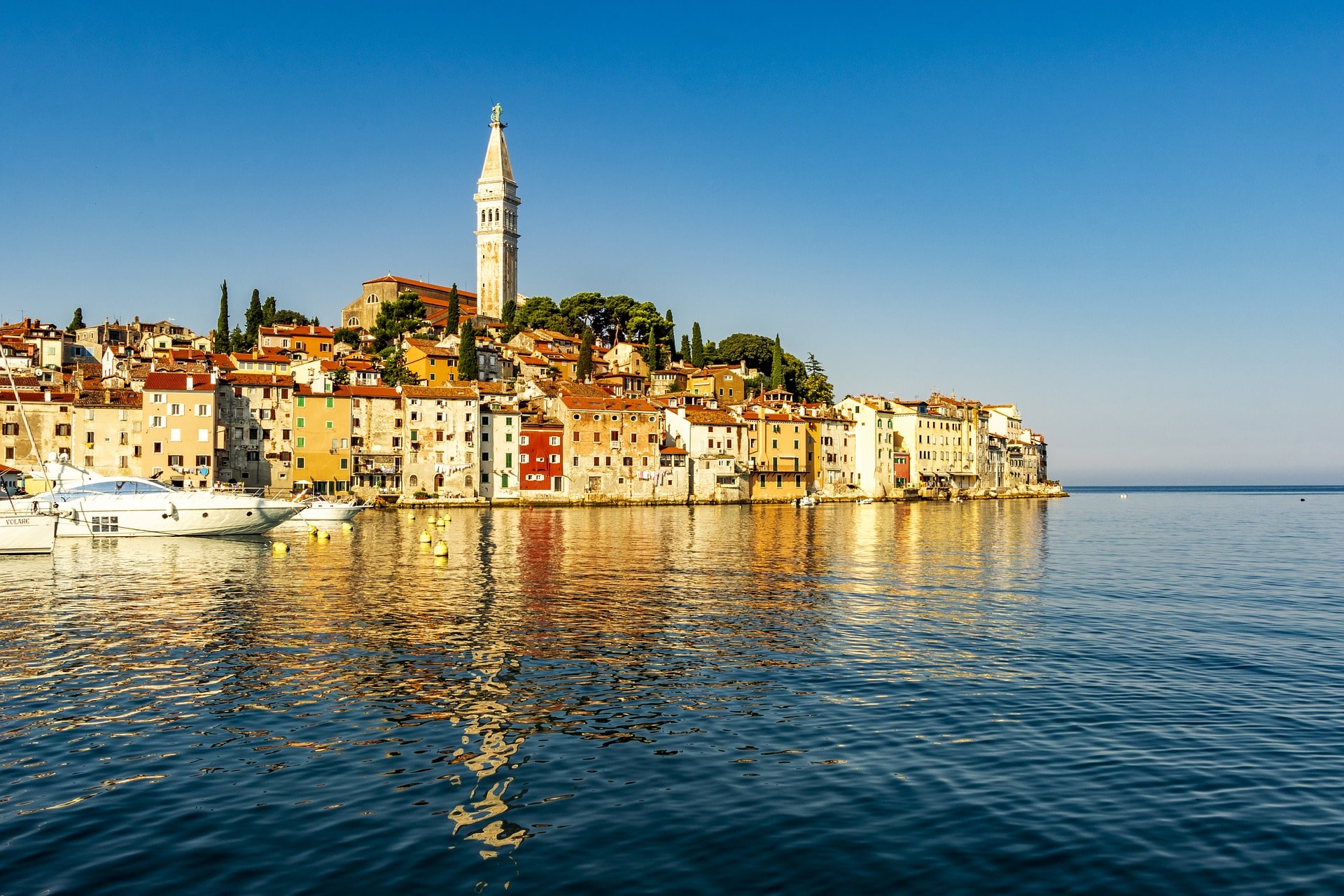
Last but certainly not least on our list is Rovinj, on the Istrian peninsula. This little coastal town has some unique colorful architecture, a historic old town, and a ton of luxury seaside resorts . It’s a great place for exploring with the whole family or just relaxing on the beach—they have some perfect beaches for picnics or sunbathing. If you’re looking for a chill, sunny getaway on your trip to Croatia, Rovinj could be the ideal stop!
Leave a comment:

Select Account Type
Sign-up with
Almost there!
Find booking.
Promotional Title
How should we contact you?
Thank you! We'll get back to you as soon as possible!
Click to register and track your question !
If you would like to follow up with us:
+1 (855) 782-3006
Forgot your password?
Enter your email address below and we'll send you a reset link:
- YouTube Channel
- Travel Resources

How to Spend 1 Day in Zagreb: Itinerary for Croatia’s Capital
by Drifter Planet | Aug 19, 2024 | Croatia , NEW

I have visited Zagreb 4 times because I visit Croatia often for my favorite music festival. Each time I have experienced this city differently. That’s why, I have decided to share the best way you can spend one day in Zagreb.
So is Zagreb worth visiting ? Yes, for one day it is. I have an entire post about it on my website too. Let me
Introducing Zagreb

Zagreb, the capital of Croatia , is an enchanting city brimming with history, culture, and charm. In my opinion, Croatia has a lot of amazing destinations and if you are visiting this country, then I don’t recommend spending more than one day in Zagreb.
The city of Zagreb has a backdrop of the Samobor mountain range that adds an interesting character as you enjoy the views. There isn’t so much to do here and most of the nice spots are in the historic Gornji Grad and around.

From wandering the historic streets of the Upper Town (Gornji Grad) to sampling fresh produce at Dolac Market, this guide will take you through the best things to do, see, and eat in one perfect day.
Although my Zagreb itinerary covers some of the most fun things to do, you can also try out a walking tour if you’d like. Below are some of the tours that I have handpicked for you:
- City Walking Tour with Funicular Ride and WW2 Tunnels .
- Restaurants and Food Walking Tour .
- 2.5-Hour Croatian Homeland War Tour .
Map for one day in Zagreb itinerary
I have made a map for you using Google Maps so that you can directly download it onto your phone and use it while you are in Zagreb.
Keep in mind that reaching the upper town on foot requires a bit of climbing so avoid high heels.
Morning: Explore the Heart of Zagreb

Start your day in Ban Jelačić Square , the city’s main square and the heart of Zagreb. Historic buildings surround this bustling area and it is the perfect place to get your bearings.
From here, you can easily access both the Lower and Upper Towns, making it an ideal starting point for your day in the city center.

Just a short walk from the square, you’ll find the iconic Zagreb Cathedral , one of the city’s most famous landmarks. Known for its striking neo-Gothic towers, it’s the tallest building in Croatia and offers great views of the surrounding area.
Sadly when I visited, Zagreb Cathedral was closed for renovations. But I have read that it has beautiful interiors and dates back to the 13th century.
After visiting the cathedral, head over to Dolac Market , Zagreb’s main outdoor market. Located right by the cathedral, this vibrant market is a great place to experience local culture.
Browse stalls filled with fresh fruit, vegetables, and local delicacies like cottage cheese and fresh meat. Don’t forget to sample some of the local cuisine from the food stalls, where you can grab a quick and delicious bite.
Midday: Wander Through the Upper Town

After fueling up at Dolac Market, make your way to the Upper Town (Gornji Grad) , the historic core of Zagreb. This area is known for its narrow, cobbled streets, colorful facades, and medieval architecture.
Gornji Grad is where I clicked some of my best photos in Zagreb and most likely you will too.

Walk through Kamenita Vrata , a historical stone gate with a shrine of the Virgin Mary. A walk through the streets of Upper Town will transport you back in time to the city’s earlier days.
St. Mark’s Church is one of the best places to visit in the Upper Town . With its distinctive tiled roof featuring the coat of arms of Zagreb and Croatia, this 13th-century church is a must-see.

Close by, you’ll find the Croatian Parliament and the Croatian Museum of Naïve Art , a small museum showcasing works by self-taught artists. These attractions give you a glimpse into the country’s history, culture, and politics.
Next, head to the Lotrščak Tower , a 13th-century fortification that offers panoramic views of the city. Climb to the top for some of the best views of Zagreb, and don’t miss the daily cannon firing from the tower at noon—a tradition that has been going on for centuries.

For a unique and somber experience, explore the Grič Tunnel , an underground tunnel used as a bomb shelter during World War II. Today, it serves as a pedestrian passageway connecting various parts of the city and occasionally hosts events and exhibitions.
Lunch in Konoba Didov san Restaurant

One of the best meals I had in Croatia was at Konoba Didov san Restaurant in Gornji Grad (Upper Town). It is a highly-rated restaurant and had outdoor seating near our apartment, so eating here was a no-brainer.
I ate an octopus salad and my friend ate vegan pasta, both our meals were amazing. I also enjoyed my glass of iced coffee.
Afternoon: Relax in Zagreb’s Green Spaces

You can enjoy Zagreb’s Green Spaces in a few ways. The first is right here in the Upper Town and you can visit Park Opatovina, which has a view of the spire of St. Francis Church. This park also has a mural of “Guliver” from Guliver’s Tales.

Alternatively, you can make your way down to Zrinjevac Park in the Lower Town after exploring the Upper Town. This park is part of the “Green Horseshoe,” a series of interconnected parks and green spaces that form the lungs of Zagreb. It’s a great spot to relax, people-watch, or simply enjoy a leisurely stroll.

If you’re visiting during the warmer months, Zrinjevac Park is also a popular place for outdoor activities and events. The park is especially beautiful in the spring and summer when the flowers are in full bloom.

For something different, consider visiting Mirogoj Cemetery , one of the most beautiful cemeteries in Europe. Designed by architect Hermann Bollé in the late 19th century, the cemetery is known for its grand arcades, lush greenery, and impressive tombstones. It’s a peaceful place to reflect and admire the stunning architecture.
Late Afternoon: Dive into Zagreb’s Quirky Museums or Cafes
No visit to Zagreb is complete without checking out some of its quirky cafes or unusual museums. Considering we had just a day to explore Zagreb, I decided on a fun cafe instead of a museum. (But I will give you options for museums also in case you prefer them over coffee shops).

We were trying to fund the most fun cafe in Zagreb and discovered the Cat Cafe of Zagreb with 16 adorable cats, cat-themed decor, board games, and imaginative drinks (some of them even had edible glitter).
If you are a cat lover then definitely consider visiting Cat Caffe to instantly lift up your spirits.
The Museum of Broken Relationships is perhaps the most famous of these quirky attractions. Located in the Upper Town, this museum features a collection of objects donated by people from around the world, each symbolizing a failed relationship. The exhibits are both heartbreaking and humorous, offering a unique perspective on love and loss.
Another fascinating museum is the Croatian Museum of Naïve Art , which showcases works by Croatian and international naïve artists. This small museum is a great place to discover an art form that is often overlooked but full of charm and creativity.
Early Evening: Sunset Viewpoint in Zagreb

We discovered a lovely sunset viewpoint from our room in Upper Town on our way to Tkalčićeva Street. This spot is where the staircase starts that leads down from the upper town to the city, so is on a height and you can see a nice view.

This spot also has benches where you can sit and enjoy your time. I checked Google Maps and noticed that it was already marked as “view point” by someone else! In order to find it, just click on this link and it will take you to the location on the Google Maps app.
Evening: Experience Zagreb’s Nightlife

As the sun sets, head to Tkalčićeva Street in the Upper Town, a lively area known for its bars, restaurants, and coffee shops. Even on a Monday night, this entire area was buzzing.
Tkalčićeva Street is a pedestrian-friendly street, which isn’t just lively but also super pretty. It is the perfect place to unwind after a day of sightseeing.

We had a nice dinner here and found a cocktail bar with happy hours to enjoy our evening. Almost all the places had outdoor seating extending to the streets.
Whether you want to enjoy a leisurely dinner, sip on a cocktail, or simply people-watch, Tkalčićeva Street offers plenty of options.

If you’re looking for something more upscale, consider dining at the Esplanade Zagreb Hotel , a historic hotel that has hosted numerous celebrities and dignitaries over the years. The hotel’s restaurant offers a sophisticated dining experience with a focus on Croatian and Mediterranean cuisine.
Where to Stay in Zagreb
I have stayed in many different rooms in Zagreb but the experience completely changed based on the location.
Old Town Tale in Gornji Grad

My best experience in Zagreb was when I stayed in a place called Old Town Tale in Gornji Grad or the Upper Town. All the nice spots were within a short walk away.
This part of the city is super pretty and I felt that I made the most of my 24 hours in Zagreb just by staying here.

Old Town Tale isn’t just a room but an apartment with a kitchenette so that you can make your own meals. To be honest, we didn’t use the kitchen at all here except for tea or coffee because the food in Zagreb was so nice and affordable.
Hotel Orient Express

Orient Express is a conveniently located hotel where I stayed with my toddler and husband for a night. It is close to the train station, and the bus station and has a decent parking space.
Hotel Europa

Hotel Europa is also a mid-budget hotel in Zagreb with a shopping mall nearby where we went for lunch. For our little family of three, it was perfect because our room was spacious and had two beds – one double and a single.
Additional Tips for Your One Day in Zagreb

Public Transport
Zagreb has an efficient public transport system, including trams and buses, which makes getting around the city easy. If you’re planning to visit several attractions, consider getting a day pass for unlimited travel on public transport.
App-Based Taxi in Zagreb
Yes, I did say that Zagreb’s public transport is super effective but we ended up taking Bolt cabs all the time. They were affordable and easy.
In my experience, Bolt is cheaper than Uber in Europe. In my opinion, it makes more sense to use Bolt Cabs if you are traveling with another person or in a group so that the fare can be split.
Day Trips from Zagreb

Let’s be honest, no one actually visits Croatia to just see Zagreb because there’s so much this lovely country offers. So the best thing you can do is to get out.
Zagreb is a great base for day trips to nearby destinations. Plitvice Lakes , Krka National Park , Rastoke , and coastal towns like Pula or Dubrovnik are popular options for those looking to explore beyond the city.
I have shortlisted some amazing day trips for you that you can book:
- Plitvice & Rastoke Guided Day Trip with Ticket : I have visited both Plitvice and Rastoke twice and they are the most stunning places that I have seen in Croatia. Book this 10-hour day tour to see these wonderlands from Zagreb.
- Ljubljana and Lake Bled Day Trip by Minivan : It is possible to see the nearby country of Slovenia while you are in Zagreb. This day trip tour will take you to Slovenia’s capital Ljubljana with a tour guide, and drive to Lake Bled surrounded by spectacular Julian Alps.
Best Time to Visit

The best time to visit Zagreb is during the warmer months, from late spring to early autumn. The city comes alive with outdoor activities, and the weather is perfect for exploring. The Christmas Market is another highlight, transforming the city into a winter wonderland.
Conclusion: Make the Most of Your One Day in Zagreb

Although one day may not seem like enough time to experience everything Zagreb has to offer, this itinerary covers the city’s main attractions and some hidden gems. From the historic streets of the Upper Town to the bustling markets of the Lower Town, Zagreb is a city that’s worth visiting, even if you’re short on time.
Whether you’re interested in history, and culture, or just want to enjoy great views and local cuisine, Zagreb offers a full day of unforgettable experiences in the heart of Central Europe.
This day trip itinerary will leave you with a deeper appreciation for the Croatian capital, and perhaps inspire you to return for a longer visit!
Related Posts:
![30 Amsterdam Travel Tips that are Ridiculously Helpful [Tried and Tested] Amsterdam travel tips - things you need to know before traveling to Amsterdam](https://drifterplanet.com/wp-content/uploads/2017/07/Amsterdam-travel-tips-things-you-need-to-know-before-traveling-to-Amsterdam-150x150.jpg)
Submit a Comment Cancel reply
Your email address will not be published. Required fields are marked *
Hello Travelers!

Namaste, Guten Tag! I'm Sonal from India, living in Germany and exploring Europe. I've been writing about my travels since 2015. I often travel alone (and sometimes with family of 3).
I love European city breaks, nature, adventure, hiking to viewpoints, Yoga, and road trips. I have a knack for creating the most amazing travel itineraries and in-depth destination guides which will help you make the most of your trip.
Not sure where to start? Start with some of my most popular posts .
Pin It on Pinterest
Last Updated on August 19, 2024 by Drifter Planet
7 Places That Might Not Exist In 10 Years

Your changes have been saved
Email is sent
Email has already been sent
Please verify your email address.
You’ve reached your account maximum for followed topics.
- Explore iconic destinations like the Twelve Apostles and Glacier National Park before they disappear forever.
- Rising sea levels threaten Kiribati, while illegal activity endangers Papakolea Beach.
- Moldova may soon unify with Romania, changing the country's identity and landscape forever.
Various types of destinations attract travelers. From mountain climbing trips around the world to traveling to the world's friendliest countries , there are many choices for every kind of globe trotter. International tourism ended in 2023 with an estimated 1.3 billion arrivals , and this number will only increase by the end of 2024.
However, the travel ecosystem is poised to undergo significant changes as the world looks ahead. While some destinations will continue to thrive, others might become inaccessible for various reasons or, in some cases, even disappear.
For instance, on August 9th, 2024, the Toilet Bowl, one of Utah's most famous arches, collapsed . No one will ever be able to revisit it. Like this iconic arch, these are some of the places that might not exist in the next decade, so there is limited time left to explore them.
7 Best Dark Tourism Destinations To Visit In America
These historical sites are the spots of terrible tragedies, horrific crimes, or otherwise eerie events - and they're all open to the public.
7 The Twelve Apostles, Australia
One collapsed in 2005, and an offshore gas extraction plant nearby puts those remaining at risk of crumbling at any time.
A collection of natural limestone stacks off the shore of Port Campbell National Park in Victoria, Australia, the Twelve Apostles are said to have formed by erosion around 15 to 5 million years ago.
In July 2005, one collapsed into the sea, leaving eight still standing. The original Twelve Apostles never included twelve stacks. There were nine, and eight are still standing. More stacks exist west of the national park but are not considered part of the Apostles' group.
The gas extraction plant, intended for home use in Victoria, has been approved for the first time in a decade. Due to the continuation of the stack's erosion, eventually, the coastal shore will disappear. The question is not if, but when !
6 Papakolea Beach, Big Island, Hawaii
The stunning green sand beach is at risk of disappearing or becoming inaccessible due to illegal tourist activity.
Also known as Mahana Beach, this is one of only four green sand beaches worldwide. Located near South Point, on the island of Hawaiʻi, Papakolea Beach formed in a bay over 49,000 years ago, circled by volcanic ash.
It is only legally accessible on foot, with attempts to restrict vehicular traffic. However, illegal tourists' shuttling through the exceptionally fragile ecosystem has created ruts in the soil that reach eight feet deep. Authorities may restrict any further access to the gorgeous beach at any point.
Furthermore, scientists have predicted that coastal erosion in Hawaii will reach 20 feet in the next 35 years, meaning that waves may completely swallow beaches like Papakolea. However, a tsunami can cover the beach at any time, making it inaccessible.
5 Moldova, Europe
Polls supporting the unification of moldova and romania rose from 20% to 44% from 2015 to 2022.
A beautiful landlocked country in Eastern Europe, with a population of approximately 2.42 million, Moldova borders Romania to the west. The unification of Moldova and Romania is a popular concept, furthered by the Romanian Revolution in 1989 and Moldova's independence in 1991.
With most of its population being ethnically Romanian, and given the country's poor economic state, this could quickly happen anytime, especially with recent growth in the number of those in favor of joining Romania. If it does take place, the land of Moldova will remain, but the country and many things it stands for might cease to exist.
Between 1991 and 2009, about 140,000 Moldovan citizens obtained Romanian citizenship, while one million requested it. Moldova was once considered the world's unhappiest place , but an effort has been made to change that image.
7 Airports Around The World That Are Now Abandoned (& Why)
Many of these abandoned airports have seen their darkest days that are now frozen in time.
4 Kiribati, Oceania
Rising sea levels could submerge the country, which is less than six feet above sea level.
The Republic of Kiribati, a group of 33 very low-lying Pacific Islands in the central Pacific between Hawaii and Australia, is home to 120,000 people. A typical tropical postcard paradise, Kiribati is at risk from rising sea levels.
Global warming is melting the polar ice caps, glaciers, and ice sheets, causing sea levels to rise. It is estimated sea levels have risen an average of 0.01 feet per year since 1993. This phenomenon is proving to be catastrophic for many coastal regions, especially places like Kiribati.
The government spends a lot of time alerting the world to Kiribati's plight and seeking solutions to the imminent catastrophe. Scientists believe that these islands may become uninhabitable soon. It has also bought land in Fiji to evacuate the country's entire population if the worst happens. At less than six feet above sea level, a single tsunami can wipe it off the map.
3 Blockbuster Store, Bend, Oregon, USA
The brand's last remaining retail store in the world, after operating 9,094 stores in 2004.
Formerly called Blockbuster Video, Blockbuster was a public store chain in the 1990s that offered video and game rentals. At its peak in 2004, Blockbuster employed 84,300 people worldwide and operated 9,094 stores.
Following the great recession in the late 2000s and growing competition from Netflix's mail-order service and video-on-demand, the company filed for bankruptcy protection in 2010.
After being acquired by satellite television provider Dish Network and following a series of closures in 2019, only one franchised store remains open: in Bend, Oregon. Since becoming the last Blockbuster, it has become a popular tourist destination. The iconic brand store's future remains uncertain, but it is unlikely to survive another decade in its current avatar and business model.
2 Dead Sea, Jordan & Israel
A third of its surface area has evaporated at four feet per year, with less freshwater inflow, making it about 15% shallower.
The Dead Sea is a landlocked salt lake bordered by Jordan to the east and Israel to the west. At 1,412 feet below sea level, it is the lowest land-based elevation on Earth, is one of the world's saltiest bodies of water and lies in a hot desert climate.
Regrettably, the Dead Sea has been drying up for decades due to climate change and the overexploitation of natural resources. The diversion of 80% of water from the Jordan River, its most significant source of fresh water, for agricultural and industrial purposes has also contributed to this process.
The lake has attracted visitors from around the Mediterranean Basin for thousands of years. Whether it will happen in the next decade cannot be confirmed, but the swift rate at which the lake is drying and receding is a matter of grave concern.
6 Places You Might Not Be Able To Visit A Year From Now
Visit these beautiful locations around the world before they are gone forever or close for an extended period of time. Plan soon!
1 Glacier National Park, Montana
The number of glaciers in the park has reduced from 150 to 25, shrinking the total glacial mass by 85% since 1956.
Glacier National Park in Montana is a paradise for adventurous tourists, a spectacle of melting glaciers, alpine meadows, and pristine lakes. However, at the current accelerated rate of global warming, scientists predict glaciers will disappear from the park by 2030.
Of the estimated 150 glaciers, over 25 acres in size, that existed in the park, only 25 active glaciers remained by 2010 . Scientists studying the glaciers have estimated that all active glaciers may disappear by 2030 if current climate patterns persist.
Scenic yet highly underrated spots in Montana could be alternatives to Glacier National Park if and when the iconic US National Park's glaciers melt. The park has consistently had at least two million annual visitors since 2012, and it would be a sad day if and when it no longer exists.
How to avoid the worst of jet lag and maximize your travel time
Jet lag is a problem for many travelers but there are some easy ways to adjust your body clock
LONDON -- It's the bane of many travelers: jet lag. Nobody wants to lose out because they're too tired to enjoy the delights of their vacation spot.
Here are some tips on how to handle jet lag, wherever you might end up.
Scientists define jet lag as the effect on the human body of traveling across different time zones. Our bodies have biological clocks programmed into almost every cell in the body, according to Sofia Axelrod, who studies circadian rhythms at Rockefeller University in New York.
“The clock is set by the 24-hour light and dark pattern,” Axelrod said. “Every morning when we wake up, specialized (light) receptor cells in our retina receive a daylight signal, which is transmitted to the brain and from there, the whole body.”
When we travel to another time zone, our eyes receive the daylight signal at a different time than usual, causing our internal clocks to reset. But that process can take awhile — and it’s during that adjustment period that we feel the effects of jet lag.
Yes, but that can come at a cost. Malcolm von Schantz, a professor who specializes in circadian rhythms at Northumbria University in Newcastle, said that flying in premium cabins where travelers can stretch out and properly rest, can ward off sleep deprivation, but he acknowledges that isn't an option for most people. Still, he said that timing your flights can help. For example, he suggests flying from Europe to North America during the day, so that it’s evening when passengers land and they can get a proper night’s sleep.
“If you take the evening flight instead, you’ll be woken up at midnight to be served breakfast and land an hour or two later, when both jet lag and sleep deprivation will hit you hard and simultaneously,” he said.
Von Schantz also said flying in newer models with a lighter frame, like the Airbus A350 or Boeing 787 Dreamliner, would help. That’s because those planes can maintain a more comfortable cabin atmosphere, which should help travelers feel less worn out by the end of their flights.
Experts say getting exposure to sunlight is critical to resetting your internal body clock. That can mean either avoiding morning sun or deliberately seeking it out, depending on where you’ve travelled from. Getting light in the morning will advance your body clock, while light exposure in the early evening will delay it. Naps are OK, but scientists warn against taking long siestas later in the day, as that might compromise your ability to sleep through the night.
Melatonin, a hormone that the brain naturally produces when the body thinks it’s night, can be helpful. But it’s not available everywhere and in some countries like the U.K. and France, a prescription is required. Von Schantz of Northumbria University said that one of the advantages of melatonin is that you can start taking it before your journey, to reset your internal clock quicker.
“If you’re in a part of the world where melatonin is available over the counter, you can combine the effects of light and melatonin to achieve the advance or delay (in your body clock) that you need,” he said.
Business travelers might want to consider arriving a day or two ahead of any important meetings or events, said Russell Foster of Oxford University, who has authored a book on circadian rhythms.
“You should just be aware that if you’re jet-lagged, you’re more likely to make unwise decisions, be less empathetic and unable to multitask,” he said.
Tourists might not need to be as alert as business travelers, but they should still be careful, he said. He advises tourists to get caught up on their sleep before doing anything potentially risky or that requires concentration, like driving.
Foster said he tries to maximize his light exposure when he arrives at a new destination to offset jet lag. But he also has a fallback strategy: coffee.
“I’m not suggesting it’s an ideal thing to do, but caffeine will help override the sleepiness and cognitive impairment you might be feeling as a result of jet lag,” he said.
The Associated Press Health and Science Department receives support from the Howard Hughes Medical Institute’s Science and Educational Media Group. The AP is solely responsible for all content.
Trending Reader Picks

4 children found shot in stolen car
- Aug 19, 12:52 PM

Phil Donahue, former TV talk show host, dead at 88
- Aug 19, 5:55 PM

Drone attack launched on Moscow: Officials
- Aug 20, 10:20 PM

Man goes missing while on vacation
- Aug 20, 5:18 PM

Airport conveyor belt cause of death revealed
- Aug 9, 8:42 PM
ABC News Live
24/7 coverage of breaking news and live events
The Best Anti-Theft Bags To Carry While Traveling, According To Reviewers
Shopping Writer at HuffPost

In addition to your luggage and garment bags , you should consider investing in an anti-theft bag to tote on your next trip .
With the help of special security features such as lockable zippers, anti-slash fabrics, hidden pockets and RFID-blocking technology, these bags can help protect your most valuable belongings, such as your wallet , tablet and laptop .
And depending on their size, they can even be used as your personal item or carry-on bag . Below, you’ll find the eight best anti-theft bags, according to reviewers who use them while traveling.
HuffPost and its publishing partners may receive a commission from some purchases made via links on this page. Every item is independently curated by the HuffPost Shopping team. Prices and availability are subject to change.

From Our Partner
Huffpost shopping’s best finds, more in shopping.

IMAGES
COMMENTS
Choosing the best time to go to Croatia depends on what you want from your visit. High season brings high temperatures and a party vibe, particularly on the Dalmatian Coast, home to highlights like walled Dubrovnik, its hip cousin Split, and Hvar Town 's classy waterfront. Shoulder season is quieter, and great for hiking and watersports, while winter lets you experience culture and festivals ...
The best time to visit Croatia is during the shoulder seasons from late April to mid-June and September to October, with June offering perfect weather and fewer crowds. This period allows for pleasant swimming conditions and less congestion at popular spots, avoiding the peak season's overwhelming tourist influx in July and August.
Here's When to Visit Croatia (And When to Avoid!) The best time to visit Croatia is in May, June, September, or October. These are the months when all the tour operators and hotels are open, the weather is warm and pleasant, and the crowds are manageable. I visited Croatia over the entire month of June and found it the perfect time to travel.
June is the best time to visit Croatia if you're set on a summer holiday. The summer crowds haven't peaked, but the ferries are fully operating, and the weather is hot and dry. Still be sure to book everything in advance to avoid disappointment. July is the height of the event and festival season in Croatia.
So, I did my research and discovered that the best time to visit Croatia can depend on a few different factors, like weather, crowds, and events.
Learn the best time to visit Croatia, with details on weather, seasons, climate, crowds, and events. Find out when to book your flights and accommodations for the best deals.
December brings festive cheer to Croatia, with twinkling lights and decorations adorning the cities and towns. Average highs range from 9°C to 13°C, with the sea temperature cooling to around 14°C. December is a magical time to visit Croatia, with Christmas markets, concerts, and events celebrating the holiday spirit.
The best time to visit Croatia depends on where you're going and what you're hoping to see. Discover the best time of year for travelling to Croatia and start planning your trip with our complete guide.
Discover the best time to visit Croatia! Information on seasons, weather, cost, crowds and events to help you decide when to go to Croatia.
Discover the ideal time to visit Croatia based on climate, peak tourist season, shoulder season, off-season, beaches, outdoor activities, festivals, sightseeing, and budget travel. Plan your perfect trip!
When is the best time to visit Croatia? Find out all you need to know about the weather, crowds and more at different times of year.
Plan the perfect trip to Croatia with these insider tips on health, safety and etiquette.
Find out the best time to visit Croatia with details on climate, seasons and events from Audley specialists.
What's the best time to visit Croatia? Most people travel to Croatia in the summer months, but here are the best months to visit Croatia and more.
When is the Best Time to Visit Croatia? Croatia has quickly become one of the top destinations for travelers in the world, thanks in part to the hit show "Game of Thrones," which used a number of its enticing spots as filming locations. It's filled with everything from ancient fortified cities to island gems with beautiful beaches, wineries and vineyards for tasting tours, countless ...
The best time to visit Croatia is in the summer (June to September) when the weather is hot and sunny, the glittering coast is at its best and the festival season is in full swing. That being said, figuring out when to visit ultimately depends on what kind of holiday you want. Croatia's climate varies from continental to Mediterranean and there ...
Visit Croatia's advice on when to go to Croatia, taking in the best weather, transport connections, and visitor numbers during the year!
The best time of year to visit Croatia weather-wise is July and August, for the gloriously long sunny days that are particularly idyllic on the coast and islands. But the country has a fairly mild climate all year-round, and we think that it is particularly worthwhile to visit Croatia in May, June or September, when temperatures are pleasant ...
Croatia: best time to visit by month Croatia experiences four distinct seasons, but it can be challenging to determine the weather since it varies depending on your proximity to the coast. We recommend packing seasonally and accounting for at least a 10-degree variation between the warmer shores and cooler inland regions.
In Croatia, every season has its charm but there are some things you should be aware of. Read here to know which is the best time to visit Croatia!
The Perfect 10-Day Croatia Itinerary. Our Croatia itinerary takes you from Zagreb to Dubrovnik (or vice versa) through some of Croatia's most popular sights, beaches and islands. This is why we suggest at least 10 days in Croatia to experience the best it has to offer.
This is the best and only guide that you need to know when is the best time to visit Croatia - written by locals who live in Croatia.
Updated September 6, 2023Stretching along the Adriatic Sea, Croatia is characterized by striking mountains, warm islands, and lush green nature. It's a country with a vibrant culture and incredibly rich history, boasting Roman ruins, red-roofed medieval towns, sunny beaches, and amazing seafood. It's no wonder that Croatia has become an increasingly popular destination for travelers! If ...
A walk through the streets of Upper Town will transport you back in time to the city's earlier days. St. Mark's Church is one of the best places to visit in the Upper Town. With its distinctive tiled roof featuring the coat of arms of Zagreb and Croatia, this 13th-century church is a must-see.
July and August are the most exciting times to visit as the weather is fantastic and the festival season is in full swing. Fall: The absolute best time to visit Croatia is in autumn; when the crowds are smaller, the weather is ideal, and the sea is still a bit warm. October is perfect for outdoor activities and getting to know the locals who ...
The best time to visit the Adriatic coast is either between May and mid-June or in September: bright days; warm seas; resorts shifting down a gear after high season.
The Balkans are a simmering powder keg — it's time for NATO to turn down the heat by Max Primorac and Gordan Akrap, opinion contributors - 08/21/24 12:00 PM ET
Best Time to Visit Island of Hawaiʻi Year-long, early in the day (before noon). Visitors should choose a weekday to avoid large crowds. 5 Moldova, Europe Polls supporting the unification of Moldova and Romania rose from 20% to 44% from 2015 to 2022 A beautiful landlocked country in Eastern Europe, with a population of approximately 2.42 ...
When we travel to another time zone, our eyes receive the daylight signal at a different time than usual, causing our internal clocks to reset. But that process can take awhile — and it's ...
This minimal travel backpack has two interior zippered pockets and a drop pocket to store small belongings, with the main compartment large enough to fit a tablet up 12 inches. It's also designed with slash- and cut-resistant straps and panels, locking zippers, RFID-blocking card slots and a passport pocket.